« December 2005 | Main | February 2006 »
January 31, 2006
Andy Deck
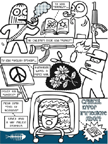
Open Vice/Virtue: The Online Art Context
"The giantism of media corporations and the ongoing deregulation of media consolidation (Ahrens), underscore the critical need for independent media sources. If it were just a matter of which cola to drink, it would not be of much concern, but media corporations control content. In this hyper-mediated age, content -- whether produced by artists or journalists -- crucially affects what people think about and how they understand the world. Content is not impervious to the software, protocols, and chicanery that surround its delivery. It is about time that people interested in independent voices stop believing that laissez faire capitalism is building a better media infrastructure."--Andy Deck
HTTP Gallery is pleased to present Open Vice/Virtue: The Online Art Context a solo show by American artist Andy Deck, as part of NODE.London season. For this, his first exhibition in London UK, Deck uses the Internet, the gallery and public space to challenge corporate control over communication, tools and software, and by extension the social imagination. [Private View: HTTP Gallery 9th March 2006 7-9pm; Exhibition: HTTP Gallery 9th March – 22nd April 2006.]
Glyphiti is an online collaborative drawing project presented uniquely at HTTP. A large-scale projection forms an evolving graffiti wall and visitors to the space are invited to edit and add graphical units or 'glyphs', which compose the image, in real time. The marks made by each person, combine with others and are shown as a time-lapse image stream. Hanging fabrics being shown here for the first time provide a tactile document of recent years’ of Glyphiti. Unlike most image software available on the Internet, Glyphiti functions through most corporate firewalls by using standard Web server requests. For the artist, penetrating firewalls acts as a metaphor to graffiti making: both activities necessitate the appropriation of privatised space for visual play.
Imprimatur consists of an online 'groupware' for poster illustration and layout accessible through a computer workstation installed in the gallery space. Visitors can use the software to create their own poster in collaboration with their online counterparts. This piece provides a framework for visitors/participants to launch a personal poster campaign based on their own social and political concerns. This DIY approach revives the tradition of poster-making as a medium of mass communication and persuasion developed during the 20th century. The posters will by displayed as part of the exhibition and will circulate freely beyond the gallery walls, appearing in surrounding streets, schools, libraries, kitchens and bedrooms.
Panel Junction combines the graphic novel with forms of shared authorship that have been made possible by the Internet. Here the artist selects a few stories emailed to him by visitors from all around the world. Each of the stories is chosen as a sequel to the most recent one and is transformed into a graphic novel by the artist. Hard copies will be available at the HTTP space for visitors.
Andy Deck presents his works at the Science Museum's Dana Centre.
On Wednesday March 8 Andy Deck will be presenting his work at the Science Museum's Dana Centre. The evening will be split into two parts: 17.30 -18.30 Screenings of key interactive works that you can get involved with in real-time, and an informal opportunity to meet the artist with the HTTP Curators, Marc Garret and Ruth Catlow. 19.00 - 20.30 presentation by the artist of his work. Both events will be free and will be in the Dana Centre cafe-bar.
"Leading American artist Andy Deck and HTTP Gallery are important independent voices in the new cultural communication space we call 'the Internet'." - Hannah Redler, Head of Arts Programme, Science Museum.
About Andy Deck: Andy Deck makes public art for the Internet that resists generic categorisation: collaborative drawing spaces, game-like search engines, problematic interfaces, informative art. Deck has made art software since 1990, initially using it to produce short films. Since 1994, he has worked with the Web using the sites artcontext.com and andyland.net. His works have been exhibited at: Art on the Net (Machida City Museum, Tokyo), Net_Condition (ZKM, Karlsruhe, Germany), Ideogram II (Moving Image Gallery, NYC), War Bulletin Board and Mac Classics (Postmaster's Gallery, NYC), Art Entertainment Network (Walker Art Center, Minneapolis), 1998 Prix Ars Electronica (Linz, Austria). Andy studied for a Post-diplôme, at the Ecole Nationale Supérieure des Arts Décoratifs, Paris; and received his MFA in Computer Art at the School of Visual Arts (SVA), NYC. He has taught at the Universidad Internacional Menéndez Pelayo, Sarah Lawrence College, and New York University, and now at SVA.
HTTP [House of Technologically Termed Praxis]
Unit A2 Arena Business Centre
71 Ashfield Rd London N4 1NY
Tel + 44 (0)20 8802 2827 E-mail info[at]http. uk. net
URL http://www.http.uk.net
Posted by jo at 05:45 PM | Comments (0)
Michael Szpakowski

Scenes of Provincial Life
Hi,
I've been making little movies since 2003 now & there's nearly 100 of them. In the meantime vlogging has really taken off, so it seems like a natural thing to present the sequence so far in this format, with any new ones I make in the meantime interspersed amongst the old. For about the next hundred days or so I'll post pretty much everyday and afterwards as and when. You can see the first six (two of which, 'bicycle' & 'counting -cell phone and strings remix', are new) at http://www.somedancersandmusicians.com/vlog/ScenesOfProvincialLife.cgi
If you've enjoyed my work in the past, &/or you like what you see here, maybe you'd like to subscribe: http://feeds.feedburner.com/ScenesOfProvincialLife
best
michael
Posted by jo at 11:50 AM | Comments (0)
IMD Forum Speakers for 2/1/06: Mimi Ito & Daisuke Okabe
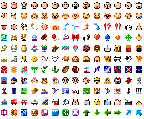
Visual Communication and Co-Presence
Visual Communication and Co-Presence: Camera Phones in Japanese Life; Speakers: Mimi Ito & Daisuke Okabe; Time: Wednesday, February 1, 2006, 6-8pm; Location: USC's Robert Zemeckis Center for Digital Arts (RZC), Room 201 Zemeckis Media Lab (ZML)
Camera phones now represent 3/4 of all mobile phones in use in Japan today. As these devices have merged with existing practices of visual archiving, sharing, and communication, new kinds of technosocial practices have become part of everyday life in urban Japan. We will discuss the current state of camera phone use in Japan based on our ethnographic research, and outline some of the emerging trends for how related technologies and practices seem to be evolving.
Daisuke Okabe, a cognitive psychologist, lecturer at Keio's Keitai Lab and at Yokohama University, has conducted extensive fieldwork on mobile phone and Wi-Fi use. Mizuko Ito is a cultural anthropologist who is interested in how digital media are changing relationships, identities, and communities; she researches new media and mobile phone use at Keio University and the University of Southern California's Annenberg Center for Communication. Both teamed up with Misa Matsuda to edit Personal, Portable, Pedestrian, the first English-language book dedicated to mobile communication use in Japan that was published by MIT Press last summer. [blogged by Scott Fisher on Interactive Media Division Weblog]
Posted by jo at 11:31 AM | Comments (0)
SMS Sugar Man

First Feature Film Shot Entirely on Cellphone Cameras
"...They’ve been shooting for over a week now, mostly nights. Everyone’s dead tired, so this particular scene is taking a bit longer than usual to get in the bag. “Action!” says the director for at least the 20th time in as many minutes, prompting the two female leads to start doing their thing at the pool table. As the girls hit the balls, chat and flirt, their movements are recorded by the cameras embedded in two of Sony Ericsson’s slick new W900i cellphones. That’s right: once this film, SMS Sugar Man (by Aryn Kaganof), is completed, it will be the first feature film in the world to be shot entirely on cellphone cameras...
...SMS Sugar Man is emblematic of what anthropologists refer to as the "leapfrog effect". This is when people in developing nations adopt new technology and use it in ways that allow them to overtake users in developed nations. To extract maximum value from leapfrogging, however, you must be an early adopter.
The ways in which people consume entertainment media are undergoing rapid changes...South Africa...is hungry for new content...The future is right here, right now." From Phoning it in by Ryan Fortune, sundaytimes.co.za (via)
Posted by jo at 11:18 AM | Comments (0)
Marshall McLuhan

tomorrow is our permanent address...
…McLuhan claimed some decades ago but nowadays we are simply already immersed and embedded …Arthur C. Kroker (editor of ctheory) states that we live in the electronic culture that he (McLuhan) prophesied. And since he wrote about it, technology has become more pervasive, but silent. It’s invisible. An elder article (written 2005 to remind McLuhan’s actuality 25 year after his death) gives..(an) overview on McLuhan’s opinions and as well both the enthusiasm and critique his thoughts evoked.
"For the first time, the central nervous system has been 'exteriorized," says Kroker, U Vic's Canada Research Chair in technology, culture and theory. "It is our plight to be processed through the technological simulacrum…in a "technostructure" which is nothing but a vast simulation and amplification of the bodily senses." McLuhan’s early (1960s) wake-up call about the extent to which people’s very identities are determined by the tools that they themselves invent can be listened to via these two links of the old recordings.
The Medium is the Massage; with Marshall McLuhan.
Long-Playing Record 1968.
Produced by John Simon.
Conceived and co-ordinated by Jerome Agel. Written by Marshall McLuhan, Quentin Fiore, and Jerome Agel.
Columbia CS 9501, CL2701.
[posted on mind the_GAP*]
Posted by jo at 11:02 AM | Comments (0)
EnterFrame:
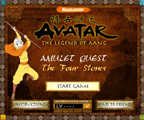
Cage, Deleuze and Macromedia Director
"..Director recasts the information-processing computer as a movie-making machine, or a signification engine bolstered by interactivity that can be mechanically scripted with finite options or driven by the fluid dynamics of video game methodologies. But when one introduces the program to the cinematic philosophy of Gilles Deleuze and the compositional approaches of John Cage it can become something else entirely. When interactive media is introduced to Deleuze's radical theories of cinema-thought and Cageian silence--which can be understood as the dynamics of a system that is left to "be itself"--a sort of "idle" artificial awareness becomes possible...
...In his 1937 essay "The Future of Music," avant-garde composer John Cage wrote that "the 'frame' or fraction of a second, following established film technique, will probably be the basic unit in the measurement of time" as far as the composer of sound was concerned. Cage was already prepared to think in terms of music as cinematic apparatus composed via a system driven by external events and not prescriptions. Cage was prepared to accommodate accident within structure, and was not afraid of electronic instruments. If we switch the phrase "composer of sound" for "author of media" we find ourselves in some version of Cage's predicted frame-driven future. From megahertz to refresh rates, the computing environment is a choreography of events possessing the complexity and precision of a Balinese gamelan, operating at speeds that border on the unimaginable..." From EnterFrame: Cage, Deleuze and Macromedia Director - multimedia authoring software - Evaluation Afterimage, July-August, 2002 , by David Goldberg.
Posted by jo at 10:37 AM | Comments (0)
NODE.London
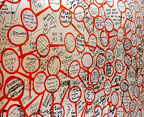
States of Interdependence
There is a Sufi fable in which a group of foreigners sit at breakfast, excitedly discussing their previous night’s exploration. One starts saying “…and what about that great beast we came across in the darkest part of the Jungle? It was like a massive, rough wall.” The others look perplexed. “No it wasn’t!” says one, “It was some kind of python”. “Yeah…” another half-agrees, “…but it also had powerful wings”. The shortest of the group looks bemused- “well it felt like a tree trunk to me.”
This fable aptly illustrates many aspects of the NODE.London experience. The name, which stands for Networked Open Distributed Events in London, indicates the open, lateral structure adopted to develop a season of media arts. It is intentionally extensible, suggesting possible future NODE(s), Rio, Moscow, Mumbai etc. As participants/instigators in the project’s ongoing conceptualization and praxis, we are just two individuals positioned on the interlaced, scale-free networks of NODE.L (more on these later). As such, our descriptions of this collectively authored project are inevitably incomplete and contestable, with a complete picture emerging only in negotiation with others.
Scale-free networks such as the network of Nodes are constantly adopted by NODE.L’s to facilitate the emergence of a grass roots media arts culture in London and in building its own organisational and communication structure. The Internet is a scale-free network. Scale-free networks are described by scientists as maintaining their levels of connectivity regardless of their size. They do this by linking small ‘clusters’ of locally networked nodes to more massively linked hubs, which are in turn connected to each other. Theoretically this allows one to link from one node on a local cluster to another distant, local node with just a couple of steps through the hubs. This creates the “small world” phenomena whereby anyone on the network is felt to be close to any other as well as to the centre." From NODE.London - States of Interdependence, a collaborative text written by Marc Garrett and Ruth Catlow, for "Media Mutandis: A Node.London Reader" (to be published in February 2006).
Posted by jo at 10:29 AM | Comments (0)
Hyperchoreography

Hypertext as a Means for Structuring Digital Dance
"Introduction: In order to produce a dance piece the choreographer must first create a movement vocabulary. Once this selection of movements has been generated, the issue of how to configure the action arises. If the choreographer chooses to move away from the much tried and tested structural forms, what other possibilities exist for these artists?
As we embrace the twenty-first century, the age of interdisciplinary arts, we can see new structuring mechanisms occurring when art forms relate. In this study I will be looking specifically at the blending of literary theory and dance composition, to identify whether the relatively new idea of hypertext, a system for structuring text in a non-linear, interactive form, can credibly be utilised as a means of structuring digital dance. My research which shall employ both print media and hypermedia, in the form of online articles and hypertext systems, will be led by the questions that I have encountered throughout my own investigative process and that of others." From Hypertext as a Structuring System Within a Digital Choreographic Context, by Charlotte Miles, University College Chichester, May 2005. [via Hyperchoreography]
Posted by jo at 09:49 AM | Comments (0)
A Node Within a Network:
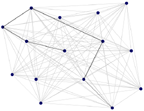
An Examination of Online Dance
"Abstract: The essay's opening section identifies the pioneering photographic work of Eadweard Muybridge as a catalyst for development in the cinema and technological industries during the twentieth century. This section also examines how key developments in both of these spheres, such as the emergence of a body of screen-specific dance work, and the growth of digital and new media arts practices, have fed into the genesis of online dance work as a potentially distinct genre. These elements are also examined in relation to the creation of Motion Studies (2003).
The essay's second section begins the process of inquiry into the nature of online dance work utilising a set of criteria developed by U.K. based choreographer Richard Lord. Using these criteria, a range of online dance content, such as promotional websites, webcasting and information databases are examined. These, however, ultimately fail to conform to the requirements for categorisation as online dance work. Five dance works created for Internet-specific presentation by British and U.S. artists are also examined and analysed as a means of determining properties or approaches common to the creation of online dance. The practical, artistic and technical issues involved in the creation of Motion Studies are also outlined in this section, including discussion of the role of the choreographer within current practice, and the importance of improvisation as an element within the piece.
The next section locates Motion Studies within the theoretical context of Donna Haraway's writings on feminism and the applications of advanced technologies, as outlined in Simians, Cyborgs and Women (1991). Haraway's concept of cyborg imagery is also examined in relation to the experience of choreographing and viewing Motion Studies, with a further examination of the enabling potential of technology as it relates to the creation and experience of viewing dance work. Wider issues in the current debate surrounding the use of technology in dance, as put forward by Don Ihde, Susan Kozel and Sherril Dodds, are also discussed.
In the essay's final section, a range of barriers to the creation of online work, such as lack of specialist technical skills within the dance community; the difficulties of attracting audiences, and the current emphasis on the commodification of dance, are examined. The issue of categorisation of online work is revisited, identifying several trends and similarities from within the sample study group, subsequently reaching the conclusion that it may not currently be helpful to insist on too rigid a definition of this type of work at such an early stage of its development. The essay concludes with a final evaluation of the processes involved in the creation of Motion Studies." From A node within a network: an examination of online dance work with particular reference to Motion Studies by Chirstinn Whyte (2003) [via Hyperchoreography]
Posted by jo at 09:42 AM | Comments (0)
Death of the Author

The Return of the Author
"Abstract: The article transposes the text of Roland Barthes' "Death of the Author," (La Mort de L’auteur) (1968), to the arena of happenings in cyberspace, and examines the implications from the point of view of author-reader-text, active in the electronic environment. Cyberspace has become one united text (hypertext), that allows any author to add to it, and any reader to read the content. The act of reading the text from the network simulates the cyberspace hyper-text wave function collapsing by means of the reader’s submitted query. The text that was in a state of superposition throughout the network, or in Barthes’ definition "multi-dimensional space in which many and varied writings are combined and meet, and none are foremost" becomes a single peak wave function that appears on the reader’s display. Cyberspace accelerated the reading process to the speed of light, and led to a dramatic turning point of the disappearing of the traditional author, text, and reader, and the birth of the new Super-Reader-Author. This unification creates a paradigmatic shift from dualistic, Aristotelian object-subject thought, to the holistic thought of being, realized in the singularity of consciousness and connecting real space, the spiritual and cyberspace." The Return of the Author, Avi Rosen, December 2005.
Posted by jo at 09:08 AM | Comments (0)
Speak Softly
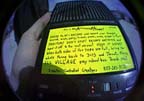
Automated Hobo Recording Project
This image is from the California high-desert bacchanal Burning Man, during which Mark G. circulated Automated Hobo, a sound-harvesting experiment using cheap tape recorders and hand-written instructions.
I purchase cheap tape recorders at thrift stores and wherever, load them with batteries and blank tape, and write instructions on the outside that tell people to record something and then pass it on to someone else. When the tape’s full, return it back to me. I figured that since Burning Man emphasizes participation over spectatorship, I might get better response than I have in the past. I was right — three out of four recorders came back, and the highlights can be heard here.
Mark G. is with Evolution Controlled Creations (a.k.a. the intellectual-property renegade band Evolution Control Committee). Automated Hobo MP3 files are available for download, although apparently they are from 2000, while the photo is from a more recent festival. Recordings from the project have also been broadcast - knowing ECC they may also have been sampled into current or forthcoming musix.
One of the interesting aspects of found-sound is its uncontrolled nature… one can imagine a similar process whose intermediate point is a speech-to-text system. What wild writings and miswritings might emerge from the text-to-speech transcript of an itinerant tape recording? [blogged by Jeremy Douglass on WRT]
Posted by jo at 08:49 AM | Comments (0)
Nam June Paik
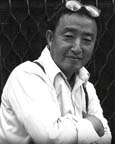
Paik, Pioneer of Video Art, Dead at 74
"Nam June Paik, the Korean-born artist and composer regarded as the inventor of video art, died Sunday of natural causes at his Miami home. He was 74. Paik is thought to have coined the terms "information superhighway" and "the future is now," as well as having global influence with his work.
Paik's art combined the use of music, video images and sculptures in a way that set the style for future video artists. "Paik's work would have a profound and sustained impact on the media culture of the late 20th century; his remarkable career witnessed and influenced the redefinition of broadcast television and transformation of video into an artist's medium," John Hanhardt, media arts curator at New York's Guggenheim Museum of Art, said in a statement.
"Through a vast array of installations, videotapes, global television productions, films, and performances, Paik has reshaped our perceptions of the temporal image in contemporary art," Hanhardt added." From Paik, pioneer of video art, dead at 74 CBC.CA.
Posted by jo at 08:21 AM | Comments (0)
January 30, 2006
Jason Bruges Studio
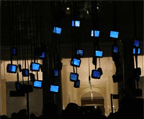
PSP Image Cloud
Unique content was driven through a PSP and split across an array of organically arranged screens.
...Jason Bruges Studio created a chandelier (PSP Image Cloud) with 50 small TFT screens hanging from it. They created video content for a PSP, which was then broken up via a grid on to each of the small screens. The PSP video was then fed into a computer, where Isadora software was used to split the signal into components, through multiple outputs and up to the chandelier. Here are my Flickr Photos and a quick poor quality video (962kb).
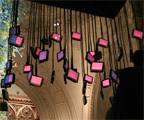
Also Playstation promotions staff were on hand to give you a demo of the PSP, plus lending out PSPs to play with exclusive content. Designers Intro were running a workshop studying unconcious explorations of mind mapping and thought patterning. There were animation screenings and short films, plus four literary walks through the V&A organised by Zembla Magazine.
Missed it? BBC2 were filming and will be showing the event on the Culture Show, Feb 16th at 7pm... [blogged by Chris on Pixelsumo]
Posted by jo at 03:04 PM | Comments (0)
Lauren Cornell Interviews

MTAA
Artists M. River and T. Whid formed MTAA in 1996 and soon after began to explore the internet as a medium for public art. The duo's exhibition history includes group shows and screenings at The New Museum of Contemporary Art, Postmasters Gallery and Artists Space, all in New York City, and at The Getty Research Institute in Los Angeles. International exhibitions include the Seoul Net & Film Festival in Korea and Videozone2 - The 2nd International Video Art Biennial in Israel. In the forthcoming New Media Art (Taschen, 2006), authors Mark Tribe and Reena Jana describe MTAA's 1 year performance video (aka samHsiehUpdate) as "a deftly transparent demonstration of new media's ability to manipulate our perceptions of time." The collaboration has also earned grants and awards from Rhizome.org, Eyebeam, New Radio & Performing Arts, Inc. and The Whitney Museum's Artport web site.
LAUREN CORNELL: Can you tell me a little bit about your net art pre-history, and how you met and started collaborating?
M. RIVER: I began working with performance and collaboration in grad school at Cranbrook (outside of Detroit). Driving North nonstop for 4 days until the road runs out, breaking into stranger's yards and mowing their lawns, backyard camping at mansions-my friends and I did these things together and called it "Art." It felt like 'odd sculpture' for me then. What I do with Tim in MTAA often reminds me of that feeling. From Cranbrook, I headed blindly to Brooklyn where coincidentally, Tim had also just moved. One day Tim called and asked if I wanted to collaborate on some paintings. I said, "Yes." And we've been working together under the name MTAA since.
T. WHID: I was working exclusively on underground comics, but I wanted to work on a painting. First I called a mutual friend to see if he wanted to collaborate. He declined but suggested I call M. since he had some canvasses stretched. We both thought the collaboration successful and continued working together.
LC: Something distinctive to me about MTAA is the heavy ratio of youthfulness you bring to everything. The voice that broadcasts out of your work or your blog is one that is always questioning and critical, and sometimes feels as angry as your average 16-year-old punk. You?ve told me before that people found you aggressive or crude. Do you find your attitude clashes with larger new media mores or manners?
MR: I think it is important to note that MTAA is performed. In MTAA, I work under the name "Mark River." This is not my name. (It's Michael Sarff-for the Rhizome record.) The M. River voice - in our work or on our blog - is not exactly mine. It's something used to create a world. Yes, you might read it as a world full of young DIY punks who want to tear things down and build new things up, but I'm not sure if that?s what our voice is all about in the end. I also think our voice has a little more depth than your average 16-year-old. (Then again...)
I do think our voice sometimes rubs people the wrong way. I'm not sure why. It might be that people feel more comfortable with art that's aloof. Humor doesn't always play well in the art world. As for aggressive or crude, I personally would like to see more "R" and "NC-17" new media and net artworks. Not that I would like everything to be blood and guts or that Tim and I strive for that in our work. I just feel that we need to get over the Science Fair default values of computer art. It's boring. That?s my 16 year old boy answer. That and I "heart" JODI. As for MTAA brawls, no, we get along swell.
TW: Hmmm. Am I totally deluded in not really seeing myself that way. I do think that a lot of new media curators don't see our work in the "big story." The problem with the new media art establishment is that it?s based too much in academia (since there isn't much of a market). Our voice, compared to this academic voice, might seem immature or angry, but in my opinion, it's just normal. Anyway, we're old fogies compared to the likes of Cory Arcangel and Paper Rad.
LC: Both of you have been involved with Rhizome since its beginning. As my job now involves mapping Rhizome's future (in collaboration with my colleagues, and the broader Rhiz network of course), I find myself constantly considering the organization's history: how it has grown, and made efforts to adapt to the changing conditions of the web, and concurrently, to internet art and new media.
Now, Rhizome's constituency is very broad. But, when it first started as a mailing list, it was quite small. People talk to me a lot about these early days during which net art belonged to an avant-garde of first adopters, an avant-garde that Rhizome, and other platforms like Nettime and the Thing, were home to. What was your impression of Rhizome, and its community, at that time?
MR: Just to skip down to the bottom line, I think people participating on Rhizome specifically, and the net in general, tended to experiment more in the beginning. Luckily, play and experimentation seem to be part of net's heart, so new weird things still show up.
TW: Rhizome was the first place that I found online where people talked about art and took it seriously. At first I remember being confused by the whole net art thing. I remember a contest to crown "Mr. Net Art" (I think Robin Murphy won). I was also confused by Robin's wrestling posts (do a deep Rhizome search for that one). I lurked for a long time before I took part in the discussion, then it was mostly "Direct To Your Home Art Pojects" (http://mteww.com/dyhap) emails.
LC: Who did you admire then, or whose work informed yours?
MR: I was looking at works by the original "net.artists" (JODI, Shulgin, Lialina, Cosic, etc) as well as Potatoland, Fakeshop, hell.com, Murph the surf, meiko and ryu, one38, Kanarek's World of Awe, restlessculture, the McCoys, GH, eToy, 01etc, Pavu, RSG, EDT, Wolfgang, blackhawk and Mouchette. It seems like I could on for a long time with this list but these are some names that jumped up.
LC: That seems like a very heady, and exciting time, those were the first artists to hash out Internet art as a form. No wonder you made the switch from painting and comics. What kind of work were you making at the time?
TW: Our first piece for the web was "Buying Time: The Nostalgia Free History Sale" (http://www.creativetime.org/programs/archive/1997/buytime/buytime.html). We didn't even have a computer when we started this project. We did it at Creative Time's offices (I remember not knowing what an HTML comment was). After that we used Rhizome and other email lists as a platform for the "Direct To Your Home Art Projects" (http://www.mteww.com/dyhap/) which was our second online project.
LC: With Both "Buying Time" and "Direct To Your Home Art Projects," and later works, you translate Fluxus, or conceptual art practices, to the web.
In your piece, "Five Small Videos..," you perform the repetitive gestures and everyday actions found in early video performances. Are these projects part of a larger interest or desire to situate net art within a larger historical art practice, or alternately, to see how particular art projects/movements translate online?
MR: For me, it is more B than A. Start with an understood set of rules or contexts. Once these rules and contexts move online or become automated within a computer, the results begin to distort. Although, I do not feel distortion is really our end goal.
Translation is the tricky word here. When you translate, you hope the meaning stays the same. I think the meaning of a work like "1YPV" is different than Teching Hesh's work upon which it's based. It's not just the difference in the mechanics of the work; it's a change of message.
TW: Part of our M.O. has been to situate our practice very clearly in art historical traditions. It was obvious to us very early on that the real power of the net was about information and interaction between individuals (as opposed to pretty moving pictures weeeeeee).
Creating art from interactions between individuals or purely out of information was nothing new to art. It felt natural to follow in this tradition.
LC: Throughout your work, you seem interested in illuminating the relationship between the artist and the audience, and by doing so, you often throw your artistic process into relief. What is your interest in visualizing these relationships? MTAA's, and the one you hold with your audience?
TW: Er, can I pass on this question?
MR: It's funny. Tim and I both have this deep interest in how people and groups communicate, but we don't talk about the "why" very much.
I think Tim's interest could be tagged as political. Mine? It's hard say.
We meet in a restaurant in Brooklyn. You ask us some questions. A few months later, you email us some more questions. Tim and I respond to the questions separately and then join the answers together. A friend edits the text. We send it all back to you.
You join all the text together in some manner. You place the text on the net for people to read and comment on. This is like our work - an imperfect group dialogue in which the process and misunderstandings might add up to some new meaning. This might be what interests me.
LC: Your works often have on off-line component, though they start with the web. In the case of "MITD" (http://lifeofmo.blogspot.com/2005/12/we-are-all-together-update.html), the piece started online, with viewers voting on which random bad art idea of yours you should make, and ended with you manifesting the piece in Artist Space. Does the nature of your work change substantially when it moves in between on and offline spaces?
MR: We've made net projects that move to installations, say "1YPV." We have installations that move onto the web, say "KDM100" (coming to a browser near you in 2006). In both cases, some details change in the move. Works like ?MITD? or "Printer Tree" are a bit different. They stand in both worlds. They make an arc from net to physical space. Both ends of this arc make the work.
TW: A lot of times the offline components are simply reformatted for the gallery space. For example, "1YPV (Gallery Version)" uses some of the same software as web version. It has the same video - but at a higher quality. In the case of "MITD," the piece itself is comprised of 3 components (a web page, a video and a sculpture). So, the nature of that piece is significantly different from "1YPV". It's more of an old school process piece, which happens to use the web and digital video.
LC: The years worth of XML code was an ingenious way to make your piece 1 Year Performance Video tangible and also marketable. I'm wondering if you ever imagine being able to quit your day jobs and be supported by your art?
MR: Strange. I never know what to make of this question. I think this might be the fourth or fifth time we've been asked in an interview or lecture about quitting our day jobs. The first thing I always feel is, "Gee" is their something you're not telling me? This thought is followed by, "I wonder if everyone gets this question?" Then, I tell myself, "No, everyone does not get this question." This thought always leads to, "Ya know, I don't care" Okay, maybe I do care, but not right now. In the end, I always look up with a dumb smile and say, "Yeah, sure. Why not" I say this because I think it's what you need me to say.
TW: Practically speaking, it would be harder for us to support ourselves as a partnership than it would for an artist working alone. We need twice the income. Theoretically, since there are two of us, we should be able to make twice the amount of art as a single artist. But the reality is that we?re lazy, so it takes two of us to produce the same amount of art as one hard-working artist.
LC: Tim, you were kind enough to make time to come and talk to the local television news station NY1 when they taped the Rhizome ArtBase 101 exhibition at the New Museum of Contemporary Art this summer. I remember I talked to them first, and gave them a pretty rote explanation of the show. (I was trying to keep it simple and sound-bytey so my main points would stay in tact.) I was really amazed at how bold your comments were. As I recall, you started talking about how other art forms were "dead media" and that net art was the art form of "the future". This was, of course, complemented by the fact that your red t-shirt made you look like a communist. Do you really believe in Internet-based art?s ascension as a medium?
TW: Yes. But I didn't mean just Internet-based art, but all digital/new media art. In any case, when artwork becomes digital, why shouldn't it be networked? Perhaps the distinction is meaningless.
LC: A question of terminology: MTAA describes its work as "net art" but surely you've noticed that people have decried "net art" dead or "over", a chapter that is now closed, etc. To me, it seems that terms like net art must be?to a certain extent?dealt with like terms such as feminism which are interpreted differently by different people in different contexts. What is your definition of net art ? and how does it relate to what you do?
MR: I guess this is the point to drag out Ye Ol' Simple Net Art Diagram (http://www.mteww.com/mtaaRR/off-line_art/snad.html) and the Abe Linkin's remix of it (http://www.linkoln.net/complex/). I'm fine with leaving terms like "net art" or "feminism" linked to certain classic moments, groups, and stances as long as people agree on the context. Not agreeing on the context leads to the same old arguments. It's like when "conceptual art" and "conceptual art" get hashed out over and over again. The other thing, of course, is that we can use "net art" or "feminism' to refer to a past set of ideals-but that doesn't exclude it from being an ongoing and evolving practice. Examples? RSS feeds or Le Tigre.
TW: My definition of net art is any art work that uses a network as an integral part of its medium. I'm really a modernist at heart (I'll just speak for myself) in that I believe that artwork should somehow marry its form, content, and subject. If you're using the Internet to make art, then the art should somehow use the network. If your work is a JPEG that would look just as good (or perhaps better) printed and hung on a wall, then it's not net art because it's not using the medium of the network.
But these definitions can change quickly. For example, XML feeds are altering the way media files are distributed over the web. If you take a series of JPEGs (or MP3s, or MPEGs) and create a feed and distribute them over time, then suddenly you're using the network and it could be net art (as opposed to digital photography or whatever).
LC: With another one of your works "To Be Listened to" (http://mteww.com./rhiz05/), it appears that you?ve jumped on the podcasting wagon?or were you riding in it before? Can you talk a bit about this piece?
MR: "To Be Listened to" (2bL2) in someways, continues the methods we used in ?Pirated Movie? (http://www.mteww.com/mtaaRR/off-line_art/Pirated_Movie.html) or "V-TAV" (http://www.mteww.com/VTAV/). We create a shell to distribute work and ask artists we like to provide the content. think 2bL2 will differ in that the shell created will allow listeners to organize as ell as participate in the work. What T.Whid talks to me about for 2bL2?s structure is a small remix and rate community. I think this is why we are dragging our feet on this one. We don?t want it to be another podcast.
TW: And that means we need more money too!:-)
LC: What does MTAA have to look forward to in 2006? Any New Years resolutions? As MTAA seems to wear its collective heart on its sleeve, I'm sure you won't mind sharing.
TW: We have plans to put "Karaoke DeathMatch 100" (http://www.mteww.com/mtaaRR/news/twhid/what_is_karaoke_deathmatch_100.html) online as a video blog and feed (URL to come, stay tuned). We've also received a grant to do a big piece that is going in a gallery somewhere (and still be net art). And our Rhizome commission, "To Be Listened to" of course.
MR: When we began working with the net it was easy to knockout a work. One good weekend together and a project could be done. Now, the scale is larger and the timeframe longer. We are looking at one big monster of a project this year, and it?s giving me the willies. I hope it turns out. I also hope we find time for the smaller scale projects. I find the small projects can be a place for the experimentation needed to drive the larger works.
As for the personal heart-on-the-sleeve in 06, or at least what "M. River' might have for a heart, I just don?t know. I?d like to give those choices for change away this year. Send me an email. Tell me how to live a better life. Send to mriver[at]mteww.com subject head: "m.river resolution 06." Best resolutions go on the blog.
+ + +
LINKS:
+ http://www.mteww.com/mtaaRR/off-line_art/snad.html
+ http://www.linkoln.net/complex/
+ http://mteww.com./rhiz05/
+ http://www.mteww.com/mtaaRR/off-line_art/Pirated_Movie.html
+ http://www.mteww.com/VTAV/
+ http://www.mteww.com/mtaaRR/news/twhid/what_is_karaoke_deathmatch_100.html
[via Rhizome]
Posted by jo at 11:14 AM | Comments (0)
Version>06
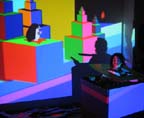
Parallel Cities
April 20- May 6, 2006 Chicago U$A; DEADLINE FOR PROPOSALS: FEB 28, 2005: Version is a hybrid festival focused on emerging discourses and practices evolving between art, technology and social and political activism. Version examines the activities of local configurations and external networks that use visual and conceptual art strategies, innovative social practices, creative uses of new technologies, organizing strategies, emerging activist/artist initiatives, campaigns, public interventions and DIY projects.
During this annual convergence we engage in a dialogue about the possible futures ahead that may interdict or provide alternatives to current social, cultural and political trajectories. Version>06 is our fifth convergence and is dedicated to the theme of Parallel Cities. We will investigate and share local strategies and models to inspire action within local and global counter cartographies.
We will convene in Chicago for a seventeen day open laboratory to explore a diversity of tactics and strategies to activate our communities and amplify our ideas and practices. Alternative spaces will be open for staging actions. Public spaces and corporate places will be terrains of intervention.
Version presents a very diverse program of activities featuring an experimental art exposition, artistic disturbances, exhibitions, networked urban events, screenings, interactive applications, performances, street art, presentations, talks, workshops, art rendez-vous, parties, and action.
By bringing together a convergence of allied cultural and social forces and practices we hope that Version can help establish new methodologies and networks of cooperation. Representatives from other cities are invited to present their local counter cartographies as we reveal our own. We want to share your everyday micro actions as well as conceptual and practical projects and activities that can help us to transform personal and shared environments. We want to examine and showcase projects that can be duplicated in our urban environments. We want to hear stories of victories, large and small in making a difference in the various communities that we inhabit. We want to wage the culture war with fresh tactics and renewed energy.
Please visit http://adoptanamerican.com/version06 to use the online submission form.
Alternatively you may mail your proposals to:
Version>06
960 W 31st St
Chicago Il 60608
Posted by jo at 10:07 AM | Comments (0)
The Perpetual Art Machine
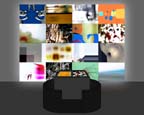
Invitation to Participate
Cinema-scope and IFAC are seeking video art submissions for: PAM - The Perpetual Art Machine to be premiered as a featured project at the -Scope New York Art Fair March 10-13, 2006.
PAM is an interactive video display installation and network designed to aid in the curatorial process by allowing artists and the viewer to play a more active roll in its outcome. PAM is an international survey of cutting edge and progressive film, video and new media art. PAM is looking for looking for screen based works up to three minutes in length and created after 2001. Writers and Curators encouraged to take part as well. Deadline: February 20, 2006, sooner the better.
Step 1: Register at http://www.perpetualartmchine.com. Once you have received your confirmation you will be able to set up your profile (contact, bio, etc) and have access to other community tools in the site.
Step 2: Submit Your Video
NTSC video only (Quicktime .MOV or .MPEG or DVD)
Best case rendering:
Quicktime, 16-bit Integer (Big Endian), Stereo (L R), 44.100 kHz, Photo - JPEG, 720 x 480, Color, Medium Quality, 15fps.
Include five keywords that describe your piece. Please have disk and materials properly marked with artist name and artwork information, Name, year, duration.
There are three ways to submit your video.
Mail your on CD or DVD to:
Lee Wells (IFAC) c/o NYCRS
462 Broadway Suite 540
New York, NY 10013
T 917 723 2524
OR
Email us a link to your high resolution video at perpetua[at]perpetualartmachine.com. Please include the five keywords describing your piece
OR
Login to post your video directly to the Perpetual Art Machine website.
Please include a self addressed stamped envelop if you would like your entry returned.
Please contact us if you have any question at perpetua[at]perpetualartmachine.com or by phone at 917 723 2524.
Lee Wells
Brooklyn, NY 11222
http://www.leewells.org
917 723 2524
Posted by jo at 10:01 AM | Comments (0)
Avatars Among Us
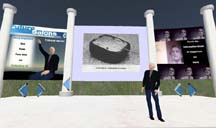
Breathing a Second Life into the Keynote
"DEMOCRACY ISLAND -- There are certainly more glamorous ways to spend a Friday night than watching an animated version of a computer engineer discuss approaches to harnessing collective intelligence. But, for more than 25 people who showed up here last week to hear computing pioneer Douglas Engelbart address a Silicon Valley futurist group, the promise of intellectual stimulation prevailed.
In exchange for insights on the concept of the dynamic knowledge repository, audience members watched a speech delivered by a gray-haired, suit-and-tie clad avatar bearing a more than passable resemblance to the man best known for inventing the computer mouse. The talk, held at a virtual locale known as Democracy Island in the multiplayer online world Second Life, drew a less realistic audience. Some in the crowd weren't even human, sporting features like antennae, fur and wings..." From Avatars Among Us by Joanna Glasner, Wired.
Related: Lessig in Second Life

and Letters From Second Life [blogged by ray cha on Future of the Book]
as well as Giving a PowerPoint Presentation in Second Life.
Posted by jo at 09:50 AM | Comments (0)
Japanese Contemporary Dance Scene
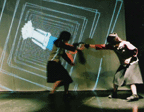
Dance and Technology, 2005
[posted by Yukihiko YOSHIDA] The most well-known video dance in TOKYO last year was "Chocolate" by Bokubroll (unit, Nibroll plus Boku-death). The work started with CG like Japanimation and sentimental music. Bodies in this work were choreographed by Mikuni Yanaihara. Dance critic, Yukito Kado called her movement "anti-modern dance complex." As he said, "Yanaihara sometimes rejects the traditional form of modern dance skillfully." At the same stage, an Australian dancer Luke George performed. The projected CG was the images of cow, the stereotype of Australia. The mood got better in this stage. As other groups, cell/66b did an excellent work. Tetsu, their video artist would be the best artist in this field. They used to work in Japan and Australia. Thus, their work also has trans-cultural background.
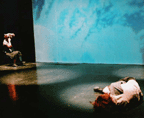
It can be said that “transculture” would be a keyword in Japanese dance scene. In addition, Sal Vanilla performed in Yokohama again. They had not been performed in Japan for years. The performers of Sal Vanilla are mainly from Butoh. Their works have environmental element and computer animations are projected to their body and whole space. Some Japanese artists try to choreograph body in space in the field of space development. They collaborate with JAXA (Japan Aerospace Exploration Agency). As a successful example, Japanese choreographer, Setsuko Ishiguro choreographed her work, “Hi-ten” (flying high sky) and released last year. In the field of communication technologies, the cell phone itself has been developing. In Akihabara, the image of Japanese animation character is in trend.
Photo: Nibroll, "Chocolate" by Takahashi (Nibroll)
Nibroll http://www.nibroll.com/
Sal Vanilla http://www.salvanilla.com/
JAXA: http://www.jaxa.jp/index_e.html
[posted by Yukihiko YOSHIDA]
Posted by jo at 09:42 AM | Comments (0)
NEVEL
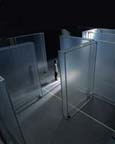
Moving Labyrinth at ARTEFACT
NEVEL, by Lawrence Malstaf, is a moving labyrinth (11 X 11 m) consisting of 9 programmable walls able to rotate 360° and react to the presence of the visitors, determining their route. Architecture comes alive, walls become doors, spaces open and close, visitors are locked up, desoriented and set free again.
Performers, visitors and their shadow are part of a tablaux vivant set for each other. The space itself is turned into an actor in the performance. An abstract place in to go astray like in a mutating city.
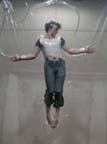
During the ARTEFACT festival that runs from February 13 till 18 in Leuven (Belgium), four artists / scientists will get to work with or within NEVEL and create new presentation forms and performances. For the festival, artists and scientists will research space, place & distance and translate it into new forms.
There's more about Malstaf and his works (which include curiosities such as Shrink, a 1995 installation inviting visitors to be vacuum-packed in plastic, with only an air bubble through which to breathe, picture on the right) in kopenhagen.dk and Frame magazine. [blogged by Regine on we-make-money-not-art]
Posted by jo at 08:34 AM | Comments (0)
Types and Challenges of Motion Tracking Systems
Matt Gough in his Splines in Space blog has two entries about the motion tracking and capture system he uses for his dance research and composition - Motion Capture (Dance) and Noodle Dance.
Matt describes the different types of motion tracking technology (Magnetic, Gyroscopic and Optical) and points out the challenges of tracking large numbers of discrete body movements. Ideally, he'd like to have a dancer outfitted with 100 plus markers and more computer power to process results in real-time.
An image that displays results of 1:41 minutes of motion tracking - "The Noodle Dance":
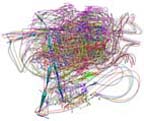
Using a passive optical motion tracking system with markers that are placed on the dancer's hands and body:
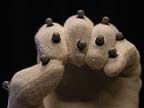
This area of motion tracking systems and dance movement - both for research and performance - is an area I plan to do a lot more interviews about both for my audio podcasts and upcoming publication. [blogged by Doug Fox on Great Dance]
See Motion Capture by Maureen Furniss and mocap notes ii.
Posted by jo at 07:44 AM | Comments (0)
January 27, 2006
Finger Ring
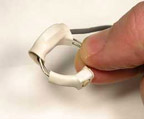
Social Polling
Finger Ring is a system in which a cell phone decides whether to ring by accepting votes from the others in a conversation with the called party. When a call comes in, your phone first determines who you're discussing with by using a decentralized network of autonomous body-worn sensor nodes. It then vibrates all participants' wireless finger rings.
Although the alerted people do not know if it is their own phones that are about to interrupt, each of them has the possibility to veto the call anonymously by touching his/her finger ring. If no one vetoes, your phone rings.
Other Ring Phone concepts: The Finger Phone - The Finger Phone is a small bluetooth headset that you can wear like a ring. It remains connected to your cell phone through bluetooth; Technojewelry - Penta Phone, Ring Phone and GPS Toes - Technojewelry for IDEO incorporates emerging electronics into everyday attire. Penta Phone and Ring Phone are concepts for mobile phones; The ring phone concept - A mobile phone encapsulated into a ring you wear on the finger, won the 2004 Sony Ericsson Phone Concept Design Competition in China; The Ring Phone - The winning submission for the "2004 Siemens Design Challenge"was a phone consisting of two finger rings, one ring for listening and one for speaking. [blogged by Emily on Textually]
Posted by jo at 03:56 PM | Comments (0)
Wireless Networking in the Developing World
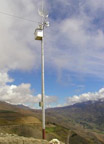
HOWTO
A new free book delivers a complete HOWTO for assembling and maintaining wireless networks in rural towns in developing countries. Wireless Networking in the Developing World was co-written by some of the world's leading community wireless experts, including Rob Flickenger, who wrote O'Reilly's seminal Building Community Wireless Networks and Wireless Hacks, wire.less.dk's Tomas Krag, and numerous wireless hackers of great skill and repute. Many of the contributors have built and deployed networks in the developing world, and they have released the whole text under a very liberal Creative Commons license that encourages others to build on their work and profit from it.
In almost every village, town, or city in the developing world, there are people who can build just about anything. With the right know-how, this can include wireless networks that connect their community to the Internet. The book addresses what Rob Flickenger, the book's editor and lead author, calls a chicken-and-egg problem: "While much information about building wireless networks can be found on-line, that presents a problem for people in areas with little or no connectivity", said Flickenger from his workshop in Seattle.
The book covers topics from basic radio physics and network design to equipment and troubleshooting. It is intended to be a comprehensive resource for technologists in the developing world, providing the critical information that they need to build networks. This includes specific examples, diagrams and calculations, which are intended to help building wireless networks without requiring access to the Internet.
In the developing world, one book can often be a library, and to a techie this book may well be a bible. Access to books is difficult where there are few libraries or book stores, and there is often little money to pay for them. "Our book will be released under a Creative Commons license, so everybody can copy and distribute it free of charge. That doesn't mean it is a 'cheap' book. I think it is a great book," stated Corinna 'Elektra' Aichele, one of the books co-authors who was recently installing wireless networks in Bangladesh. [posted by Cory Doctorow on Boing Boing]
Posted by jo at 03:16 PM | Comments (0)
Anne Galloway
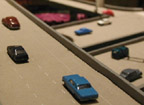
On Spatial Annotation
I'm really looking forward to being a guest lecturer in the Contemporary Architecture Discourse Colloquium at Yale School of Architecture on March 31st. This is what I'll be talking about:
LOCATION-AWARE TECHNOLOGIES, SPATIAL-ANNOTATION, AND THE FATE OF URBAN COMMUNITY
Location-aware technologies such as GPS and RFID are increasingly being used for a variety of European and North American urban spatial-annotation projects. These desires to “tag” the world-around-us, I argue, can be understood as particular intensifications and materialisations of Western political longings for unified community in times of fragmentation and diversity. But what senses of belonging are we presupposing when we attempt to bind collective memories to singular places? And what kind of community is possible when the technologies and protocols that underpin such projects may be understood, following Mackenzie, as “kludge” or an “ill-assorted collection of poorly matching parts, forming a distressing whole”? Borrowing concepts from Giorgio Agamben, Jean-Luc Nancy and Marc Augé, I explore tensions between mobility and dwelling, difference and commonality, memory and forgetting. Accordingly, questions concerning political and ethical participation, and the role of affective encounters such as alignments, identifications and appropriations take on special force. Ultimately, it is my position that any kind of technologically-enabled communalism or collective memory that privileges unity and order threatens to undermine the senses of contingency and potentiality necessary for a politics of hope in everyday urban life.
And on a related note, NY Times: Making Connections, Here and Now
"These [mobile social software] programs are in their infancy, now being used mainly by technology aficionados, but their potential is vast. In the future, users may subscribe to the mobile posts of bloggers who review neighborhood lunch spots or to business travelers who share city-specific survival tips."
Vast potential, eh? My god, we're dull.
I continue to be impressed that projects like Urban Tapestries led to projects like Social Tapestries, while Dodgeball was "acquired" by Google. [blogged by Anne on Purse Lips Square Jaw]
Posted by jo at 02:56 PM | Comments (0)
NYT on Location-Based Services

Making Connections, Here and Now
The NYT features a smart article about location-based services (By ETHAN TODRAS-WHITEHILL). Well-known projects like Dodgeball, Yellow Arrow, Social Light, Rabble, Street Hive or Rave Wireles are presented.
Mostly, those systems allow proximity-based interaction (ping registered participants when participants/friends are in the vicinity) or location-based annotations/blogging (i.e virtual post-its)… allowing the so-called “geospatial Web, the Internet overlaid on the real world”. Food for thought certainly for the current vocabulary disambiguation!
The article raises the issue of location-awareness, be it passive or active as they call it:
What the industry calls passive location awareness on the part of cellphones is critical to growth in mobile social software. It simply means that a phone knows where it is because it is equipped with technology like a Global Positioning System. Most current location-based services do not automatically keep track of where you are; you need to tell them by sending a text message. Passive awareness in your cellphone, by contrast, lets sites like Socialight or Dodgeball keep track of where you are all the time and send you relevant information posted by others.
But getting passive awareness on your phone is not easy.
(…)
cellphone users are suspicious of passive location awareness because they do not want to get unsolicited location-based text messages, or geospam, from advertisers as they pass stores.
Besides, the conclusion is very interesting:
As for other mobile social programs, a press officer for Verizon Wireless suggested that in the future the company might let its customers use such services through an off-network, “trusted content provider” model.
And geospam? It may actually materialize, and even the developers of mobile software are not thrilled by the idea.
“The billboards are already there,” said Mr. Allen of Yellow Arrow. “I don’t need a message in my pocket to tell me McDonald’s is around the corner.”
So true…[blogged by nicolas on pasta and vinegar]
Posted by jo at 02:49 PM | Comments (0)
Anne Galloway
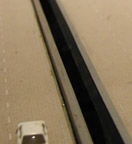
Against Disambiguation
In Disambiguating the terminology (a sketch), Mike writes:
'As I see it, the different terms--pervasive computing, ubiquitous computing, ambient intelligence and physical computing--come from different historical contexts that are based on geography: PARC coined "ubiquitous computing," so it's big on the West Coast; IBM likes "pervasive," they get the East; Philips was responsible for "ambient intelligence," so that's what it's called in Europe. In reality, it's just a blind men and elephant problem. They're all describing the same idea, but alliances and territoriality create clusters of terminology...The definitions aren't totally separate, but it's an interesting exercise to see the focus of the groups who fly a particular flag. I still think it's all the same elephant and that maybe it needs an even yet different term. There's great value in creating a good term that encapsulates a set of ideas, but it has to accurately capture the essense of an idea as it is perceived by others to take off. Which means it needs to be externally-focused, and not about the process.'
And in the comments:
AG: Why do you think I felt it necessary to create a whole new term for these activities, even at the risk of collapsing valid distinctions?...[I] argue that even things that seem peripheral to the ubicomp argument...will in fact be for most of the people experiencing it the signifiers of the ubiquitous experience.
Mike: If people's associations with it are going to be with the objects, not the ideas, I believe that names for the idea should reflect THEIR perspective.
The elephant analogy doesn't sit well with me if it implies that there is, in fact, a stable thing-in-the-world that constitutes an elephant (and that the men are wrong because they don't know they're describing the same thing). As I understand it, the parable's moral is rather about not clinging too hard to any particular perspective because there are many truths. And I take that to suggest not only that inflexibility is problematic, but that disambiguation is as well - precisely because of "the risk of collapsing valid distinctions" and becoming too invested in getting the 'one ring to rule them all'.
The erasure of difference is never neutral, and this desire to master a subject, to bring it to order and unity, to suggest its discovery and conquest through neologism, is at the heart of what feminist studies of science and technology have long criticised as exclusionary practices rife with power struggles. This belief in necessary wholeness is also associated with a concern for the "effects" of technology, and can reflect the kind of technological determinism present in the "guns don't kill people, people kill people" way of thinking and its ethical implications.
Plus, can any term "accurately capture the essense of an idea as it is perceived by others"? What's the purpose of that anyway? Why not let it be all messy? Leaving aside my opposition to essentialism and the idea that there are discrete things in the world, I was struck by Mike's claims regarding who should decide a new terminology. Anthropologists have spent many years debating the merits of emic (intrinsic cultural distinctions) versus etic (imposed by the anthropologist or outsider) classifications*. After all, what would make one better or worse than the other? And why would we choose to use just one? Furthermore, when Mike suggests that it is others-outside-the-process who should be naming things, he naturalises distinctions between "us" (designers, presumably) and "them" (users, people), as well as between design and use, process and product. Ultimately, this elides internal variation within each category, over-emphasises external variation between categories, and leaves little room for hybridity except in terms of overlap.
* "Emic" and "etic" are themselves neologisms (derived from "phonemic" and "phonetic") coined in the 50s by linguistic anthropoligst Kenneth Pike. [blogged by Anne on Purse Lips Square Jaw]
Posted by jo at 02:45 PM | Comments (0)
Do It Yourself Survival

Learning the Right lessons
"It is clear from the outset that this book addresses the area of practice that, a decade ago, some of us dubbed ‘tactical media’ – although C6 wisely avoid a term that has already become quasi-institutionalised. Nevertheless most aspects of what could be described as tactical media are represented in this book.
The term was originally coined to identify and describe a movement which occupied a ‘no man’s land’ on the borders of experimental media art, journalism and political activism, a zone that was, in part, made possible by the mass availability of a powerful and flexible new generation of media tools. This constellation of tools and disciplines was also accompanied by a distinctive set of rejections: of the position of objectivity in journalism, of the discipline and instrumentalism of traditional political movements, and finally of the mythic baggage and atavistic personality cults of the art world. This organised ‘negativity’ together with a love of fast, ephemeral, improvised collaborations gave this culture its own distinctive spirit and style and helped to usher in new levels of unpredictability and volatility to both cultural politics and the wider media landscape." From Learning the Right Lessons by David Garcia, Meta Beta. [Related posts: DIY Survival, Sold Out] [via Rhizome]
Posted by jo at 02:41 PM | Comments (0)
Swarm Exhibition
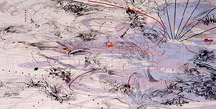
Favoring Unplanned and Decentralized Modes of Organization
Swarm brings together works that express swarming as a social effect generated by masses of objects, images, data, or organisms. The fascination with swarming reflects a contemporary view of nature, politics, and social life–one that favors unplanned and decentralized modes of organization. The exhibition combines emerging and historically significant artists, revealing a series of unlikely and previously unimagined relationships between artists who have not been connected before.
Swarm theory is an idea animating contemporary art, science, design, digital media, and social theory. "Swarm logic" is seen in works that use vast numbers of small parts to create systems whose final behavior or effect cannot be wholly predicted. Artists working with computers and new media construct rules that draw together data and generate behaviors that evolve over time...Swarm connects the social life of bees, birds, crowds, and cities to contemporary aesthetics, as seen in the fascination of artists and designers with how simple, discrete units accumulate into complex systems. [via Rhizome]
Posted by jo at 02:34 PM | Comments (0)
SweetPad
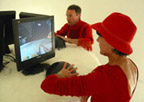
paradoxical videogame interface
Do you remember Quake 3 Arena et similia? The so-called shoot-em-ups, where you fight against anybody else and where the only goal is to score the highest number of frags? That one that cause a cramp in your hand because of the nervous joystick grip and of the hyper-kinetic movements of the thumb for shooting as much gunshots as possible? Stick in mind the goal and forget the rest. SweetPad is an installation by France Cadet, a french artist that works with the behavioral relationships of the individual, related to the artificialness of life. Here the players, in a multiplayer environment, have to kill the highest number of enemies without being aggressive or impulsive. So far the only way to play is the stay calm and gently caress the pads that will mildly obey, shooting mortal gunshots everywhere. It's not acceptable to lose control of the situation and let oneself go to upset gestures, otherwise one is banned to go on with the action. With this mechanism made out of a few simple rules, Cadet primes a real cognitive revolution, investigating the individual ability to manage a so paradoxical situation as that of quietly killing an enemy - even if a virtual one - making a gesture - the caress - that is socially interpreted and received only as a love expression. [Francesca Tomassini, neural]
Posted by jo at 02:20 PM | Comments (0)
ambientTV.NET News
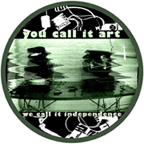
VBI [voluptuously blinking eye/vertical blanking interval]
VBI [voluptuously blinking eye/vertical blanking interval] is a project by ambientTV.NET for the Satellite of Love exhibition of the International Film Festival Rotterdam.
VBI includes: media installation works, Broadbandit Highway by Manu Luksch & Ilze Black; Hacked Nintendo by Lektrolab; Pirate Radio Scanner by Irational.org; The Moment of the Long Now by Juha Huuskonen; Unscheduled TV by Rachel Baker. talks: Juha Huuskonen and Rachel Baker at GATED_TV, which will deal with copy right issues vs. open archives, open source, open archives. Sunday 29 January, 15:00 hrs. live teletext broadcasting station: Microtel by Lektrolab. TV programme contributions: videos are shown on the Exploding Television Channel (digital TV and online)
ambient.lounge: hosted by Tina Hage, a place to meet and relax, to browse the ambient.publishing catalogue, to scrawl your manifesto on the ambient.anti-wall, to find out how to create your own teletext page, or to have a cup of coffee and day-dream...VBI artists: Ilze Black, Irational.org, Juha Huuskonen, Lektrolab, Manu Luksch, Mukul Patel, Rachel Baker, and Tina Hage.
Satellite of Love @ INTERNATIONAL FILM FESTIVAL ROTTERDAM / NL [JAN 26th - MAR 26th]--OPENING: 26th of January, Witte de With center for contemporary art, Witte de Withstraat 50, 3012 BR Rotterdam.
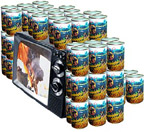
TAMMS in BANGKOK
YOU ARE INVITED to the opening party of the exhibition [FEB 11th - 17th] Temporary Art Museum Soi Sabai (TAMSS) on Feb 10th, 2005 18:00 onwards at Baan Silpakorn, Bangkok.
Manu Luksch & Mukul Patel will premiere their video installation Aju J's New Year Feast. In the Year of the Fire Dog
TAMSS artists: Yoshitomo Nara + graf (featured artists), Angkrit Ajchariyasophon, ambientTV.NET, Anteeksi, Jonathan Barnbrook, Cornelius & Koichiro Tsujikawa, Paul Davis, Eley Kishimoto, Yasumi Hakoshima, Mai Hofstad Gunnes, Yoshinori Hosoki, Rie Ito, Sutee Kunavichayanont, Suwan Laimanee, Philippe Laleu, Nuts Society, Peng Hung-Chih, Wit Pimkanchanapong, Pod, Wisut Ponnimit, Porntaweesak Rimsakul, Lieko Shiga, Tomoaki Suzuki, Wil-kie Tan, Mette Tronvoll, Kyoichi Tsuzuki, Kayo Ume, Apichatpong Weerasethakul, and Tomoko Yoneda.
ambientTV.NET is a crucible for independent, interdisciplinary practice ranging from installation and performance, through documentary, dance, and gastronomy, to sound and video composition and real-time manipulation. Techniques and effects of live data broadcasting and transmission provide theme, medium, and performative space for many of the works.
Posted by jo at 01:55 PM | Comments (0)
Stanford's first ever FLASHMOB!

Monday, January 30, 2006, 12:20pm
In case anyone missed this, you have now been officially invited to Stanford's first ever FLASHMOB. If you did not know, a FLASHMOB is an inexplicable gathering of a group of people in a place for a short period of time. Your task:
By 12:20pm on Monday January 30th and based on your star sign you should locate yourself in one of the following venues with your bicycle and a cell phone:
Aquarius, Leo, Scorpio, Cancer, Gemini or Taurus: Treehouse (and wear a hat) Aries, Pisces, Libra, Sagittarius, Virgo, or Capricorn: Red fountain in front of Green Library (and wear a pair of sunglasses)
At some point a FLASHMOB representative will make themselves known, appear and pass out further instructions. Read the instructions carefully and then hide the piece of paper about your person so that it cannot be seen.
The final instructions will provide the destination of the FLASHMOB site, and you should arrive at the destination at the time that it states. Aim to get there on time, if you are early, stall, if you are late, hurry! Although no one will need to rush.
After the FLASHMOB, carry on with your lives as per normal.
At all times, remember that a FLASHMOB is just fun.
There is no step 6.
At some point during the day, synchronize your watch by using http://nist.time.gov/timezone.cgi?Pacific/d/-8/java (Preferably before the FLASHMOB). Extra Credit: Tell all your friends who might like to join in.
Stay on the right.
Still confused, surf on over to http://www.geocities.com/londonflashmob/ for some more info and surfing links.
If you feel the need: stanfordflashmob[at]yahoo.com [via Howard on Smart Mobs]
Posted by jo at 01:33 PM | Comments (0)
CATaC
![]()
All That is Solid Melts Into Air
Neither global village nor homogenizing commodification: Diverse cultural, ethnic, gender and economic environments
CALL FOR PAPERS AND PARTICIPATION; CATaC, Tartu, Estonia, June 28-July 1, 2006: The biennial CATaC conference series continues to provide an international forum for the presentation and discussion of current research on how diverse cultural attitudes shape the implementation and use of information and communication technologies (ICTs). The conference series brings together scholars from around the globe who provide diverse perspectives, both in terms of the specific culture(s) they highlight in their presentations and discussions, and in terms of the discipline(s) through which they approach the conference theme. The first conference in the series was held in London, UK, in 1998; the second conference in Perth, Australia, in 2000; the third conference in Montreal, Canada, in 2002; and the fourth in Karlstad, Sweden, in 2004.
The 1990s’ hopes for an “electronic global village” have largely been shunted aside by the Internet’s explosive diffusion. This diffusion was well described by Marx - all that is solid melts into air – and was predicted by postmodernists,. The diffusion of CMC technologies quickly led to many and diverse internets. A single “Internet,” whose identity and characteristics might be examined as a single unity, has not materialised. With the dramatic rise of women “users” in what was originally an almost entirely male domain and a diffusion of technologies among diverse cultural and subcultural groups, – much of which was driven by rapid commercialization – an initially culturally and gender homogenous “Internet” came more and more to resemble an urban metropolis. This metropolis is characterised by major commercial districts and diverse ethnic and immigrant groups (Hjarvard, 2002; cf. M. Wilson, 2002, 2004). Along the way, as CATaC’04 keynote speaker Nina Wakeford noted, in the commercialization of the Internet and the Web, “cultural diversity” gets watered down to an “aesthetic sense of pseudo-shock” that exchanges strong diversity for a homogenous interchangeability. Such diversity thereby becomes commodified and serves a global capitalism that tends to foster cultural homogenization. According to Wakeford, “Globalization depends on the exportability of difference”– resulting in a global village whose unity depends on the repression of diversity.
By the same token, especially as explored in the framework of previous CATaC conferences, many of the basic assumptions, categories, methodologies, and theories used early on to analyse the intersections of CMC, culture, and communication have likewise lost their (apparent) initial definition. For example, while our understanding of ‘culture’ vis-à-vis human interactions in CMC environments may have gained some cogency – e.g., as the frameworks of Hofstede and Hall work with some success to explain observed differences in website design (Ess, 2004) – more recent research also demonstrates severe limitations in these frameworks (McSweeney, 2004). Similarly, while ‘culture’ remains a marginal concept in much of the literature of HCI (Kamppuri and Tukiainen 2004) – the concept of ‘culture’ itself seems to become more complex and problematic.
CATaC’06 continues our focus on the intersections of culture, technology, and communication, beginning with an emphasis on continued critique of the assumptions, categories, methodologies, and theories frequently used to analyse these. At the same time, CATaC’06 takes up our characteristic focus on ethics and justice in the design and deployment of CMC technologies. We particularly focus on developing countries facilitated by “on the ground” approaches in the work of NGOs, governmental agencies, etc., in ways that preserve and foster cultural identity and diversity. By simultaneously critiquing and perhaps complexifying our theories and assumptions, on the one hand, and featuring “best practices” approaches to CMC in development work, on the other hand, CATaC’06 aims towards a middle ground between a putative “global village” and homogenizing commodification. Such middle ground fosters cultural diversity, economic and social development, and more successful cross-cultural communication online.
Do our efforts to utilize some notion of ‘culture’ inevitably lead to essentialistic notions that are at best overly simple (a la Hofstede) and, at worst, misleading and false? Hence, ‘culture’ is becoming increasingly complex, issuing in the need to examine culture vis-à-vis the spectrum of media technologies - especially as youth culture increasingly focuses on “media of mobility” (SMS, mobile phones, etc.) We continue our focus on culture by inviting submissions that conjoin theoretical exploration of concepts of culture as currently understood and methodologically applied in a variety of disciplines, including cultural anthropology, ethnography, communication studies, philosophy, etc., vis-à-vis examples in praxis of how CMC and ICTs sustain and/or problematize these concepts.
THEMES
Culture isn't 'culture' anymore: It seems easier to say what culture is not, rather than to define what culture is. For example, ‘culture’ is not simply ethnicity or national identity. It seems clear that cultures, rather than remaining singular, unchanging “lumps” each hermetically sealed off from one another, instead involve dynamic and naturally interacting elements that constantly foster new hybridizations or fragmentations. Is ‘culture’ still a useful ‘research unit’ and/or explanatory concept? Do our efforts to utilize some notion of ‘culture’ inevitably lead to essentialistic notions that are at best overly simple (a la Hofstede) and, at worst, misleading and false? Hence, ‘culture’ is becoming increasingly complex, issuing in the need to examine culture vis-à-vis the spectrum of media technologies - especially as youth culture increasingly focuses on “media of mobility” (SMS, mobile phones, etc.) We continue our focus on culture by inviting submissions that conjoin theoretical exploration of concepts of culture as currently understood and methodologically applied in a variety of disciplines, including cultural anthropology, ethnography, communication studies, philosophy, etc., vis-à-vis examples in praxis of how CMC and ICTs sustain and/or problematize these concepts.
The Internet isn't the 'Internet' anymore: Just as our theories of culture need critiquing and “complexification” so do our theories of the Internet. As the Internet has fragmented into multiple and continuously fragmenting internets, so ICTs now blend into a spectrum of media technologies (e.g., SMS, web-enabled mobile phones, etc.). And as with ‘culture’, ‘communication’ is becoming increasingly complex with the mobile technologies. We invite critical examination of prevailing concepts of gender, equality and liberation, and their intersections with mobile technologies.
Gender, culture, empowerment and CMC: The liberal feminist project of achieving social and political equality among women and men remains unfulfilled - dramatically so in the domains of ICT. At the same time, of course, this project is criticized as reflecting only the culturally-relative values of Western white feminists, not necessarily the values, goals, and ambitions of all women everywhere. Also criticized (e.g. Wacjman) is the claim that ICTs have the ability to empower women in all cultures. This perspective reflects the primarily Western white male software developers and technology policy makers. As well, Simon (ref) observed that women’s ambiguity regarding new technologies is not necessarily a “contradiction” but a way of coping with the stresses and challenges of adapting to technological change. This observation is consistent with a larger theme of much of CATaC research that shows in various ways that rather than presuming “users” as “cultural dopes” (Pargman ref) – persons using CMC technologies are better understood as “savvy users” with considerable awareness of the cultural and gender-related dimensions of these technologies and the possible consequences of their use. Just as our concepts of ‘culture’ and ‘communication’ require critique nd ‘complexification’ – so we invite critical examination of prevailing concepts of gender, concepts of equality and liberation, and their intersections with CMC and ICTs.
CMC and cultural diversity: “I do not want my house to be walled in on all sides and my windows to be stuffed. I want the cultures of all lands to be blown about my house as freely as possible. But I refuse to blown off my feet by any.” – Gandhi. CATaC research has demonstrated in a great variety of ways and cultural contexts that CMC technologies embed and foster specific cultural values and communicative preferences – raising the danger of “steamrolling” diverse cultures (so Steve Jones) through “computer-mediated colonization.” By contrast, more recent CATaC conferences have highlighted “culturally-aware” CMC design (e.g. McIlroy, Hongladarom). Our general question: can ICTs function in a Gandhian fashion, facilitating “open windows” to all the cultures of the world, without making any one dominant and exclusive? What additional theoretical and practical considerations might help realize the Gandhian dream?
Internet research ethics: A number of ethical issues were raised at the last CATaC conference, including questions of research ethics, e.g. When do we use direct quotes from informants? How are we to protect the rights of children and other vulnerable groups? While some progress has been made in establishing international and interdisciplinary Guidelines for Internet Research, this work remains ongoing.
Ethics and justice: From copyright to the ethics of development: "Utopia would be groups determining their own uses." (Beardon) A number of theories and documents, from classical Western liberalism (Kant, Habermas) through to the UN Universal Declaration of Human Rights (1948), support basic notions of individual autonomy and rights to cultural identity. How are these rights to be established and protected, especially in using ICTs for the sake of development? Some established legal conventions, such as copyright, can help, for example, indigenous groups protect their cultural identity by protecting cultural artifacts (Radoll). What theoretical and practical approaches to development involving ICTs foster the utopia of individual and group self-determination?
Free software/Open-Source software: Cultural attitudes and the politics, ethics, political economy of Free/Libre/Open-Source Software (FLOSS). FLOSS is a way of organizing production, of making things jointly, in parallel distributed settings of cooperative behavior, by an increasing number of individuals and groups whose communities and labor are facilitated particularly (but not confined to) the Internet. Exclusive property rights and the division of labor - crucial to the established economic order - are not the main incentives. Rather, the notion of property in FLOSS development concerns the right to distribute and not exclusion, a change that can have profound influences on inter-personal relations and institutions within contemporary "knowledge society". While it will soon be possible to effectively privatize all intellectual products, the advocates of FLOSS are strongly moving in the opposite direction, sketching a social order that is not built on exclusionary principles, price signals and the power of rich countries and corporations. How can free/open source make a difference (or not) when it comes to issues such as "cultural inclusion" (localisation, appropriation, customisation) and "gender inclusion"? Do the particular ways of production and sharing in free/open access/source form a better fit with some "cultures attitudes" and not with others?
Cultural diversity and e-learning - Localization or internationalization?: More and more learning is being delivered using technology. In many universities it has become mandatory to incorporate flexible learning strategies such as online coursework material, streamed audio and/or video lectures, and communication tools. Most elearning for multiple cultures adopt a "localize" strategy of translating content and customizing examples. Is this sufficient? What more can we do to address the needs of diverse cultures?
Posted by jo at 11:48 AM | Comments (0)
January 26, 2006
BE[AM]

Us versus Them
BE[AM]--by Marie Sester--is a spatially interactive installation which displays visuals from a database of American pop culture and offers the visitors control of familiar iconic characters within our increasingly treacherous media environment. BE[AM] seeks to point out the political intoxication and "us versus them" mentality that is gaining prevalence as the lines between entertainment and portrayal of military combat quickly vanish. Charlie Chaplin, Wile E. Coyote, and Super Mario appear in contrast to projections of the American pop landscape: Hollywood productions, TV broadcasts, and video war games. The viewer's interaction with the superimposed icons creates a critical distance from popular media, providing a space for rethinking of large-scale, long-term cultural forces in reference to the daily lives of individuals.
BE[AM] projects video imagery throughout a public space using a robotic projector and employs video game controllers via Max/MSP, Jitter, and OpenGL. [via Jonah on Coin Operated]
Posted by jo at 10:43 AM | Comments (0)
John Seely Brown on the End of Cyberspace
The Disappearance of the Interface
John Seely Brown is a former Chief Scientist of Xerox PARC, and coauthor of two recent excellent books: The Social Life of Infomation (with Paul Duguid), and The Only Sustainable Edge (with John Hagel). John answered the big question in a more philosophical vein than Ross Mayfield:
Cyberspace is an outmoded term. Let's consider as an alternative The Informated World, a world where the virtual and physical boundaries have become blurred and the virtual and physical worlds dance together and enhance each other.
Mark Weiser's vision of ubiquitous computing was a start down this phenomenological path where the concept of 'ready-at-hand' now wondrously crossed the physical/virtual boundary. Ideally, we all sought out a state of being where much like as in Heidegger's story, the blind man sitting feels the handle of the cane but once he starts walking the handle disappears and he feels as if he were directly touching the world.
Likewise, in the informated world, the interface disappears and we feel we can touch the augmented world directly.
Personally, I think this idea of technologies merging with us-- not in the sci-fi implants kind of way, but merging through interaction and familiarity, the way a bicycle or really good pen can become an extension or expression of our bodies-- is an important one to highlight. In my view, one reason cyberspace made sense for so long was that our interactions with computers supported the idea of The World being separate from The Matrix, with only the monitor joining the two together. Brown points out that as technologies change, the character of our experience with them changes; and thus our sense of the world-- and of alternate digital worlds-- inevitably changes as well. [posted by Alex Soojung-Kim Pang on The End of Cyberspace]
Posted by jo at 09:45 AM | Comments (0)
Vilkas + Kukkia
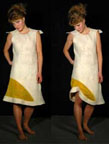
Kinetic Dresses
The hemline of the Vilkas dress rises over a 30 second interval to reveal the knee and lower thigh. The very light yellow cotton element of the hand-made felt garment contracts through the use of hand-stitched Nitinol wires. Once heated, the shape-memory wire pulls the cloth together, creating a wrinkling effect.
The hemline is programmed to rise autonomously. The behavior of this kinetic dress can be playful and even desirable, but can also be embarrassing in the wrong social situation. The wearer can wait for the hemline to fall or can actively pull it back down. This initiates a physical conversation between the wearer and the garment, as they fight over control of the body’s real estate.

The Kukkia dress is decorated with three animated flowers. Each flower opens and closes over (on average) a 15 second interval. The flowers are constructed out of felt and silk petals that provide relative rigidity and conceal the Nitinol wire stitched onto the back. When heated, the wire shrinks and pulls the petals together, closing the flower. As it cools down, the rigidity of the felt counteracts the shape of the wire, allowing the flower to open again.
By Joanna Berzowska (Concordia University). Check also her Intimate Memory clothing. Photos by Shermine Sawalha.
See also CuteCircuit's Kinetic Dress and a wearable system for showing off tattoos. [blogged by Regine on we-make-money-not-art]
Posted by jo at 09:41 AM | Comments (0)
[Stop]Kontakt
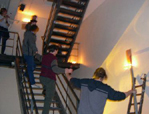
Conductors > Circuits > Chains
Kontakt and Stopkontakt are two similar installations, based on the same principles, but aiming for a different audience. They both are interactive installations that focus on making contact with others, resulting in a variety of physical and/or auditive outputs. Its purpose is to close several electronical circuits, using your body as a conductor between different touch/conductivity sensitive points. Depending on the location of presentation, we have changed the interface accordingly. Walls, staircases and sinks become part of the installation as they are turned into touchpoints, resulting in a very spatial experience. This piece celebrates collaboration and cooperation, as a singular visitor can't close all the possible circuits alone.
'Stopkontakt' is focussed on children and generates more physical outputs compared to 'Kontakt', which is more sound based and less direct responsive as it is build for an older audience. Related links: Karmen and Making Things. [via Regine on we-make-money-not-art]
Posted by jo at 09:35 AM | Comments (0)
WILD INFORMATION NETWORK:
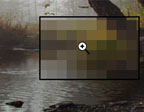
Open Call for Sound Works
WILD INFORMATION NETWORK: The Department of Ecology, Art, and Technology--Open Call for Sound Works In Mp3 Format - Deadline April 1, 2006.
If we encountered a pod-cast, or a streaming radio server in the woods, in the “natural” environment, what kind of information would be distributed? If there was an entity, a life-form, or a “natural” other that disseminated sonic information, wild-information, how would this information sound? This project encourages artists to create audio sound works that imagine the “voice” of the ecological other and explore its translation into the language of digital art technologies.
If “nature” encountered a pod-cast, or a streaming radio server in the woods, in the “natural” environment, what kind of information would be distributed? This project could take on unpredictable, interactive, and experimental dimensions as it also encourages artists to consider themselves as human animals, beings within “nature” producing sound works for unknowable others, e.g. ferns, salamanders, flowers, mosquito, beetles, flowers, deer, coyotes, bear, water, etc.
WILD INFORMATION NETWORK is a project initiated by Cary Peppermint and The Department of Ecology Art and Technology, a performative collaborative of artists seeking to create works that explore issues that lie at the intersection between new media technologies and the environment.
The project will establish a sonic field of information produced with renewable energy, digital technologies, and ecological imagination. The information will be a continuous, solar-powered series of audio transmissions located relatively deep in the woods of 940 acres in the upper Catskills of New York State. Visitors and hikers to the back woods location will use 802.11 wireless devices, bluetooth-enabled devices, or transistor radios to receive sonic information through digital downloads, and radio transmissions.
This project is made possible by generous support from NYSFA's Decentralization Grant, The Upper Catskills Community Center for the Arts, and The Pine Lake Environmental Campus of Hartwick College.
Posted by jo at 09:20 AM | Comments (0)
January 25, 2006
The Strength of Internet Ties

"Our evidence calls into question fears that social relationships — and community — are fading away in America. Instead of disappearing, people’s communities are transforming: The traditional human orientation to neighborhood- and village-based groups is moving towards communities that are oriented around geographically dispersed social networks. People communicate and maneuver in these networks rather than being bound up in one solitary community. Yet people’s networks continue to have substantial numbers of relatives and neighbors — the traditional bases of community — as well as friends and workmates.
The internet and email play an important role in maintaining these dispersed social networks. Rather than conflicting with people’s community ties, we find that the internet fits seamlessly with in-person and phone encounters. With the help of the internet, people are able to maintain active contact with sizable social networks, even though many of the people in those networks do not live nearby. Moreover, there is media multiplexity: The more that people see each other in person and talk on the phone, the more they use the internet. The connectedness that the internet and other media foster within social networks has real payoffs: People use the internet to seek out others in their networks of contacts when they need help." From The Strength of Internet Ties by John Horrigan, Jeffrey Boase, Lee Rainey, and Barry Wellman, The Pew Internet and American Life Project. [blogged by Howard on Smart Mobs]
Posted by jo at 06:12 PM | Comments (0)
RadioHandi
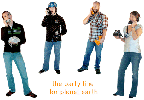
The Party Line for Planet Earth
Brian McConnell on the Etel blog writes "RadioHandi enables people to create voice communities around any subject, place of interest or peer group, and to telecast live audio from MP3 feeds or conference phones. You can create a message board and party line for your club, for people who share an interest, or for your friends. With it, you can create an open party line that people can dial into from all over the world (30+ countries and 1 VoIP network to start with, much more to come). It's also a great platform for ad hoc broadcasting. Just hook a microphone up to a Mac running Gizmo, and you can beam a live audio feed into a conference room that people can then dial into from all over the world (watch for a series of how-tos on ad hoc telecasting and other topics later this week)." [Posted by Phillip Torrone on MAKE:Blog]
Posted by jo at 06:01 PM | Comments (0)
UpStage + Aotearoa Digital Arts
![]()
Open Walk-Through and Online "Swarays"
The next UpStage open walk-thru will be held on Wednesday, 1 February, at the following times: USA California: 12am; USA New York: 3am; UK: 8am; Western Europe: 9am; Finland: 10am; Australia NSW: 7pm; NZ: 9pm. For other local times, check http://www.worldtimeserver.com/

We will soon begin a series of online artists' "swarays" in collaboration with Aotearoa Digital Arts (ADA) so this walk-thru is a good opportunity for people who will participate in that to learn about the environment.
Email me for log-in details if you wish to be a player; audience members, point your browser at http://upstage.org.nz:8081/stages/presentation
helen varley jamieson: creative catalyst helen[at]creative-catalyst.com http://www.creative-catalyst.com http://www.avatarbodycollision.org
http://www.writerfind.com/hjamieson.htm
Posted by jo at 11:42 AM | Comments (0)
Oppera Internettikka Bollywooddikka

Retro-Bollywood Code Arias with MP3 Orchestra
Oppera Internettikka Bollywooddikka (low-tech IT e-Bollywood) by Igor Stromajer & Brane Zorman. LIVE internet broadcast from New Delhi. Oppera Internettikka is a series of low-tech internet opera art projects begun in 1998 to explore a combination of classical opera tactics and strategies, together with singing source code, Java scripts and applets. Igor Stromajer will sing HTML (Hyper Text Markup Language) and Java (Java Scripts and Applets) source codes in Retro-Bollywood style, and Brane Zorman Vs BeitThroN will operating an MP3 orchestra live from New Delhi, India.
Location: India International Centre New Delhi, India; Saturday, January 28th, 2006 from 7:15 PM to 8 PM local New Delhi time (Standard Time +05:30 UTC) = from 14:45 to 15:30 Berlin/Paris time. Check exact current local time in India: Advice: please re-check www.intima.org/oppera/oib on January 28th in the morning, for the exact starting time of live broadcast - it may vary due to unexpected circumstances (+/- 1 hour) !!!
It will be performed live in the India International Centre in New Delhi, in the frame of CeC & CaC - The Carnival of e-Creativity & Change-agents Conclave, presented by The Academy of Electronic Arts, and broadcasted live on the internet. CeC - The Carnival of e-Creativity is organized by the producer, curator and director Shankar Barua.
I. Stromajer and B. Zorman will be singing, composing and manipulating HTML source code of the www.bollywood.com website, as it was written on August 15th (2005), Indian Independence Day. # www.bollywood.com is a registered domain of K.C.Varshney.
Produced by Intima Virtual Base - Institute for Contemporary Arts, Slovenia, 2006 - in collaboration with Cona. Special thanks to Bojana Kunst and Irena Pivka.
Project supported by The Ministry of Culture of the Republic of Slovenia.
[] [] []
"Le Pavarotti du HTML" - Le Slovene Stromajer crée des opéras en code web - par Marie Lechner (Le vendredi 2 février 2001, Libération Paris, France).
"But beware: Igor Stromajer is also singing the theory of the Internet!" (Inke Arns; Leonardo Electronic Almanach, Volume 8, N.1, MIT Press 2000).
"It all started in 1999 when Igor Stromajer earned the peculiar nickname, the Pavarotti of the Internet, for singing his Oppera Teorettikka Internettikka, a transcoding of the HTML into song." (Rossitza Daskalova, CIAC Electronic Art Magazine, Montreal, Canada, N.15, August 2002).
[] [] []
In January 1996 Intima Virtual Base created its first net art project, entitled 0.HTML. The project was awarded Third prize at Extension 1997, Hamburger Kunsthalle, Germany (jury: Dr. Uwe M. Schneede, Rainer Wörtmann, Dellbrügge & de Moll, Valie Export, Dr. Dieter Daniels).
Intima Virtual Base 1996-2006: Ten Years of Net Intimacy http://www.intima.org/00110001_00110000
Celebrating ten years of net intimacy, Intima Virtual Base is producing a new internet opera - Oppera Internettikka Bollywooddikka.
http://www.intima.org/oppera/oib
[] [] []
Live Internet Video&Audio Broadcasting:
Oppera Internettikka Bollywooddikka will be broadcast live from New Delhi via internet, using a free MakeTV website service, developed by AI.
Instructions:
1) check the exact current local time in India (January 28th, 2006 at 7:15 PM UTC/GMT +05:30)
2) go to MakeTV
3) accept the terms
4) select Oppera Internettikka Bollywooddikka by the producer "tvintima"
5) watch: enlarge/reduce the video size or go fullscreen
6) archived file will be available immediately after broadcast
Intima Virtual Base
[ the low-tech solution for tactical emotional art ] http://www.intima.org; 3[at]intima[dot]org
t: +386 41 703291
Posted by jo at 09:14 AM | Comments (0)
January 24, 2006
Intimate Visual Co-Presence
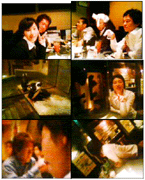
Creating Drama Out of the Banalities of Everyday Life
"ABSTRACT: Photo sharing via handheld devices has unique limitations and affordances that differ from paper-based sharing and PC-based archive and moblog sites. Based on studies of camphone use in Japan, this paper suggests an emergent visual sharing modality that is uniquely suited to the handheld space. Intimate visual copresence involves the sharing of an ongoing stream of viewpointspecific photos with a handful of close friends or with an intimate other. The focus is on co-presence and viewpoint sharing rather than communication, publication, or archiving." Intimate Visual Co-Presence by Mizuko Ito.
Also of interest: Pervasive Image Capture and Sharing: New Social Practices and Implications for Technology; Turning from Image Sharing to Experience Sharing; Pervasive Imaging: a Capture and Access Perspective; and The Autobiographical Impulse and Mobile Imaging: Toward a Theory of Autobiometry. (more)
Posted by jo at 12:03 PM | Comments (0)
The High Performance Gameplay Inventory

Gamers ♥ Performance
"ABSTRACT: All gameplay is performance, and all gamers are performers. But some gamers adopt unexpected strategies to make their gameplay more extroverted, more attention-generating, more compulsively watchable, more theatrical — in other words, more high performance. This worksheet presents six vectors for transforming ordinary digital gameplay into high performance gameplay, and proposes a high performance gameplay inventory system based on actual high performance gameplay strategies observable in contemporary digital games culture." The High Performance Gameplay Inventory by Jane McGonigal
Posted by jo at 09:26 AM | Comments (0)
Profiles as Conversation:
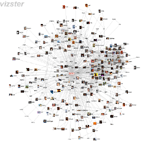
Networked Identity Performance on Friendster
"ABSTRACT: Profiles have become a common mechanism for presenting one’s identity online. With the popularity of online social networking services such as Friendster.com, Profiles have been extended to include explicitly social information such as articulated “Friend” relationships and Testimonials. With such Profiles, users do not just depict themselves, but help shape the representation of others on the system. In this paper, we will discuss how the performance of social identity and relationships shifted the Profile from being a static representation of self to a communicative body in conversation with the other represented bodies. We draw on data gathered through ethnography and reaffirmed through data collection and visualization to analyze the communicative aspects of Profiles within the Friendster service. We focus on the role of Profiles in context creation and interpretation, negotiating unknown audiences, and initiating conversations. Additionally, we explore the shift from conversation to static representation, as active Profiles fossilize into recorded traces." From Profiles as Conversation: Networked Identity Performance on Friendster, Danah Boyd, Jeffrey Heer
Posted by jo at 09:12 AM | Comments (0)
Upgrade! New York

Deep Performance
Upgrade! New York presents Pauline Oliveros performing with Tintinabulate Ensemble from Rensselaer Polytechnic Institute's and Meme Improvisation Group (MIG) from Brown University. A discussion will follow. January 26, 2006; 7:30 PM - 9:00 PM, Eyebeam, 540 W. 21st St. This event is open to the public and free with a suggested donation.
Pauline Oliveros (1932) is one of America's most vital composers. Deep Listening, her lifetime practice, is fundamental to her composing, performing and teaching. Tintinnabulate is an ensemble of improvisational players whose voices and senses are tuned through the practice of Deep Listening. We achieve harmony through intuition, play, and sympathetic resonance. Founded by Pauline Oliveros, and based at RPI's iEAR (Integrated Electronic Arts) program in Troy, NY, Tintinnabulate has initiated a series of Distance Performances: live, co-located, Internet performances with improvisational ensembles across the United States.
MIG is an ensemble focused on technologically mediated improvisation that draws from the Free Jazz and Experimental Music Tradition. Members include both Brown University and Rhode Island School of Design students. MIG is an outgrowth of MEME, the multimedia and electronic music composition program at Brown University.
More About The Performers: During the 1960's John Rockwell named Pauline Oliveros' work as one of the most significant of that decade. In the 70's she represented the U.S. at the World's Fair in Osaka, Japan; during the 80's she was honored with a retrospective at the John F. Kennedy Center for the Performing Arts in Washington D.C.; the 1990's began with a letter of distinction from the American Music Center presented at Lincoln Center in New York; In 2000 the 50th anniversary of her work was celebrated with the commissioning and performance of her Lunar Opera:Deep Listening For_tunes. She serves as Distinguished Research Professor of Music at Rensselaer Polytechnic Institute, Troy, NY; Darius Milhaud Artist-in-residence at Mills College, Oakland, CA; and president of Deep Listening Institute in Kingston NY.
Tintinabulate Ensemble:
Alex Chechile
Bart Woodstrup
Jesse Pearlman Karlsberg
Yael Kanarek
Meme Improvisation Group (MIG):
Kevin Patton
Damon Baker
Joseph Butch Rovan
Carmen Montoya
Tintinnabulate and MIG first performed together in the Fall of 2005. The ensembles performed over the Internet, each from their respective location. This performance at Eyebeam, hosted by The Upgrade, brings the two ensembles together into the same physical space for the first time.
![]()
The Upgrade! is a monthly meeting for professionals in the field, providing an open forum for the artists, designers, critics, curators, and educators that form New York's digital arts community. Eyebeam sponsors their activities, which include lectures and group discussions. New media artist, Yael Kanarek, initiated The Upgrade in April 1999, and currently coordinates the program in conjunction with Eyebeam. The monthly gatherings include artist presentations, lectures and group discussion.
Posted by jo at 07:31 AM | Comments (0)
January 23, 2006
Mirrors and Shadows:
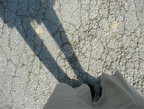
The Digital Aestheticisation of Oneself
"ABSTRACT: Digital cameras have made self-portraits increasingly common, and frequently we post our self-portraits online. This paper compares online photographic self-portraiture with self-representations in weblogs and the creation of visual avatars. Contemporary projects and quotidian practice is connected to the history of self-writing and self-portraiture, as well as to psychoanalytic theories of how we use our own mirror images to come to an understanding of our selves. The paper concludes that our contemporary fascination with reflections and shadows is an expression of our newfound subjectivity as individuals able to represent ourselves rather than simply succumb to the generalisations of mass media." From Mirrors and Shadows: The Digital Aestheticisation of Oneself by Jill Walker
Posted by jo at 06:38 PM | Comments (0)
LAN Party
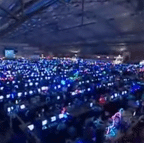
Bring Your Own Computer (BYOC)
"A LAN party is a temporary, sometimes spontaneous gathering of people together with their computers, which they connect together in a local area network (LAN) primarily for the purpose of playing multiplayer computer games. These LANs come in various sizes, from the very small (2 people) to the very large (4000+ people). Small parties can form spontaneously, but large ones usually require a fair amount of planning and preparation on the part of the organizing team. The term 'LAN party' is sometimes incorrectly applied to Gaming centers and Internet cafes. Although offering comparable services, LAN party events differ significantly in that they are generally BYOC (Bring Your Own Computer) and are not permanently set up." Wikipedia
Last year in Sweden "(n)early 6,000 young people lugged their desktops through the snow to a convention center, where they hooked them up together and played video games for three days and three nights, with only occasional breaks for sleep...
The reason why these events happen is because you want to meet the person in real life. You play on the Internet all the time and you see their name. But you don't know what they look like," he says. "You don't know what they're really like in person." Cyber Athlete 'Fatal1ty', 60 Minutes.
Posted by jo at 05:40 PM | Comments (0)
Rough Cuts

Process(ing)
Rough Cuts is a new service from Safari Books Online that gives you early access to content on cutting-edge technologies -- before it's published. It lets you literally read the book as it is being written. The beta version of the Rough Cuts service is debuting in January 2006, with four works-in-progress from O'Reilly Media. We'll be adding features, titles, and publishers throughout the year.
When purchasing a book you gain access to an evolving PDF manuscript that you can read, download or print. Once you've purchased a Rough Cuts title, you will have a chance to shape the final product--you can send suggestions, bug fixes, and comments directly to the author and editors.
Posted by jo at 04:40 PM | Comments (0)
Khan Artist
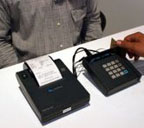
Provocative Questions About Art and Consumption
[...] Khan Artist, by Osman Khan (see also: "What's your net worth?" and "Sur la table"), looks just like a credit processing machine in front of the Artist. The Artist actually is registered as a validated merchant with the machine, and the Artist (or through a sales rep proxy) asks the visitor to make a purchase. When a purchase is made, no product or service is returned in kind at the time of transaction. The Artist's name will show up on the itemized list of the visitor's monthly statement.
This work is partly inspired by what happened after the tragedy of 9/11.
For the macro well being of a capitalist system, what is actually bought or sold becomes secondary to the actual act of consumer transactions transpiring. We saw this occur, as the government urged people to begin spending and purchasing in an effort to revive the American economy after the tragedy of 9/11. It was not important what was bought or sold, as long financial transactions kept flowing through the economic machine, the path to recovery would be under way. Perhaps it can be seen that a consumer society is actually more dependent on the acts of purchasing then the exchange of goods or services.
Simple as it looks, this work asks several provocative questions about art and consumption. Khan Artist was selected as Jury Recommended Works out of the finalists of the 2005 Japan Media Arts Festival. Related projects by the same artist: net worth, data dump, and art dispensing machine (ADM). [blogged by manekineko on we-make-money-not-art] [Related: The Swipe Toolkit]
Posted by jo at 03:03 PM | Comments (0)
Fyra ofoner
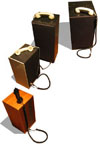
Invitation and Unwritten Score
Fyra Ofoner (Four Ophones)--by Erik Sandelin and Magnus Torstensson--is an invitation and an unwritten score for a composition that lasts as long as the exhibition does. You and other visitors take part as audience, musicians, and co-composers. No one knows what will happen or how it will sound. Be prepared for everything from subtle interference etudes, to collaborative chanting and big, bad rhythm orgies.
An ofon is a loudspeaker with an attached telephone headset. When a visitor has recorded a sound into an ofon, it is repeated infinitely until another sound is recorded into the same ofon. When all four ofons are used, no one can predict what will happen or how it will sound. Videos on the website. [blogged by Regine on we-make-money-not-art]
Posted by jo at 02:58 PM | Comments (0)
DIGITAL ART WEEKS 2006 ETH Zurich
![]()
[Kon.[Text]] Symposium
CALL FOR PAPERS, PANELS, DEMONSTRATIONS & PERFORMANCES--Zurich, Switzerland, Thursday July 13th to Sunday July 16th, 2006
The Digital Art Weeks PROGRAM (DAW06) is concerned with the application of digital technology in the arts. Consisting of symposium, workshops and performances, the program offers insight into current research and innovations in art and technology as well as illustrating resulting synergies in a series of performances during the Digital Art Weeks Festival each year, making artists aware of impulses in technology and scientists aware of the possibilities of the application of technology in the arts.
[Kon.[Text]], this year?s Digital Art Weeks SYMPOSIUM concerns the use of the Performative Surround in the arts and the technology that drives it. The Performative Surround pertains to the immersive quality and quantity of the setting of a performative artwork that uses electronic media enhancement. Enhanced media art is any artwork that uses electronic media to communicate in part or in whole its message to the viewer. The viewer may be there with integrated into the performative arena through the use of the communicative powers of the applied media.
In a series of lectures, demonstrations, panels and performances, artists and researcher will examine the use of electronic media in articulating the performer?s presence through the possibilities of the multi-sensuality of electronic media. The possibilities of blurring the divide between public and performer to bond them through the powers of dissemination and inclusion inherent within the technology behind the performative surround will also be considered as well as how communication between both performer and public can be interactively networked in real time through various forms of computer enhanced dialoging.
To draw a parallel between the symposium?s title [Kon.[Text]] and the phrase in the body of the text? in terms how both performer and public are virtually networked by the expansion of the real into virtual, issues in media enhanced performance and its re-embodiment into the domains of hyper-reality will be tangibly demonstrated in a series of evening performances.
The organizers of the Digital Art Weeks ETH Zurich are seeking presentations, demonstrations and performances on all themes specific to performance using electronic media that explore a concept of the Performative Surround in terms of how computer-mediated communication and dialog takes place between performers and viewers and how it tends to aid in dissolving the divide between performer and viewer. Submissions of both theoretical and empirical studies are invited from the perspectives of the performing arts and computer science and as well as other topics relevant to the Performative Surround and it technology basis. Suggested submission topics for papers, demonstrations and performance include, but are not limited to the following themes:
1. Media Enhanced Artwork in the areas of Performance, Dance and Sound-Art
2. Laptop Music (including Live-Coding!) & Film Accompaniment (Live-Cinema, & Re-Scoring)
3. Mobile Art & Music Works that explore Performer Networking and Audience Participation
4. Net-poetry and literature & computer mediated communication (i.e. Hyper-Media Embedding)
5. Grammar- or Syntactically based Software Systems for Multimedia Systems
The organizers of the Digital Art Weeks ETH Zurich are seeking participants for a series of PANELS concerning the following themes in relationship to the Performative Surround:
1. Software Innovations relevant to all aspects of Computer Mediated Communication and its application in the performing arts.
2. Live Cinema, Expanded Video, Film Rescoring & Immersive Audio Space & Video Space
3. Media Enhanced Performance
4 Projects concerning the dissolve of the Performer-Audience & Private Space-Pubic Space Divide
DEADLINE FOR ALL PROPOSALS: Friday, March 17, 2006.
Notification of acceptance of proposals will be sent out on or before Friday, April 7, 2006.
SPEAKERS / ARTISTS (CONFIRMED)
For an up-to-date list of this years participating speakers and artists please see: http://www.jg.inf.ethz.ch/wiki/DAW/Symposium2006
SUBMISSION GUIDELINES
DIGITAL ART WEEKS 2006 (DAW06) is interested in artistic and theoretical work in the form of Papers, Panels and Presentations can include DVDs, audio CDs, videotapes, web-sites, etc. Papers and Presentations can be 25 or 45 minutes in length. DAW06 organizers will build panels based on reviews of materials submitted.
Proposed artwork to be included in the DAW06 Festival may take the form of performances with or without media enhancement or be in the form screenings live or fixed material.
Applications should not exceed 500 words. Applicants should indicate one of the festival categories in the subject of the message. Please include a 200 word max bio.
All proposals must be submitted in plaintext only format either as an attachment and/or within the body of the email message. In case of Audio and/or Video examples, please provide a valid URL to a web site containing them. If your presentation requires specific technologies, please describe your needs in detail.
All proposals should be submitted electronically to: Art Clay: arthur.clay[at]inf.ethz.ch
or should be sent per mail to:
Art Clay
Computer Systems Institute
ETH Zentrum, RZ H 18
Clausiusstrasse 59
CH-8092 Z=FCrich
Switzerland
Digital Art Weeks 2006 ETH Zurich
Parallel Event - Interactive Futures, 2006
Co-sponsor - Computer Systems Institute ETH Zurich:
Co-sponsor- sitemapping.ch, Swiss Federal Office of Culture
Research Partner: The Situated Body
FUNDING
THE DIGITAL ART WEEKS does not have funding for travel or accommodation. Presenters and artists are expected to apply for travel funding from their home institutions and/or granting bodies. All presenters and artists will be given a pass to all DIGITAL ART WEEKS events and will have access to food and drinks at the Conference Center. All presenters and artists will be eligible for reduced rates at participating hotels.
CONTACTS
DIGITAL ART WEEKS Curators:
General Requests daw-info[at]inf.ethz.ch
DIGITAL ART WEEKS Chairs:
Art Clay http://www.jg.inf.ethz.ch/wiki/DAW/Chairs
Stefan M=FCller Arisona http://www.jg.inf.ethz.ch/wiki/DAW/Chairs
INTERACTIVE FUTURES Curators: Steve Gibson sgibson[at]finearts.uvic.ca
DAW Workshops for 2006: http://www.jg.inf.ethz.ch/wiki/DAW/Workshops2006
DAW Mailing List: https://lists.inf.ethz.ch/mailman/listinfo/daw-list
Mailing Address:
Digital Art Weeks
Computer Systems Institute
ETH Zentrum, RZ H 18
Clausiusstrasse 59
CH-8092 Z=FCrich
Switzerland
Voice +41 44 632 7233
Fax +41 44 632 1307
Posted by jo at 12:45 PM | Comments (0)
Thomson & Craighead
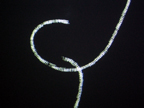
Audio and Visual Machines
January 26 – March 3, 2006 at Mejan Labs: Akademigränd 3, SE-111 52 Stockholm, Tel: +46(0)8-796 60 30; info[at]mejanlabs.se Open: Tue-Fri 11-17, SAT-SUN 12-16, closed Mondays.
At Mejan Labs Thomson & Craighead present two installations; Decorative Newsfeeds and Unprepared Piano. Decorative Newsfeeds could be described as a digital automatic drawing -a sort of contemporary update of Jean Tinguely’s drawing machines perhaps, but in this case with readable authentic up to the minute news headlines gathered in real-time from the web. The headlines are updated continuously and projected in evolving trajectories that weave and intersect each other according to a simple set of rules.
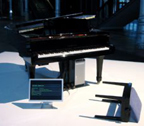
In Unprepared Piano, a Yamaha Disklavier grand piano is connected to a database of music MIDI files appropriated and compiled from all over the web. This library of found data is then “performed” automatically in the gallery with the full authority one associates with a concert grand piano. Each MIDI file contains an electronic score for a whole piece of music with different tracks for different instruments. When the piano plays one of these scores, it switches between the tracks randomly, which means it will sometimes play a piano part correctly but may also render drum parts, string sections and marimbas etc. in awkward configurations and combinations. On a monitor it is possible to see real-time information about what is being played.
The title Unprepared Piano specifically references the composer John Cage and his method of preparing a piano by fastening nails, coins and so on directly onto the strings inside the instrument, and in doing so to change the sound of it when played. But the title also refers to the piano being unprepared for the information it accesses and with no human performer and no way of knowing exactly what might be performed, Unprepared Piano becomes an endless generative mechanism for the performance of unique musical improvisations.
Thomson & Craighead: British artists Jon Thomson and Alison Craighead have been working together since the early 1990's. They are considered to be among the leading artists on the British new media art scene. Much of their work to date has paralleled the development of Internet technology by way of more traditional media such as video, sound and gallery installation, and they began working with electronic networks and communications systems when the world wide web first appeared in the mainstream around 1995. As this technology has improved and internet connections have become faster, they have begun to re-combine internet technology with their gallery work exploring the consequential possibilities of linking the internet to these kinds of physical spaces.
Thomson & Craighead often use the web as a gigantic database, procuring and reconfiguring existing material in real-time to offer new meanings and perspectives on the way in which we all might perceive the world around us. This kind of approach is in keeping with many methods used across the whole canon of contemporary art: real-time and generative processes, randomness, the recycling and misuse of information and technology and a process based flow that goes from one stadium to another.
Posted by jo at 10:13 AM | Comments (0)
January 21, 2006
node.london

Media Art Soapbox at Science Museum
WHAT: As part of its programming for node.london the Science Museum invites media artists, designers and artist-led organisations to present their work or activities for a five-minute slot during a two-hour evening of short presentations, show and tell, performances, participation and discussion.
Soapbox at the Dana Centre is the Science Museum's response to the grassroots approach of node:london. We want to create an opportunity for London based practitioners to present their work on a first-come first served basis, rather than going through a heavily curated selection process. Artists and designers at a briefing meeting proposed this could become a regular event after the node pilot. Depending on take-up and response we will consider running this quarterly.
WHEN: Tuesday March 2 2006, 18.30 - 20.30.
WHERE: Science Museum's Dana Centre, 165 Queens Gate, London SW7. South Kensington tube. In the informal cafe-bar.
FORMAT FOR EVENT: Practitioners will be invited to present specific projects for 5-10 minutes each and will be grouped into themed strands. Selection of projects will be on a first-come first served basis (send expressions of interest to e-mail below) and themes will be drawn from the sort of projects suggested. Media art critics, commentators and curators, along with the audience will be invited to respond to the ideas discussed with the artists in small working groups, who will come together for a summary session at the end of the evening.
The precise format will depend upon numbers and will be confirmed with selected practitioners by February 10 2006.
FIXED TECHNICAL PRESENTATION FORMAT: for ease of changeover all presentations must be presented online. This will be broadcast onto large screens.
HOW TO GET SELECTED: send one page A4 with your name, e-mail address, contact telephone number, and paragraph summarising the project or idea you wish to present with web address where relevant to smap[at]nmsi.ac.uk. The maximum number of artists we will be able to invite to present on the evening will be 12. First-come first served!
DEADLINE: Register your interest by Feb 3 2006.
The Soapbox presentations will be supported by a series of 'invited experiments' - art works in progress, or art works that require audience participation for their realisation.
CONTACT: Hannah Redler, Head of Arts Programme, Science Museum, Exhibition Road, London SW7 2DD
Messages may be left on ++44 (0) 20 7942 4802. Email to smap[at]nmsi.ac.uk
Posted by jo at 02:27 PM | Comments (0)
January 20, 2006
WBAI-FM "Avant Garde Concert III"
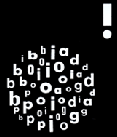
Charlotte Moorman
A Trove of Archival Performances by Charlotte Moorman: UbuWeb is proud to host the audio archive of Charlotte Moorman (1933-1991), containing hours worth of unreleased works and collaborations by Nam June Paik, John, Cage, Earle Brown, Karlheinz Stockhausen, Terry Jennings, Toshi Ichiyanagi, Jackson Mac Low, David Behrman, La Monte Young, Sylvano Bussoti, George Brecht, Dick Higgins, Giuseppe Chiari and others. The selection is curated by Stephen Vitiello, with special thanks to Barbara Moore / Bound & Unbound.
WBAI-FM "Avant Garde Concert III" was originally broadcast December 12 & 17, 1964. A Recording of the Annual Avant Garde Festival Program of August 30, 1964. From an original announcement card: "Avant Garde Concert III. Third in a series of concerts recorded by WBAI this fall at Judson Hall. Cellist Charlotte Moorman is assisted by pianist Nam June Paik and soprano saxophonist Terry Jennings. In the Cage opus she utilizes not only her cello but additional whistles, chains, balloons (for breaking), etc. with recorded supplements such as the Queen Mary's departure blast and sounds from Big Ben. In Stockhausen's 'Plus-Minus', Miss Moorman is assisted by a full-size robot named Robot Opera, built by Nam June Paik."
Posted by jo at 06:06 PM | Comments (0)
Trampoline
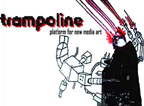
Call for Submissions
Trampoline - 16th March 2006: Deadline: February 17th--Nottingham’s platform for new media art begins its Spring 2006 Programme this March - we are sending out our radar across the globe in the search for challenging new work. This is an opportunity to plug into the innovations of Nottingham/regional based artists and at the same time connect with international media art developments. Trampoline is always looking to expand and find innovative ways of connecting spaces in the global age, overcoming geographical distances via digital technologies. Trampoline is extending its antennae to both transmit and receive in its event of regional and international creative exchange.
Questioning geographic borders and communication barriers in the age of global connectivity, we will be asking, what is their state of existence and what is their relevance today? New barriers are continuously broken yet new divisions are formed. In today’s global network, all the world is invited, but some are still excluded.
Trampoline is searching for work which contributes to these debates, challenges our notions of these boundaries and creatively comments on our entangled yet fragmentary network.
From video, animation, installation, sculpture, performance, live music and web streaming Trampoline encourages all forms of new media expressions.
Trampoline is calling for submissions for this event The deadline is February 17th – but the sooner you express interest the better Please download a submission form and send with supporting material to
Trampoline Submissions
Broadway Cinema
14-18 Broad Street
Nottingham
NG1 3AL
UK
Please contact Emma Lewis, Trampoline Coordinator +44 (0)115 9559956 emma[at]trampoline.org.uk
Posted by jo at 05:42 PM | Comments (0)
UCHRI Summer Seminar
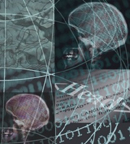
Experimental Critical Theory
The UC Humanities Research Institute (UCHRI) invites applications from scholars – faculty of all ranks and students – wishing to participate in the third annual Seminar in Experimental Critical Theory (SECT), August 14-25, 2006; UC Irvine Campus.
SECT is an intensive two-week summer program for graduate students and faculty from the UC system and elsewhere, as well as other scholars, professionals and public intellectuals. The Seminar brings together distinguished instructors and a group of 50-60 students to study a pressing issue or theme in contemporary critical theory, in both its "pure" and "applied" modes. SECT is neither exclusively an introductory survey course nor an advanced research seminar. Rather, it is an academy or "laboratory" where students and faculty at all levels of previous experience can study with scholars involved in important and creative theoretical thought. Truly innovative work is of necessity both fundamental and advanced, hence needs to be presented in ways that are simultaneously accessible and challenging for the widest range of scholars. Participants are encouraged to think experimentally and critically, reflecting on prevailing structures of thought while dynamically engaging intellectual inheritances and pushing for theoretical innovations.
Deadline: Applications are due, along with a $20.00 application fee, by February 15, 2006.
Participants in the 2006 Seminar will explore new ways of thinking about and with technology. The two-week Seminar will include paired conversations between technological innovators and experimental humanists, around the many issues that engage the human and the technological. The two-week Seminar will also include demonstrations of new technological devices, classroom applications and scholarly practices. Participants will have opportunities to engage with new digital applications in the context of small-group workshops, large-group social networking exercises and art/technology installations. The objective for SECT III is to broaden the participation of humanists in the transformation of spheres of technological experience.
Conversations with: Julian Bleecker; John Seely Brown; Craig Calhoun; Lisa Cartwright; Cathy N. Davidson; Scott Fisher; Tracy Fullerton; Guillermo Gómez-Peña; Katherine Hayles; Lynn Hershman; Norman Klein; Geert Lovink; Tara McPherson; Michael Naimark; Saskia Sassen; Larry Smarr
Workshop Topics: Wikis; Blogging; Google Jockeying; Creative Commons; New Genres of Digital Scholarship; History of Electronic Literature; Database Narrative; Multimedia Documentary; Distributed Collaboration in the Humanities; Creation of Digital Archives
Performances & Presentations: Beatriz da Costa; René Garcia, Jr.; Guillermo Gómez-Peña; Lynn Hershman; Perry Hoberman; George Lewis; Michael Naimark; Simon Penny
Cost: Application fee: $20.00 (non-refundable) is due at the time of the online application submission. Applications will not be reviewed until the application fee is received.
Registration fee: $1,750 for the SECT series. The fee includes tuition for the two-week Seminar and daily refreshments. It does not include the cost of housing or meals.
Scholarships: The UCHRI will make available up to 10 scholarships for full-time registered students covering the full SECT fee. Scholarship awards will be announced by April 15, 2006. Applicants are encouraged to seek funding from their home institutions.
Requirements: One-page statement covering education, relevant publications (if any), background in an area of study relating to the current SECT topic, and reasons for requesting course of study; and abbreviated curriculum vitae (two pages maximum).
More information and registration instructions are available. [blogged by Julian Bleecker on Interactive Media Division Weblog]
Posted by jo at 03:23 PM | Comments (0)
Audio/Viscera
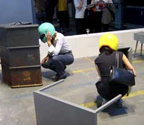
Sound Architecture
Audio/Viscera--by John Rothenberg--explore ways in which sound can be treated as an architectural material. The user wears a helmet containing wireless headphones. Their motion, tracked by a computer vision system, determines the sound they will hear and it serves the secondary purpose of redefining the soundscape.
Sounds (both live and recorded audio) are assigned to specific virtual locations, and are broadcast to the headphones as if they actually inhabited that space. Physical objects and images guide the user to these virtual sounds in the gallery. Somes sounds move through the soundscape, responding to the user’s motion and allowing her/him to discover and alter the virtual audio landscape.
Audio/Viscera aims to give architectural elements (like a wall or column) a voice. This is achieved through two channels: (1) a map of the audio events taking place in the city of Munich: as the user approaches the screen, s/he can hear (pre-recorded) sounds taking place at various locations throughout the city; (2) live but distant sounds are translated from throughout the exhibition and exterior spaces into the soundscape. The user is thus able to cross physical/architectural boundaries with sound, much as a window allows the user’s eye to cross physical boundaries in conventional architecture. These sounds will be connected to visual clues in the form of images or animations, or they will respond to the user’s motion.
This project explores the interaction between virtual and real space through sound. PDF of the project. Related: audio space + audiotag + audio graffiti, Mapamp, Sonic city, sound mapping, Aura, Akitsugu Maebayashi's audio work. [blogged by Regine on we-make-money-not-art]
Posted by jo at 02:39 PM | Comments (0)
Ether Beat
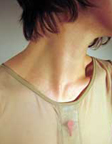
Under Beat, My Heart Beats for You
Ether Beat are compatible garments that sense, process, transmit and receive the ECG wavelength. A singlet (Under Beat) houses the ECG electrodes and connects to either the scarf or the blouse.
The under garments are enabled with ECG sensors and processing equipment while the outer garments house signal processing equipment, small vibration motors, and radio transceivers. The garments receives the heartbeat wavelength of your remote friend/lover/relative and transmits it as vibration through your garment. Using inexpensive wireless components, tests have demonstrated the devices working up to a distance of 25 metres, in an electrically noisy environment. Future prototypes will utilise Bluetooth or similar technology to allow for a more remote 2-way transmission occur.
The project questions whether usage of the apparatus will encourage physiological empathy - the moderation of ones heartbeat to syncopate with that of the remote other; and emotional empathy - the establishment of a remote emotional linkage. A project by Leah Heiss. Also by Heiss: the Empathy Vest. [blogged by Regine on we-make-money-not-art]
Posted by jo at 02:23 PM | Comments (0)
CYNETart_06humane

Call for Entries: Body-image – Image-body
CYNETart_06humane is devoted to the theme of Body-images – Image-body :: the bred, constructed, staged, cultivated, homemade and self-designed human being. Work from the fields of dance & technology, performances, audiovisual compositions, installations, net art and new social and cultural strategies based on new technologies may be submitted to the competition. CYNETart_06humane takes place November 15 to 19. Deadline: March 20, 2006!
CYNETart has been showing new trends of cultural developments in the media arts since 1997. The consequences of the prevailing progress of civilisation and the introduction of new information technologies in all fields of social life lead to the disembodiment of perception triggering the examination of a new sensitivity for physical experience and for the perception of one’s own body. The international festival focuses on the changed perception of the body caused by new information technologies. At this, the performance of the new technologie is less important, it is rather about their cultural potential for mediation. This applies f.i. to linkages between existential questions of humankind and their perception. It also applies to a more sensual approach to scientific methods of research and the interconnections between the arts.
All in all, CYNETart 2006 presents three awards. The CYNETart award donated by the Stiftung für Kunst & Kultur der Stadtsparkasse Dresden is endowed with 5,000 Euros. The CYNETart award donated by T-Systems Multimedia Solutions is endowed with 5,000 Euros. The sponsorship award of the Saxon Ministry of Science and the Fine Arts is endowed with 10,000 Euros. The award-winning works are selected from the submissions by an international expert jury. Application form online. The deadline for submissions is March 20, 2006!
Organiser: Trans-Media-Akademie Hellerau e.V. and The City of Dresden, Culture Office in co-operation with the European Centre for the Arts Hellerau
You get further information on www.cynetart.de and from
Trans-Media-Akademie Hellerau e.V.
Festspielhaus Hellerau, Karl-Liebknecht-Str. 56
01109 Dresden, GERMANY
Tel. +49-351-889 6665
Fax +49-351-34 000 33
Posted by jo at 12:57 PM | Comments (0)
LE GRAND CAFÉ, Centre d'Art Contemporain, Saint-Nazaire (F)
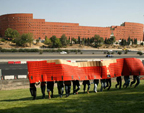
MODERN©ITE # II
MODERN©ITE # II: Francis Alÿs, Pedro Cabrita Reis, Marcelo Cidade, Jordi Colomer, Anita Molinero. Curator: Sophie Legrandjacques--January 21st to March 13th 2006, Opening: Fri, 27th Jan 7 PM.
Modern©ité # II brings together five artists (Francis Alÿs, Pedro Cabrita Reis, Marcelo Cidade, Jordi Colomer and Anita Molinero) who share a vision of modernity which is closely tied to the character of cities, particularly those in Southern Europe or Central and Latin America. Whether their work takes form in the making of sculpture, public actions, videos or photographs, the city is the space in which their different artistic trajectories meet, marked as much by Samuel Beckett, Kasimir Malevich, Gordon Matta-Clark, Hélio Oiticica as by Luis Buñuel. Using and appropriating the material that cities offer - spaces and architectures, litter and rubbish, the habits of residents and also those of passing visitors - these artists construct their personal vision of the urban environment and propose anthropological, poetic or critical approaches to the contemporary city.
Francis Alÿs is Belgian and has lived since the 1980s in Mexico City, city in which he wanders and observes the social and political reality of the megalopolis. His discreet interventions in the urban space most often follow the meanders of his walks in the city. In this he is as much in the Situationist tradition as in that of the Fluxus artists. He lives not far from Zócalo, the old central square of Mexico City, and he often uses this as the theatre for his actions and observations. For Zócalo, May 22, 1999, presented in Modern©ité # II, the artist filmed for 12 hours the sightseers sheltering from the sun in the shadow of the pole at the centre of the square, from which flies the national flag. Throughout the day, they follow the movement of the shadow thrown on the ground, drawing a line more or less long and regular, like a sundial. In this way Francis Alÿs shows another rhythm and way of moving across the immense Mexican megalopolis.
The Portuguese artist Pedro Cabrita Reis builds his work with industrial building materials, both high-tech (aluminium, glass, neon) and basic (wood, brick, cardboard), using minimal means, so as to bring to light the full meaning of the act of construction. For him, architecture has replaced nature, which previously served as a reference point and as a measure. In his work, ‘house’ and ‘city’ are metaphors for thinking a contemporary world that shows itself to us as fragments. In the apparent chaos of the real, Pedro Cabrita Reis seeks out the order that presides over all constructions; the signs of humanity and of thought, telling us about our ways of living in cities and of inhabiting the world.
Marcelo Cidade lives and works in Sao Paolo, his native city, intervening by way of small, almost imperceptible, actions signalling special territories. In this way he reflects upon the way in which each person inhabits and appropriates the city. He is particularly drawn to anonymous creations and gestures in the public space: graffiti, marks left by the homeless... His minute interventions subtly modify everyday experience, only being seen by those that use the spaces. In the exhibition space, the opposite process is set in motion, the city comes in as fragments, most notably in the use of concrete in his sculptures and installations, where the material is considered not only as a symbol of modern architecture (Le Corbusier), but also in its grey colour with which he covers, for example, photos of the emblematic bunkers of Saint-Nazaire.
After having worked with objects associated with private spaces in the 1980s, Jordi Colomer investigates in many of his sculptures and videos the relationship between architecture and decor. Where is the dividing line between the two? At what moment does architecture become decor? Can decor be lived in? In Anarchitekton (a reference to Malevich’s Architeckton), a series of videos constructed as work in progress, he shows a character carrying cardboard scale models of notable or ordinary modern architecture in Barcelona, Bucharest, Brasilia or Osaka. In front of the original building, the individual holds up his derisory cardboard model like a demonstrator. He seems to simultaneously denounce the reality of these constructions and to celebrate the utopia that they once upheld. Travelling across the city in this way, the backdrop becomes something close to a fiction.
Anita Molinero’s works made from plastic, cardboard boxes, bin liners, concrete, etc. are specifically located in the field of sculpture. During the 1980s and 90s, she made sculpture from waste materials (boxes, polystyrene) using a simple range of gestures. These sculptures, often laid on the floor, recall particular street forms, such as the shelters of the homeless, without making laboured references. At present, this ‘street sculpture’ is more a sculpture of ‘urban threat’. The contemporary materials used by the artist (plastics, polystyrene, synthetic materials) have a strange quality, something invisible that questions the place of humanity in the present-day world of the megalopolis where reality and science fiction seem to co-exist.
Sophie Legrandjacques / AMAC - Traduction Richard Gray
Le Grand Café
Place des Quatre Z'Horloges,
44600 Saint-Nazaire – FRANCE
T +33 (0)2 40 22 37 66 / F +33 (0)2 40 22 43 86
grand_cafe[at]mairie-saintnazaire.fr
Hours: Daily (except Monday) 2 PM to 7 PM,
Sunday 3PM to 6PM
Posted by jo at 12:40 PM | Comments (0)
EXPERIMENTAL TELEVISION CENTER

FINISHING FUNDS 2006
FINISHING FUNDS provides individual artists with grants up to $2,000 to help with the completion of diverse and innovative moving-image and sonic art projects, and works for the Web and new technologies. Eligible forms include media as single or multiple channel presentations, computer based moving-imagery and sound works, installations and performances, interactive works and works for new technologies, CD ROM, multimedia and the Web. We also support new media, and interactive performance. Work must be surprising, creative and approach the various media as art forms; all genres are eligible, including experimental, narrative and documentary art works. Individual artists can apply directly to the program and do not need a sponsoring organization. Applicants must be residents of New York State; students are not eligible. The application requires a project description, resume and support materials, including a sample of the proposed project. Selection is made by a peer review panel. About $25,000 is awarded each year. Announcement is made in late May.
The program is supported in part by public funds from the New York State Council on the Arts, a public agency, and by mediaThe foundation. Postmark Deadline: March 15, 2006.Guidelines and applications are available on the web in the ETC News Section or by mail or email.
Posted by jo at 09:09 AM | Comments (0)
January 19, 2006
Laura Beloff
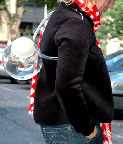
Fruitfly Farm
The Fruitfly Farm is Laura Beloff's second piece in the same series as The Head, a "wearable sculpture" with a connection to the internet, a camera and a public access via sms. The both pieces have a similar technical structure, which is accessible for the audience via mobile phones.
But while The Head is observing outwards the surrounding society, the Fruitfly farm observes a full society in small scale -the fly nest. Both works address the society and surrounding environment as the their theme. The fact that they are wearables allows them to "live" among their audience.
Related: the Plant Backpack and the fabulous Beehive Hat, both by Harmut Stockter. [blogged by Regine on we-make-money-not-art]
Posted by jo at 11:29 AM | Comments (0)
Knifeandfork's
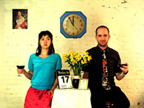
5 'til 12
The Beall Center becomes the site of a nonlinear narrative with Knifeandfork's immersive installation, 5 'til 12. The visitor is invited to watch four characters, on four monitors, as they recount the tragic circumstances of the exhibition's opening night. The experience is unique for each visitor, as each story has most likely never been heard before... and won't ever be heard again. The installation uses RFID (Radio Frequency IDentification) cards to identify individual visitors. When each new visitor swipes a card, a new story is selected, and the visitor is recognized as he or she explores the narrative space. [Quicktime video]
The premise is derived from Akira Kurosawa's film Rashomon, in which four eyewitness accounts of a murder are presented to the viewer, who serves the role of a magistrate. The contradicting stories reveal that objectivity is elusive, as each individual cannot help but infuse his story, consciously or not, with personal shame and ambition. It is unclear who is lying, or if it matters. Each story holds a valid reality of its own, a subjective truth that reinforces a desired identity. However, perhaps there could be another layer: in addition to stories that differ between tellers, might an individual's story change with each new telling? 5 'til 12 proposes that we evolve multiple narratives as we explore multiple identities.
The process is inspired by the Oulipo literary movement, in particular the canonical piece by Raymond Queneau, One Hundred Thousand Billion Sonnets, in which 'potential' literature emerges when lines of words are spliced and recombined. 5 'til 12 draws from the artists' own journals, fantasies, and parodies, all of which are algorithmically assembled to create an enormous number of potential personas for each character.
Stories are selected from the possibilities in rounds, using a programmatic variation on the Prisoner's Dilemma, a model from game theory where individuals choose to cooperate or not in order to maximize their own personal advantage. Seeking to portray themselves in the best possible light, the characters must choose to be complimentary, neutral, or vindictive toward each other. A character who appears confident and blameless while illustrating everyone else's faults will 'score' the highest. However, in the following round, he or she can expect revenge and must eventually make amends. The strategy of each character is adapted using an evolutionary algorithm according to its effectiveness in each round.
Beall Center for Art and Technology, Irvine, CA, US
2006 January 18 - March 15
Opening reception January 17, 6-9 pm
Posted by jo at 10:21 AM | Comments (0)
Make Art

Centred on the Blurred Line Between Artists and Software Developers
Organised by Goto10, Make Art is a festival dedicated to the integration of "free and open source" software in electronic art. Starting the 24th of January 2006, artists and programmers will take the audience on a journey through this emerging culture via concerts, conferences, software presentations, exhibitions and a workshop.
Make Art is centred on the blurred line between artists and software developers. With the emergence of Internet and the democratisation of computers, the general public is more and more often confronted with hybrid software conceived by qualified artists with strange and varied titles: programmer artists, software artists, digital artists, (new)media artists... They conceive their own creative tools or work hand in hand with the software programmers, contrarily to those who commission technicians and other ghost programmers.
If the question of the artist technician isn't a new one, you can now count on the presence, in the midst of this chaotic and creative digital fauna, of certain individuals who take the step of electronic creation consciously accompanied by a political gesture, that of the use of open source software.
Open source software is computer programmes that can be used by all and for all use, and are distributed with their source code, allowing everyone to study, distribute, modify and improve them, without necessarily asking the author (several free licenses exist). On the contrary, the source code for proprietary software is inaccessible, and the proprietary licenses limit the software to a very precise use.
Beyond the purely technical aspect of the open source world, there are a counter culture's social and economical stakes. A culture born of the technological boom that better understands the ins and outs of electronic power struggles in the post-industrial societies.
At a time when intellectual property is fiercely debated, while some people cling on to their little bits of territory, others have chosen to share knowledge, art and collective work.
Make Art constitutes a tool for reflecting on the propagation of free software in artistic creation and we want it to be a view onto the social, political and economic myths and realities linked to this phenomenon.
Posted by jo at 10:10 AM | Comments (0)
Computational Poetics at Upgrade Vancouver
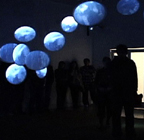
One River (running)
Join us Thursday, January 26th at 8pm for a discussion with Kenneth Newby, Martin Gotfrit, Aleksandra Dulic and Dinka Pignon, who will show us One River (running) and talk about their work with the Computational Poetics Research Group. As always, we will adjourn after the talk to the Whip Gallery [209 east 6th avenue] for a drink and some chatter.
One River (running) is an interactive, immersive audio environment designed to create both a visual and audio experience of rivers using a complex system of moving sound, moving images, and a physical structure also designed to echo the river¹s undulating geographic form. The artwork¹s images originate from digital photographs of people¹s mouths whom the team interviewed. These still images were then algorithmically programmed. The mouths recognize the voices, and move as though they are speaking the words they hear. The artists created a voice recognition software program to do this synchronization. The video is listening and responding to the audio. The piece was recently exhibited at the Surrey Art Gallery.
Kenneth Newby, Martin Gotfrit and Aleksandra Dulic are part of the Computational Poetics Research Group, a research project that works at the intersections of art, culture and computation and aims to articulate some of the features of an emergent poetics of digital art performance while developing a tool-set to enable artists working in the computational medium to create, present and document their work. A key objective of their work is to share the compositional process and the issues that arise in the work of interdisciplinary computational media performance. Contemporary computational techniques enable creative and performing artists to enter into new collaborative relationships with encoded systems.
Upgrade! Vancouver
When: Thursday, January 26 at 8pm
Where: Western Front, 303 East 8th Avenue, Vancouver, Canada FREE! Everyone welcome.
Posted by jo at 09:39 AM | Comments (0)
*HTTL:// Hacking the Timeline/EZTV:

Digilantism and the LA Digital Arts Movement
18th STREET CENTER Presents: *HTTL:// Hacking the Timeline / EZTV, Digilantism and the LA Digital Arts Movement--Exhibition of Digital Art in Print, Video and Installation *Victor Acevedo, Rebecca Allen, Denis Brun, Dave Curlender, Michael Dare, Loren Denker David Em, Kit Galloway, Kate Johnson, Tony Longson, Robert Lowden, Michael Masucci, Sherrie Rabinowitz, Nina Rota, Carolyn Stockbridge, Anneliese Varaldiev,* *Michael Wright; February 4 - April 8, 2006: OPENING RECEPTION: Saturday, February 4, 6-8:30pm.
"It has been said that the widespread adoption of personal computers is the most significant single cultural advancement since the invention of the printing press, allowing not only for the personalization of production, but also for the development of distribution channels which cross borders, cultures and time zones. At the present time podcasting, ‘blogs, text messaging, mobile devices and interactive websites introduce audiences to artists whom they would have never been offered through the traditional gallery or museum community.
Based on the accomplishments of the last half-century, the last quarter century has seen more widespread adoption of ideas, methods and possibilities, spearheaded by small clusters of artists around the world from Croatia to Germany to Japan to the U.K. Moreover, numerous major technical, design and production innovations were originated in California. Los Angeles has been a central hub in the history of the desktop digital art movement.
By time the 1980s and 90s came about, artist-run spaces such as EZTV and Electronic Cafe International (ECI) served as the meeting grounds for artists, engineers and intellectuals who dared to see the computer as a primary artmaking tool of the 21st century. These spaces combined experimentation and exhibition of a wide range of media work, from wall art to video projection to live performances utilizing media tools. Today, writers, architects, musicians, painters, photographers, filmmakers and even sculptors have all gravitated to this notion, one not so widely accepted or obvious 25 years ago yet now taken as a given. Today digital art is ubiquitous, but its roots are still, all too often, invisible.
This exhibition focuses on some of these key individuals involved in the creation, advocacy and exhibition of seminal digital art exhibitions over the last 25 years in Los Angeles. Many of these shows included artists who were among the very first to publicly articulate a unique digital and desktop aesthetic. They have served as activists who have spearheaded a dialogue between mainstream and experimental artmakers and who brought journalists and scholars alike into an awareness of the emergence of an international digital culture. From David Em's pioneering experimental artworks created at historical places such as Xerox PARC and JPL to EZTV's development of a desktop video and microcinema tradition to ECI's experiments in telecommunication arts to the work of the Digilantes, a term coined by artist/educator Michael Wright, who along with Victor Acevedo staged many guerilla style exhibitions and became a local force for Los Angeles digital art. Their concept of Digilantism, which they not only apply to themselves but also to the efforts of places such as EZTV and other artists/activists worldwide, best describes an art movement as genuine as Futurism, the Arts & Crafts Movement or Hip-Hop." Michael Masucci, 2006
*_Schedule of Events_:
*ArtNight Opening Event, Saturday, February 4th, 4-6pm--Artist Presentation with Denis Brun and Michael Masucci 6-8:30pm; Opening Reception 7:30pm Performance by Collage Ensemble Inc.
Panel Discussion: Thursday, February 9th, 7pm--Hacking the Timeline: The Digilante Movement; Michael Wright and Victor Acevedo
Panel Discussion: Saturday, February 11th, 2pm--Hacking the Timeline: The Untold Story of Digital Art; Moderated by David Plettner with David Em, Peter Frank, Sandra Tsing Loh, and Michael Masucci
Panel Discussion: Saturday, April 8th, 2pm-- John Dorr and the Legacy of EZTV; Moderated by Strawn Bovee with Nina Rota and S.A. Griffin
For extended artist bios, more images and full artists' and curator's statement see: Web sites, <_http://www.eztvmedia.com/httl.html_> or <_http://www.18thstreet.org_>
Hacking the Timeline is funded by a grant from the James Irvine Foundation.
18th Street Arts Center*
*1639 18th St., Santa Monica, CA 90404 Phone 310.453.3711 Email, <_mailto:office[at]18thstreet.org_> Web sites, <_http://www.eztvmedia.com/httl.html_>;
<_http://www.18thstreet.org_>
Hours: Monday -Friday, 10am - 5pm
Posted by jo at 09:08 AM | Comments (0)
Choreographing the Extended Agent:
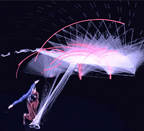
Performance Graphics for Dance Theater
"ABSTRACT:The marriage of dance and interactive image has been a persistent dream over the past decades, but reality has fallen far short of potential for both technical and conceptual reasons. This thesis proposes a new approach to the problem and lays out the theoretical, technical, and aesthetic framework for the innovative art form of digitally augmented human movement. Downie will use as example works a series of installations, digital projections, and compositions, each of which contains a choreographic component—either through collaboration with a choreographer directly or by the creation of artworks that automatically organize and understand purely virtual movement. These works lead up to two unprecedented collaborations with two of the greatest choreographers working today: new pieces that combine dance and interactive projected light using real-time motion capture live on stage.
The existing field of "dance technology" is one with many problems. This is a domain with many practitioners, few techniques, and almost no theory; a field that is generating "experimental" productions with every passing week, has literally hundreds of citable pieces and no canonical works; a field that is oddly disconnected from modern dance's history, pulled between the practical realities of the body and those of computer art and has no influence on the prevailing digital art paradigms that it consumes.
This thesis will seek to address each of these problems, by providing techniques and a basis for "practical theory"; by building artworks with resources and people that have never previously been brought together, in theaters and in front of audiences previously inaccessible to the field; and by proving through demonstration that a profitable and important dialogue between digital art and the pioneers of modern dance can in fact occur."
This thesis will achieve these goals because of its methodological perspective—that of biologically inspired, agent-based artificial intelligence—and the technical depth to which this idea is taken. The representations, algorithms, and techniques behind such agents are extended and pushed into new territory for both interactive art and artificial intelligence. In particular, this thesis will focus on the control structures and the rendering of the these extended agents' bodies, the tools for creating complex agent-based artworks in intense collaborative situations, and the creation of agent structures that can span live image and interactive sound production. Each of these parts becomes an element of what it means to "choreograph" an extended agent for live performance." --Choreographing the Extended Agent: Performance Graphics for Dance Theater by Marc Downie, OpenEnded Group.
MARC DOWNIE is an artist and artificial intelligence researcher. He holds degrees in natural science and physics from Cambridge and media arts from MIT, and a PhD from MIT's Media Lab. Downie's complex algorithmic systems are inspired by natural systems and a critique of prevalent digital tools and techniques. His interactive installations, compositions, and projections have presented advances in the fields of interactive music, machine learning, and computer graphics.
The OpenEnded Group creates digital artworks for stage, screen, gallery, and museum, with a present focus on art for public spaces.
The collaborating artists in the group are Paul Kaiser, Shelley Eshkar, and Marc Downie.
Kaiser and Eshkar have collaborated on numerous projects since the mid-1990s, pioneering the use of motion-capture and "hand-drawn" 3D spaces and figures in installation and dance works. Of these, perhaps the best known are BIPED and Ghostcatching. Also acclaimed is their first public artwork, Pedestrian, which projects trompe-l'oeil figures and miniature urban landscapes directly onto city sidewalks.
Joining them in 2001 to create Loops, Downie expanded the creative and technical vision of the group, adding artificial intelligence and real-time graphics to the mix. Downie has pioneered a new approach to generative music and imagery with a series of artworks entitled Musical Creatures.
Though the three artists largely work together, they sometimes work in pairs, create solo artworks, and pursue collaborative projects with others.
The OpenEnded Group works repeatedly with certain key collaborators (architect, composer, electrical engineer, programmers), whose bios may be found in the Collaborators section. [via andrew on Grand Text Auto] [Related]
Posted by jo at 08:04 AM | Comments (0)
January 18, 2006
Mediaattori - Urban Mediator
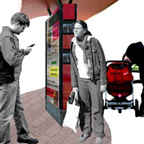
A Hybrid Infrastructure for Neighborhoods
Urban Mediator investigates the area of designing at the boundaries of digital and physical urban space. Its aim is to present cities with a direction for the future that addresses the possibilities presented by the interweaving of new digital technologies and urban space, for empowering people in shaping their own city.
The approach followed is not technologically driven but rather takes people’s everyday practices as the grounding point for the investigation. The design process is built upon dialogues with people and the urban environment as a way of gaining understanding of urban everyday practices and designing in harmony with them. The resulting design concept, Urban Mediator, illustrates a local and people-centered perspective for our urban futures. It proposes a hybrid infrastructure for urban neighborhoods.
The combined digital and physical framework gives people the possibility to engage in improving the quality of their everyday urban environments and their experience of these environments. The concept, presented through scenarios, is developed as a working tool for catalyzing discussion between different stakeholders that would be involved in a future proposal for collaborative design for cities. [via nicolas on pasta and vinegar]
Posted by jo at 12:53 PM | Comments (0)
Datasound Strip
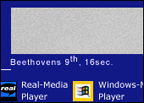
Datasound, the Printed Sound
The idea of sound on paper is not surprising thinking about the codification of the staff on the score. As the same time digitalization has made us used to the fact that data of different nature like images, sounds and words, can be stored through just one code. What is original is the idea of coming back to the original matrix of paper fiber to encrypt information. The Datasound Strip is an 18x55 mm, two-dimensional matrix code, consisting of millions of tiny dots that allow to securely encode thousand of bytes of user data. The code can be decoded using an handled mobile Strip Reader that, placed on the strip, converts the printed data in seconds to its original form Speech and music are played directly over a speaker, while pictures or text are downloaded to a connected PC. The system uses Advanced Audio Coding technology, one of the newest data compression techniques. The key applications are in security, but the most lively ones seem to be in promotion. With the Datasound it is possible to make paper or similar materials talk. This allows in-store promotions, coupons and marketing games, as well as it can make catalogues and packaging more lively and interactive. Waiting for the the first hack that would completely detourne it... [Valentina Culatti, neural]
Posted by jo at 12:41 PM | Comments (0)
MachineAria
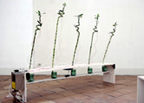
The Poetic Breath of the Machine
Why a plant equipped with electronic elements inserted on the stem become a poetic creature? Why and through which procedures objects in current use become meaningful channels vehiculating personal stories? MachineAria is an installation by Ruben Coen Cagli, that tries to solve the question, asking the visitor to have a contemplative experience of a hybrid ecosystem build up on modified electromechanical plants. Five plants are connected to five little motors, placed under the pots, and to the led arrays on the stems' top. The motors turn on and off sequentially, enabling the the vegetables' vibrations. They sway giving the impression of being caressed by a light breeze. So the air, a traditional and excellent element for inspiring poetry, takes shape thanks to the pure technological fiction. Actually everything can be potentially transformed in a stream of data, but only for humanizing it afterwards, in this case recreating the breath / caress sensation for the user. The idea of activating mechanical processes and then converting the generated data in sensorial experiences, rise from the will to explore all the possible alterations and extensions of technology in daily life. What happens then is skidding from the technological domain to the poetic one, where the latter is essential to the development strategies of innovation. [Francesca Tomassini, neural]
Posted by jo at 12:36 PM | Comments (0)
Mediamatic Workshop
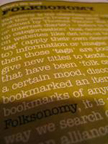
Mobtagging
Mediamatic presents a 2-day workshop on social tagging, or MOBTAGGING--15 & 16 February 2006 @ Mediamatic, Amsterdam--Mobtagging is what happens when users freely apply and exchange labels (metadata) to online information. This non-hierarchical method of structuring information is rapidly spreading over the web, with Flickr.com, Del.icio.us and Technorati as most famous examples. It gives users the possibility to specify, index and search information on their own terms.
During this workshop we will analyse the inner workings and the social effects of mobtagging. How is social tagging changing the structure of (online) information, and our relation to it? For which usergroups and what type of information is Mobtagging rewarding? What roles does Mobtagging play next to more traditional ways of indexing information?
This workshop is designed for bloggers, webmasters, artists and theorists; people with a practical as well as a theoretical interest in Mobtagging. Four cutting-edge speakers (see below) introduce various concepts and practises of social tagging, and assist the participants with the (re)design and evaluation of their own Mobtagging scenario's or applications.
Ulla-Maaria Mutanen (Finland): Ulla-Maaria currently studies the interface between industrial design and engineering at the Center for Activity Theory and Developmental Work Research in Helsinki. On her weblog Hobbyprincess.com she frequently writes about relationships between web resources and adding webstructures. She invented the idea (and software) of the ThingLink, a unique identifier that works as a link between things.
Jyri Engeström (Finland): As a PhD student at the Department of Organisation, Work & Technology at the Lancaster University Management School, Jyri is interested in the relationship between technical innovation and organizational transformation. He also is co-founder of Aula (www.aula.cc), a collective of creative minds who design and use mobile media to flock and blog, socialize and collaborate in geographic and virtual places simultaneously.
Duncan Speakman (UK): Duncan is a sound and video artist, and initiator of the first European videoblogging conference. He will zoom in on social tagging as the main structuring principle of video blogs.
The participation fee is EUR 300 (ex. VAT). For more information, questions or registration surf to www.mediamatic.net/mobtagging. You can also mail to workshops[at]mediamatic.nl, or call Klaas Kuitenbrouwer: +31 20 6389901.
Posted by jo at 12:00 PM | Comments (0)
January 17, 2006
PONG.mythos
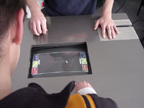
An Exhibition About 1 Ball, 2 Bats and Our life in a Digital World
[The Project] From 11 February to 30 April 2006 the Wuerttemberg Art Association in Stuttgart hosts the premiere PONG.mythos exhibition, curated by Andreas Lange. PONG.mythos presents over 30 works that revolve around the computer game Pong. Pong, in the early 70s, turned the simple game of tennis into the signal for the emergence of the computer game industry. Since then, it has developed from its historical origin in game halls to an important social, scientific and cultural reference system.
For the first time the complex manifestations of one of the largest and most popular establishment myths of our digital information society are united in one place; the pong.mythos exhibition shows artistic, popular and scientific works that expose how influential this little game has become. Over 20 international artists take up the Pong game and its myth directly. The exhibition moves consciously between the terrains of computer history, the entertainment industry, science and art; research projects that use Pong as an experimental playing field for future human computer interfaces are presented along with historical game consoles and a Pong game for the blind.
[The Artists] //////////fur//// (D), Ascii Art Essemble (NL/SLO), Ralph Baer (USA), Blinkenlights(D), Jaygo Bloom (GB), Blunty (AU),James Clar (USA) (tbc), Dirk Eijsbouts (NL), VALIE EXPORT (A), Kiia Kallio (FI), Stephan ST Kambor(D), Andrew Milmoe (USA), Mathilde MµPe (NL), Josh Nimoy (USA), Noel Nissen, (USA), Oska Software (AU), Alan Outten (GB), Niklas Roy (D), Leif Rumbke (D), Antoine Schmitt (F), Jan-Peter ER Sonntag (D), Olaf Val (D), buro vormkrijgers (NL), Philip Worthington (UK).
[THE MYTH] In 1972, when Nolan Bushnell founded Atari, the first video game company, to manufacture the Pong game console, he was hardly conscious of the historical dimension of this act. The emerging digital games also marked the beginning of the digitization of daily life. Computer games were the first applications with which many humans learned computer engineering. In this sense, Pong, apart from its meaning for computer games history, has a significant social value. The success of Pong stands - in the sense of concrete and transferred history - in direct connection with the development of our digital information society.
Opening: Friday, 10 February 2006, 19:00
11 February - 30 April 2006
Württembergischen Kunstverein, Stuttgart
Pong.mythos is a cooperation between the Computer Games Museum in Berlin, the Württemberg Art Association, The Games Convention/Messe, Leipzig, Kornhausforum, Bern and other partners.
Pong.mythos is funded by the German Federal Culture Foundation and has received support from the Royal Netherlands Embassy, Messe Leipzig and Migros Kulturprozent. After the premiere in Stuttgart, the exhibition will travel to Leipzig and the Games Convention (23.8. - 27.8.2006 ) and to Bern and the Kornhausforum (17.8.2007 - 16.9.2007).
[The Computer Games Museum] opened in 1997 with the first constant exhibition of the digital interactive culture. Since then, the award winning venture has organized or participated in 26 national and international exhibition projects. http://www.computerspielemuseum.de
[ANDREAS LANGE] Is the Director of the Computer Games Museum since 1997 and the curator of Pong.Mythos. After he studied Religious Science and Theatre at the Free University Berlin, he wrote His Thesis "The Stories of Computer Games - Analysed as Myths" (Berlin 94). Since then, Lange has worked as an exhibition maker, author, and researcher on the theme of digital entertainment culture.
[HANS D. CHRIST & IRIS DRESSLER] Directors of the Württemberg Art Association, attach "pong.mythos" to the award winning project" Artist's Computer Games" which they realized 2003 in co-operation with the curator Tilmann Baumgaertel in Dortmund.
[] [] [] [] [] [] []
Spokesperson: Andreas Lange
Email: lange@computerspielemuseum.de
Tel: +49 (0)30 29049215
www.pong-mythos.net
[] [] [] [] [] [] []
Württembergischen Kunstverein
Schlossplatz 2, D-70173 Stuttgart
Tel: +49 (0)711 22 33 70,
Fax. +49 (0)711 29 36 17,
info[at]wkv-stuttgart.de,
http://www.wkv-stuttgart.de
Posted by jo at 03:11 PM | Comments (0)
Constanza Silva
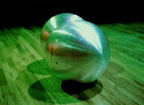
Silverfish Stream, Relational Sound Spheres
Constanza Silva is a new media artist who creates complex interactive environments where sound and robotic are the essential elements of a connected network. Silverfish Stream is her most recent artwork and, according to the author, 'it is a sensual, poetic, exploration of the potential of human-machine interaction'. Two aluminum spheres equipped with sensors occupy the physical space of a gallery, ready to react to inputs. The presence of the viewer modifies their initial state of immobility and becomes the input for the movement that seems to be autonomous. The two spheres roll on the floor interacting together like in a pas de deux choreography, but with a certain level of unpredictability caused by their slight unevenness and ridges. The viewer seems to be excluded from the movement, while he is the source of energy and an active part of the scene. The sound generated by the friction of the metallic robots against the floor, like that created by the contact between man and machine, is registered, altered and played in real time by the spheres, each with its own tonality, and amplified in the room. What is generated is a stream of multisensory information (visual, auditive, tactile), natural environment for mechanic creatures. Being the robots non-anthropomorphic clarifies the aim of Silva that is focusing the direction towards which the technological innovation is oriented within the human-machine interaction that is not a reproduction of human beings relations but a new kind of interaction. [Valentina Culatti, neural]
Constanza Silva is a new media artist who creates complex, sound and robotic environments by setting minimal forms in motion within networked, interactive systems. Since 1995, she has integrated performance, video, sound, and electro-mechanical elements to explore embodied experience and agency within natural, technological and political ecologies. The environments she creates are dynamic fields in which the concrete and the incorporeal—metal forms, fleshy bodies, information and sensation—pass into and transform each other.
Silva holds an MFA from Concordia University, Montréal and a BFA from the Emily Carr Institute of Art and Design in Vancouver. Her works have been exhibited in Vancouver, Toronto and Montréal. Over the last decade she has participated in numerous projects, exhibitions and performances, some of which include: Iguana/Iguana Confirmed (2004) Techno experimentations in gallery, DARE-DARE, Montréal; Sin ruido, en memoria (2002), Transito, Marché Bonsecours, Montréal; and Flagrante Delicto (2001), Planet In Focus, the Toronto International Environmental Film and Video Festival. She has received awards from private foundations, the B.C. Arts Council, le Centre interuniversitaire des arts médiatiques, and the Canada Council for the Arts. Silva was born in Colombia and raised in Canada. She is currently working and residing in Montréal.
Posted by jo at 09:55 AM | Comments (0)
January 16, 2006
e-Creative Practitioners and Change-Agents
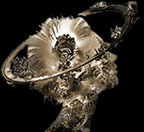
CeC & CaC 2006
An unprecedented range and number of e-Creative Practitioners and change-agents from around India and the world are gathering at the India International Centre in Delhi over the last weekend of January 2006, for the first Carnival of e-Creativity & Change-agents Conclave (CeC & CaC 2006, pron. 'Sek & Sak'). The event, presented by the IIC in association with The Academy of Electronic Arts, will feature screenings, performances, installations and interactions spread across several venues of the IIC main-campus and annexe.
CeC & CaC will be largely open to the public, and visitors are encouraged to bring along their own laptops to launch breakout sessions with their own works. See: participant list and schedule.
Presented by: India International Center and The Academy of Electronic Arts. Digicult presentation sponsorship by: Italian Embassy Cultural Institute and supported by: Fondazione Bevilacqua la Masa - Comune di Venezia
For more information:
IIC ~ Ms. Lalsawmliani Tochhawng (Teteii): ltochhawng[at]gmail.com
The AeA ~ Shankar Barua: shankarbaba[at]vsnl.net
Posted by jo at 07:04 PM | Comments (0)
Harvestworks

Technology for Dancers and Choreographers
This semester, Harvestworks concentrates on technology for dancers and choreographers. Real-time video playback, signal-processing for video, live camera tracking, audio-visual interaction does not have to be for the tech specialists only. Here's what's happening in the next few months:
1) This Thursday Alain Bauman from "Konic Thtr", a multimedia dance company in Barcelona, will do a free presentation of a few of their projects and discuss technical and aesthetical issues--see the details below; 2) Next week Wednesday, January 25th, Marlon Barrios-Solano, who will teach the class "Interactive Technology For Dancers", will present a few of his projects as well. This free presentation should give you a good overview of the issues discussed in his class; 3) The class "Interactive Technology For Dancers" will be three Mondays, March 27th, April 3rd and 10th.
Space is limited - please RSVP info[at]harvestworks.org
THURSDAY, JANUARY 19th, 6:30-9:30pm
ALAIN BAUMAN - INTERACTIVE DANCE TECHNOLOGY AT KONIC THTR, BARCELONA
HARVESTWORKS - 596 Broadway, #602, New York, NY 10012 Broadway/Houston, W/R Prince, F/V Broadway/Lafayette, 6 Bleecker.
Alain Baumann is a musician, multimedia artist and researcher. He is in charge of the development of the interactive systems used by Konic thtr. Konic Thtr is a multimedia label based in Barcelona (Spain), run by Rosa Sanchez and him, that is specialised in the creation of artistic projects that incorporate real time systems. It develops exhibition pieces and live performances that rely upon interactive technology, audiovisual and multimedia languages, music, theatre and dance.
In this presentation at Harvestworks he will discuss and present various projects of Konic Thtr. They work specifically in the research and the relation between stage, dance and technology. Since the year 2000 they have developed a close collaboration with Nuria Font and her projects linked to Image, Dance and New Media. In 2001 they took part in directing the "Laboratory of Motion Capture". In 2002 they won financial support for the production of the video Blank e_motive from the 'Mostra de Videodansa' call for projects. In 2003 they were guest artists in the international seminar "Virtualities of digital body". they were also speakers in the seminar "Dance and Technology" at the CaixaForum Mediateca (Barcelona) in February 2004 and they took part in the international meetings "Movements and Digits" last Autumn at l'Animal a l'Esquena creation centre.
Harvestworks is a nonprofit Digital Media Arts Center that provides resources for artists to learn digital tools and exhibit experimental work created with digital technologies. Our programs are made possible with funds from mediaThe foundation, New York State Council on the Arts, the National Endowment for the Arts, the NYC Dept. of Cultural Affairs, Materials for the Arts, The Experimental TV Center, the Mary Flagler Cary Trust, the Aaron Copland Fund, The Greenwall Foundation, the Jerome Foundation, Foundation for Contemporary Performance Arts, JP Morgan Chase Foundation and the Rodney White Foundation.
HARVESTWORKS Digital Media Arts Center
596 Broadway, Suite 602 (at Houston St)
New York, NY 10012
Tel: 212-431-1130
http://www.harvestworks.org
info[at]harvestworks.org
Subway: F/V Broadway/Lafayette, 6 Bleeker, W/R Prince
Posted by jo at 06:33 PM | Comments (0)
Outpost for Contemporary Art

CFP: Fair Trade
Calling All North American Artists: Outpost for Contemporary Art is pleased to invite artist proposals for a group series called "Fair Trade" that will take place in Los Angeles in Fall 2006 at sites appropriate to each accepted proposal. Deadline: February 13, 2006.
The goals for "Fair Trade" are: 1. To activate untraditional and/or underutilized space in Los Angeles to promote artistic experimentation to a broader public 2. To develop positive and productive collaborations with artists to produce projects that are speculative, intellectually challenging, and risk-taking 3. To consider how the three nations of the North American continent assert strong identities while simultaneously engaging in mutually beneficial partnerships.
As with Outpost's past collaborations with individual artists and artist groups, appropriate sites will be found for each accepted proposal we facilitate. Projects that are event-oriented and either participatory in nature or geared toward activating public space will be favored. All projects will be coordinated to occur over a set period of time in Fall 2006 and to take place in untraditional spaces and/or in collaboration with other organizations throughout Los Angeles. Download guidelines at http://www.outpost-art.org/calendar.php
Posted by jo at 03:28 PM | Comments (0)
Generali Foundation, Vienna
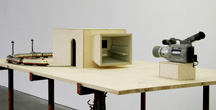
Cinema Like Never Before
Generali Foundation, Vienna: Cinema Like Never Before--20 January through 23 April 2006: With works by Hartmut Bitomsky, Gustav Deutsch, Isabell Heimerdinger, Astrid Küver, Constanze Ruhm, Krassimir Terziev, Nadim Vardag, Klaus Wyborny, Stephen Zepke as well as Antje Ehmann and Harun Farocki. Curated by Antje Ehmann and Harun Farocki
Film pictures in exhibition spaces have longest been taken for granted. Reason enough to more closely examine the origin of these pictures. What is seen in cinema and in which way? How does the medium of film function and what rules does it follow? The author and filmmaker Harun Farocki and the film academic and artist Antje Ehmann have been invited by the Generali Foundation to use the exhibition space for cinema and film analysis.
Cinema like never before is to be perceived as a cinematographic laboratory. Film is brought into the exhibition space without simulating a situation of cinema. Similar to an editing room, takes are weighed and evaluated, cutting frequencies established, and principles of structure and composition analyzed. Archetypes and recurring patterns in film history are addressed and cinema’s technological determinants and conditions of perception are investigated. The exhibition brings together analytical and artistic practices that further contemplate cinema in the art space and contribute to a different understanding of film.
As opposed to other film exhibitions, it is not the predominant issue here to cele-brate the myth of cinema.
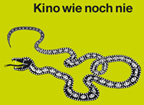
Cinema like never before is a film exhibition that does not show complete films, but elucidates film language by means of photographic series, slide se-quences, and sequential montages. With photographs, stills and moving images, the exhibition intends to provide a chance to study films as it is otherwise done in cutting rooms and seminars, but always with a great deal of explanation. In contrast, the idea here is to detach analyses of images from a discursive framework, instead allowing them to unfold by virtue of conceptual sequences of images.
Numerous contributions of the artists, filmmakers and authors were specially developed for the exhibition. Among them an installation by Hartmut Bitomsky, one of Germany’s most prominent documentary filmmakers, which presents death as an axiom of cinema.
Accompanying Publication: Edited by Antje Ehmann and Harun Farocki, published by Sabine Breitwieser for Generali Foundation, Vienna. Verlag Buchhandlung Walther König, Köln, German/English.
Generali Foundation
Wiedner Hauptstrasse 15
1040 Vienna, Austria
http://foundation.generali.at
Generali Foundation Collection online!
Artistic and Managing Director: Sabine Breitwieser
Press Office: Carmen Buchacher +43 1 504 98 80-24 found.presse[at]generali.at
Posted by jo at 12:08 PM | Comments (0)
Collaboration Opportunity
Looking for Nine Fiction Writers
"I’m looking for nine fiction writers who want to collaborate with me on an artwork that has been commissioned by Turbulence.org. I don’t want to give too much away, but I can say that the work will involve writing collaborative, improvisational fiction online. I can’t honestly say how good the final product will be, but I think it’ll make a fascinating experiment—provided, of course, I’m lucky enough to have good writers to work with.
Each writer will receive a $200 stipend for participation. Participating in this artwork will require a light, but ongoing commitment: perhaps an hour a week, from March to June.
No particular experience, or publications, are necessary. However, you should be mildly comfortable with technology, enough to use a website like MySpace or a blog host like Blogspot. It would also be okay if you had a friend who could help you with the technical stuff. Basically, the project involves a little tech setup, and I don’t want to have to do a lot of tech support for other people.
If that doesn’t sound too maddeningly vague, please let me know if you’re interested by emailing me at sera[at]fhwang.net. I’d appreciate a few writing samples, and if you have any experience with improvisational anything (stand-up comedy, music, even live-action role-playing), it’d be useful to know about that, too. Also, please feel free to ask any other questions. Thanks!"--Francis Hwang
Posted by jo at 10:43 AM | Comments (0)
MASTERS STUDY IN CHOREOGRAPHY
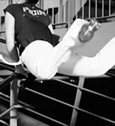
NEW MEDIA IN AMSTERDAM
MASTERS STUDY IN CHOREOGRAPHY/NEW MEDIA IN AMSTERDAM: OVERVIEW Established in 2002, Dance Unlimited (DU) Amsterdam is a unique two-year masters program* supporting the study of the relationship between choreography, performance and new media technologies. The program takes the development of choreographic work as its starting point, and new media technologies and practices are approached from this perspective. Theoretical and critical reflection is used as a means to challenge and support the practical work; and collaboration is emphasized. The DU staff comprises internationally known artists and researchers: Scott deLahunta, Sher Doruff, Jeroen Fabius (coordinator), Thomas Lehmen and Susan Rethorst.
CURRICULUM FORMATS: The program makes use of a wide range of curriculum delivery formats including: lectures, symposia, seminar, workshops, tutorials, reading and writing, mentoring and networking, studio-based research, etc. Within this a very active independent attitude is demanded from the student in the organisation of his or her own line of investigation. This 'independent study' comprises the main ingredient of the program.
CURRICULUM CONTENT: At the core of the curriculum is exposure to a range of new media technologies and practices overlapping with intensive choreography workshops. The aim is to develop sensitivity toward forms arising from the interplay between technology and choreographic practice. From here, students develop their own approach to practice based research and the making of artwork in a variety of formats. Introduction to possible collaborators and contexts for the presentation of finished artwork form another key part of the curriculum. In addition, the continuation of professional opportunities for the tudent after graduation remains an important concern throughout the two years with advise in this area provided on an individual basis.
FACILITIES AND TRAINING: DU Amsterdam accepts only four new students every two years, and this means access to facilities and staff is optimal. The program has its own dedicated rehearsal and computer studios and access throughout the year to the largest performance spaces in the Theaterschool. Elsewhere in Amsterdam there are several venues with which the program has a special relation, in particular the Melkweg Theatre, and students are assisted in showing their work in this wider public context. The program does not provide sustained training in complex hardware and software. The student is expected to come with a certain level of experience with the media they wish to explore and/ or be prepared to pursue a self-teaching path. As mentioned, students will be advised and supported in establishing collaborative connections with a range of partner organizations specializing in aspects of new media technologies and practices (e.g. such as Waag Society for old and new media, STEIM studio for electro-instrumental music and various media arts education programs).
FOR 2006-2008: We are looking for artists with a solid educational and professional dance background who wish to engage in a study of the relationship between choreography, performance, and new media technologies. However, we recognize that in areas of arts practice involving new media technologies such as locative media, robotics, and other non-screen based work an interest in movement and choreography may have come into play. As we re engaged in such overlaps, applications can be considered from candidates with these backgrounds who can give strong reasons for wishing to participate in a program that takes the choreographic mind/ body as its starting point and would be prepared to immerse oneself in collaborations with the other students who will have choreography and dance as their primary artistic practice.
APPLICATION DATES/INFORMATION
The program is ACCEPTING APPLICATIONS NOW for the September 2006 start. The application Deadline has been extended to 20 February 2006. A selected group will be invited for the audition in April. More general information and Registration Forms are available on this website.
CONTACT: Questions please contact the secretary: Ellen van Haeringen email: e.vanhaeringen[at]ahk.nl / tel: +31 20 527 7648 / fax: +31 20 527 7642
* Currently the program is postgraduate, but will be validated as a Masters from 2007
DU Amsterdam is part of a collaboration providing advanced study in choreography in the Netherlands with the Dance Academies of Rotterdam, Codarts and Arnhem, Artez.
Posted by jo at 10:23 AM | Comments (0)
Ambient Devices, Networked Objects
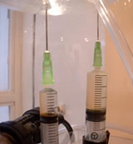
Life Event
Have you heard of Ambient Devices? They make networked objects that kind of glow based on stock-market data or weather information. Tobie Kerridge though has created Life Event, a networked object in a league of its own.
Life Event tracks the status of a prisoner on death row in Texas, using the Justice Department website. When the execution of prisoner 990 is reported on the site, the object will turn on. Brine shrimp - or Sea Monkeys - are injected into the salt water, a pump and light source are triggered and the organisms will be fed periodically by the second syringe. A living environment is initiated as a result of the execution. Until that time Life Event is mechanically and biologically dormant. [blogged by Chris on Pixelsumo]
Posted by jo at 09:50 AM | Comments (0)
REMINDER - Registration Deadline
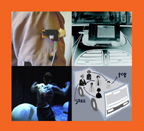
THIRD INTERNATIONAL WORKSHOP ON MOBILE MUSIC TECHNOLOGY
Registration Deadline-20 January 2006: Third International Workshop on Mobile Music Technology, 2-3 March 2006, Brighton, UK.
Combining mobile technology and music promises some exciting developments in a rapidly emerging field. Devices such as mobile phones, walkmans and iPods have already brought music to the ever-changing social and geographic locations of their users and reshaped their experience of the urban landscape. With new properties such as ad hoc networking, Internet connection, and context-awareness, mobile music technology offers countless new artistic, commercial and socio-cultural opportunities for music creation, listening and sharing. How can we push forward the already successful combination of music and mobile technology? What new forms of interaction with music lie ahead, as locative media and music use merge into new forms of everyday experiences?
Following two successful workshops that started to explore and establish the emerging field of mobile music technology, this third edition offers a unique opportunity to participate in the development of mobile music and hands-on experience of the latest cutting-edge technology. [more]
Posted by jo at 09:35 AM | Comments (0)
HOSTS
![]()
An Interactive Cinema work for Bath Abbey
Supported by Bath Film Festival 2005--Bath Abbey Church, 9th-27th February 2006, Monday-Saturday 10am-6.00pm.
HOSTS is an ambitious project inspired by the motif of Jacob's Ladder on the West front of Bath Abbey. Bristol-based media artist Martin Rieser will hang five giant screens at strategic points of the Abbey space. Wearing a special ultra-sound badge and wireless earphones, the participant in HOSTS triggers the presence of a variety of evanescent projected video characters. As the participant approaches a screen, these individual characters or messengers appear to move forwards from a deep space and come into focus. If the participant then moves on, the characters too pass onwards from screen to screen, keeping pace with them. In this way, once a participant has entered the installation they become part of the story space. By standing in front of a screen they will eventually be paired with and addressed directly through a series of aphorisms by their individual messenger.
HOSTS combines poetry performance, animation and cinema in a unique blend. The words of the spoken and animated aphorisms are apparently those of humans, fraught with ambiguity and misunderstanding. Perverse and fragile, the aphorisms hover between the portentous and the mundane, inflected over and over into different meanings by the messengers. We are captured by the messengers and hurled into their drama in the same way that an unwilling passenger in a train can be given someone's life story. This is not always a comfortable experience. HOSTS is intended as a spiritually enhancing experience for a broad audience, not usually drawn to a media art gallery.
HOSTS is a major multidisciplinary exercise involving film-makers, animators, programmers, electronic engineers, lighting /cameramen, professional actors, and social scientists. The sensor developments have already been made in partnership with Bath University's Wearables Group. Support has been given to the project by Bath Spa University under their research enhancement funding, since this project lines up with the work of the CTOL research group (Critical Topologies of Landscape) and with an AHRB Study award. Bath Abbey and The Bath Film Festival are also supporting the Project.
HOSTS represents a step-change in the way cinema can be made interactive for a mobile audience. It combines the latest technology with innovative creative ideas.
A disk of supporting visual material (Jpegs and QuickTime) is available on CD by request.
Contact Details: Martin Rieser
Tel: 0117 9731041 Mob: 09766766429
e-mail: martin.rieser[at]gmail.com
Posted by jo at 09:00 AM | Comments (0)
Call of Interest:
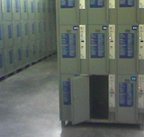
Locative Media: Rautatieasema returns Workshop
Monday 27th March – Saturday 1st April 2006 as part of PixelACHE festival of electronic arts and subcultures 2006, Helsinki.
Acknowledging the recent contemporary past, the workshop aims to engage with the Central Railway Station site in Helsinki, and will begin with considerations upon what happened last time at the same site during PixelACHE 2004. On that occasion, approximately 20 international media and performance artists, activists, archaeologists and researchers spent 5 days exploring overlaps in ‘capture-gathering’ methods and site-documentations.
However, this time participants will be given a key to a locker in the railway station. What you find inside, will be something to begin with. Hence the reiteration of the Locative Media Workshop in the context of PixelACHE2006 focuses activity towards devised performance; to ethnographic, storytelling and interpretative approaches; to reiterations and representations.
Local, regional and Nordic/Baltic persons are encouraged to apply for participation: Please send an e-mail with the following information to locative[at]pixelache.ac by January 31st. Write about your interests and works in locative/site-specific arts (Max. A4).
Posted by jo at 08:11 AM | Comments (0)
Meshworks

Typing Shapes Performance
"This is a streaming video of a performance I did recently at Miami University in Ohio. It gives a fairly good idea of the screen (although blurred of course compared to the original). I'm in the room, silent, responding to the audience, and typing. The typing at the bottom of the screen is live, as is my choice of materials to run. At times, there are 11-12 Qt files open at once. By choosing materials, typing, I shape the performance."--Alan Sondheim
Meshworks was performed at the Leonard Theater, 12/1/2005.
Alan Sondheim is a multi-media artist working in written text, video, sound, and image. For the past twelve years he has been continuously writing a meditation on what it means to be "online"--a meditation that has carried him endlessly in and out of language.
His readings are a kind of one-screen laptop performance; he projects the screen as well as sound. The images are from short looped videos that appear to interact with each other. He writes live text at the bottom of the screen to accompany them. The whole thing is an improvisation.
Maria Damon writes that "In performance, Sondheim, who comes from the body-art/industrial music scene of the 1970s and 80s New York City, and who is usually associated with artists like Vito Acconci and Kathy Acker, has taken issues of process so deeply to heart that each time he presents at a conference or reading he creates a spontaneous, one-of-a-kind event: he displays videos and photographs, and plays soundtracks accompanied by his live, real-time typing response along the bottom of the screen onto which the foregoing are projected. The music is his own: frantically fast guitar-playing, distorted pipe-organ drones, or other common or rare instruments recorded and warped for use in this self-ensemble. Often there are four things to look at simultaneously -- more than one of them is moving -- as well as a compelling -- overpowering, in fact -- sound component that drives the piece rhythmically." [via netbehaviour]
Meshworks: The Miami University Archive of Writing in Performance--Meshworks is a site dedicated to documenting and preserving video and sound recordings of writing in performance. The site’s title is taken from an essay by cris cheek in Additional Apparitions: Poetry, Performance, and Site-Specificity: “Each poetry reading is a meshwork, a gathering, of differentially inflected components.”
Posted by jo at 08:03 AM | Comments (0)
January 15, 2006
Call for Entries: Turbulence New England Initiative II

Net Art :: Hybrid Networked Art
Turbulence.org is pleased to announce its New England Initiative II, a juried, networked art competition. Three projects by New England artists will be commissioned and exhibited on Turbulence and in real space (venue to be announced). Each award will be $3,500. The jury consists of Julian Bleecker, Michelle Thursz, and Helen Thorington. This project is made possible with funds from the LEF Foundation.
PROJECT CONCEPT: Net art projects are "art projects for which the Net is both a sufficient and necessary condition of viewing/ expressing/ participating" (Steve Dietz). They live in the public world of the Internet. Recently, however, wireless telecommunications technologies have enabled computation to migrate out of the desktop PC into the physical world, creating the possibility of “hybrid” networked art, works that intermingle and fuse previously discrete identities, disciplines, and/or fields of activity such as the Internet and urban space. (See the networked_performance blog, specifically the categories "Locative Media" and "Mobile Art and Culture.") Borders are disintegrating and new identities are emerging. We encourage applications by net artists and artists working on networked hybrid projects.
PROJECT TIMELINE:
Proposal Deadline: February 28, 2006
Selected Projects Announcement: March 15, 2006
Project Launch/Exhibition: October 1, 2006
SELECTION CRITERIA: (1) artistic merit of the proposed project; (2) originality; (3) degree of performativity and audience participation; (4) level of programming skill and degree of technological innovation; and (5) extent of collaborative and interdisciplinary activity.
PROPOSAL GUIDELINES:
(a) Your name, email address, and web site URL (if you have one).
(b) A description of the project's core concept and how it will make creative use of digital networks (500 words maximum).
(c) Details of how the project will be realized, including what software/programming will be used. Specs for the Turbulence server are available at http://www.turbulence.org/comp_05/server.htm. You may request additional software but we cannot guarantee it.
(d) Names of collaborators, their areas of expertise, and their specific roles in the project.
(e) A project budget, including other funding sources for this project, if any.
(f) Your résumé/CV and one for each of your collaborators.
(g) Up to five examples of prior work accessible on the web.
Email submissions (the web site URL) to turbulence@turbulence.org with NE 2 in the subject field.
JUROR BIOGRAPHIES:
Julian Bleecker has been involved in technology design for over 15 years, creating mobile, wireless, and networked-based applications across a diversity of project idioms including entertainment, art-technology, brand marketing, university research and development, interactive advertising and museum exhibition. His expertise is technology implementation, innovation and concept development. Bleecker is currently Visiting Assistant Professor at the University of Southern California's Interactive Media Division and Critical Theory departments, and is participating in a research group at the Annenberg Center's Institute for Media Literacy exploring the future of mobile technology applications. He has a Ph.D. from the History of Consciousness Board at the University of California Santa Cruz, a Masters of Engineering from the University of Washington, Seattle, and a BS in Electrical Engineering from Cornell University.
Helen Thorington is co-director of New Radio and Performing Arts, Inc. (aka Ether-Ore), the founder and producer of the national weekly radio series, New American Radio (1987-1998), and the founder and producer of the Turbulence and Somewhere websites. She is a writer, sound composer, and radio producer, whose radio documentary, dramatic work, and sound/music compositions have been aired nationally and internationally for the past twenty-three years. Thorington has created compositions for film and installation that have been premiered at the Berlin Film Festival, the Whitney Biennial, and in the Whitney Museum’s Annual Performance series. She has produced three narrative works for the net, and the distributed performance Adrift which was presented at the 1997 Ars Electronica Festival and at the New Museum in New York City, 2001, among other places.
Thorington has also composed for dance and performed with the Bill T. Jones/Arnie Zane Dance Company at Jacob’s Pillow, MA in 2002, and at The Kitchen, New York City in 2003. She won two radio awards in 2003 for her 9_11_Scapes composition; and was recently commissioned by Deep Wireless, a Toronto radio festival, to create Calling to Mind. Thorington has lectured, presented on panels, and served as a juror on many occasions. Her recent articles on networked musical performances include “Breaking Out: The Trip Back” (Contemporary Music Review, Vol 24, No 6. December 2005, 445-458); and “Music, Sound and the Networked_Performance Blog” for the Extensible Toy Piano Symposium at Clark University, Massachusetts, November 5, 2005.
Michele Thursz is an independent curator and consultant for art-makers and distributors. Her current project is Post Media Network; Post Media is a term and action demonstrating the continuous evolution of uses of media and their effect on artists practice, and culture-at-large. In 1999 she co-founded and directed the Moving Image Gallery, NYC. Moving Image Gallery was one of the first galleries to show electronic and computer-based mediums, exhibiting such artist as Golan Levin, Cory Arcangel and Yael Kanerek. Thursz’ recent curatorial projects include “Copy it, Steal it, Share it”, Borusan Gallery, Istanbul, and “Nown”, Wood Street Gallery, Pittsburgh; “public.exe: Public Excution”, Exit Art, NYC, and “Democracy is Fun”, White Box, NYC. She has written essays about contemporary art for catalogues and has lectured on contemporary art and curatorial practice. Thursz’s actions and exhibits have been reviewed and featured in the New York Times, Forbes Best of the Web, ArtByte, Wired News, Art Forum, and many international periodicals and web publications.
Posted by jo at 03:41 PM | Comments (0)
Chironomy
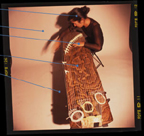
A Wiencouver Internet Performance
Western Front (Vancouver) and Kunstradio ORF (Vienna) present Chironomy: A Wiencouver Internet Performance (a prelude to Art's Birthday). Conceived by Miya Masaoka; Sunday, January 15, 2006 (5 pm Eastern Standard Time; 2 pm Pacific Standard Time; 11 pm Central European Time).
In Vancouver: Miya Masaoka (koto, laser koto, laptop), François Houle,(clarinet, laptop, lectronics), and Giorgio Magnanensi (electronics); In Vienna: Klaus Filip (laptop) and Burkhard Stangl (guitars, electronics). Both video and audio streams can be accessed here.
Chironomy is a project conceived by Miya Masaoka, (koto, laptop, LaserKoto, video) with François Houle (Clarinet, laptop, electronics) and Giorgio Magnanensi (electronics) in Vancouver and Klaus Filip (tube, lloopp software) and Burkhard Stangl (guitars and electronicdevices) in Vienna. This audio and video streaming project uses musicians performing remotely on different continents. Interactivity, improvisation,gestural communication and text are explored within the context of network culture, desire, expectation and alienation. Disembodied sound sources, unpredictable visual and rhythmic time delays, unintended synchronicity and other artifacts of streaming will be exploited.
from Vancouver: Webcam | mp3 Audio Stream http://lists.front.bc.ca/stream.php | from Vienna | mp3 Audio Stream at http://stream.sil.at:7562/listen.pls| Webcam. Concert in the Grande Luxe Western Front, 303 East, 8th Ave, Vancouver - 604-876-9343 Sunday, January 15 - Doors open 1:30 pm - Live stream 2 pm PST (11 pmCET in Vienna) Tickets $10/$5 at the door. FREE for Western Front members.
Miya Masaoka - musician, composer, sound-artist - has created works for Koto, laser interfaces, field recordings, laptop and video and written scores for ensembles, chamber orchestras and mixed choirs. In her pieces she has investigated the sound and movement of insects, as well as the physiological response of plants, the human brain and her own body. Within these varied contexts her performance work investigates the interactive, collaborative aspects of sound, improvisation, nature and society.
Masaoka's work has been presented in Japan, Canada, Europe, Eastern Europe and she has toured to India six times. Venues include V2 in Rotterdam, Cybertheater in Brussels, Elektronisch Festival in Groningen, the Cleveland Performance Art Festival, The Electronik Body Festival in Bratislava, Slovakia, Radio Bremen, Germany, Festival of Lights, Hyberadad, India, and the London Musicians Collective.
Posted by jo at 12:24 PM | Comments (0)
January 14, 2006
T a g g e d
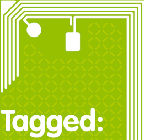
A hands-on RFID workshop
T a g g e d : A hands-on RFID workshop: Friday, February 10, 17, 24 and March 3; 10.30 – 4.30pm; at SPACE Media Arts.
Do you know how an Oyster card works? Or security stickers in shops? Even if you don’t know what a Radio Frequency Identification (RFID) tag is, you’ve probably used one – at the grocers checkout, on the bus, tracking a package or in your passport at the airport.
RFID is the barcode of the future. It is a unique identification code that can be tracked through radio waves, sometimes without human contact or knowledge. RFID may help create a real-life internet, where objects can communicate with each other to create complex networks, exchange useful information, and do things for you in every day life. But it could also have a huge impact on commercial industry, security and privacy.
Learn about electronics, art, technology, computer programming and more in this four-day, hands-on workshop. Find out exactly how RFID works, who is using it and what it means for you and your community. Experiment with the technology and imagine what you can do with it in art, industry and play… then get a head start on making it happen.
I n s t r u c t o r s
Paula Roush and Peter Chauncy
B o o k i n g
To book a place please email training@spacestudios.org.uk or call 020
8525 4330
C o s t
Free for participants between the ages of 17 – 25. Participants outside
this group £100 for 4 sessions. Payment is required in advance. Places
are limited.
V e n u e
SPACE Media Arts
129-131 Mare Street
Hackney
London, E8 3RH
T: 020 8525 4339
F: 020 8525 4342
E: spacemedia[at]spacestudios.org.uk
W: http://www.spacemedia.org.uk
SPACE Triangle is wheel chair accessible. If you have specific access requirements, please contact us in advance and we will try to accommodate them.
In partnership with Camden Arts + Business Consortium, Arts Council England, City Fringe Partnership, London Development Agency and NODE.London
Posted by jo at 11:52 AM | Comments (0)
January 13, 2006
Singing Bridges

Played Cables
Singing Bridges, by Jodi Rose, is a sonic sculpture, playing the cables of stay-cabled and suspension bridges as musical instruments. To create this work I will amplify and record the sound of bridge cables around the world. Listening in to the secret voice of bridges as the inaudible vibrations in the cables are translated into sound.
An urban sound-scape that reflects the physical and metaphoric structure of the telecommunications network, with its fibre-optic cables circling the globe. The iconography of the bridge cables echoes the telecommunications lines stretching across the globe and linking us together. The work plays on an acoustic extension and interpretation of the constant flow of information and data through these cables.
In the ultimate realisation of this idea, bridges at locations around the world are linked and played in real-time to create an International Bridge Symphony. As the Bridges are connected through the sound of their cables, they create an Acoustic Indra's Net.
The cables of the bridge also reflect the vaulting in a church, designed to lift the spirit of the congregation to heaven with the vibrations of the choir's singing. A metaphor for spiritual communication, the bridge cables arching skyward have the potential to lift the commuter to a higher plane.
The project offers a re-interpretation of the familiar architecture of concrete and steel into an experience of metaphysical connection. Allowing for the possibility of a transformative experience of the bridge, other than the everyday pragmatic, economic and visual encounters with architecture.
The sound of singing bridges all around the globe may also strike the resonant frequency of the earth's materials and dissolve the world. Echoing the Tacoma Narrows Bridge, which was freed from material constraints when the resonant frequency was struck by the wind. Sounding the harmonic frequency within the unheard vibrations of the cables will release the voice and liberate the spirit of each bridge.
Posted by jo at 06:16 PM | Comments (0)
TapTap

Emotional Wrap
TapTap is a scarf that can record, distribute and play back affectionate touch for emotional therapy. Based on haptic devices, taptap can be re-configured to record and play back the touch that is most meaningful to each user. It is made from felt in two layers: one grey one that faces the public and a pink layer that touches you and contains the haptic modules in specially designed pockets. Taptap can be worn as a regular scarf, and custom touch modules can be placed in powered pockets within to record and play back touch where and when you want it.
Three kinds of touch can be played back: the pressure of touch, the warmth of contact and the percussion of a friendly tap. You can record these sensations by placing the record/playback modules in the pockets of the scarf where they receive power. To play touch back, place the modules where you want to feel the touch and wrap the scarf around yourself tightly.
Movie showing wmmna's favourite model interacting with the scarf on the website. PDF. Developed by Leonardo Bonanni, Jeff Lieberman, Cati Vaucelle and Orit Zuckerman. The project is part of the second Seamless fashion show, to be held on February 1, at the Boston Museum of Science.
More scarves: intimate memory clothing, Chameleon scarf, Wearables for a distant society, the emotional wardrobe, summer scarf, Pod the massager, and whiSpiral. [blogged by Regine on we-make-money-not-art]
Posted by jo at 05:03 PM | Comments (0)
Wearable Instrument Series

Co-Dependent Musical Appendages
The Wearable Instrument Series, by Marisa Jahn and Steve Shada, turn their wearers into breathing musical instruments. The flesh colored accessories resemble prosthetic devices, suggesting that human relationships can be regarded as corporal, affective, and psychic appendages...
Exhausted are two vests sewn with an accordion-like instrument between. As the two participants embrace and pull away their movements generate sound. The bellows of the "accordion", when extended to their maximal capacity, reveal the word exhaust. In other words, the air fills the bellows when the individuals, frustrated ("exhausted") by each other, pull apart. This air is expelled/exhausted as the indivduals embrace, paradoxically suggesting that through embrasure the frustration is dispelled or exhausted.
Each Hug n' Harp vest features a stringed instrument component at the back. The participants can only play their partner's instruments. Additionally, with the instrument's orifice positioned in a location accessible to others, the wearer finds him/herself in a vulnerable position wherein anyone can access the vest and play his or her strings...
The title suggests the dual dynamic within co-dependency: to hug (embrace/nurture) and to harp (to nag, to pick at). None of the suits will function properly if one wears them alone. Participants must put themselves in compromising poses with others, while working together to create music. Marisa Jahn's work will be shown at the second Seamless fashion show, to be held on February 1, at the Boston Museum of Science. [blogged by Regine on we-make-money-not-art]
Posted by jo at 04:52 PM | Comments (0)
arabiia

Re-dressing Religion
Across societies and countries, dress has always played a pivotal role in cultural and political expression. Attire, especially when it comes to women's attire, figures in many parts of the world as a means of representing and expressing oneself (undressing religion, Linda Arthur).
Arabiia--by Ayah Bdeir--is a convertible outfit that looks at two opposing images of the Arab woman: the sexualized belly dancer and the veiled opressed woman. The costume is equipped with two servo motors and a switch. It enables the woman to flip modes between two extreme stereotypical representations typically attributed to arab women.
Ayah Bdeir is a second year masters student in the MIT Media Lab. She is a member of the Computing Culture Group, which creates unique technologies for cultural, political and media applications. She recently graduated from the American University of Beirut (AUB) with a Bachelor of Engineering in Computer and Communications Engineering and a minor in sociology.
Ayah's research in the Computing Culture Group looks at the role technologys plays in cross cultural communication; being both a vehicle for the representation of identities and a tool to create engaging dialogue amongst cultures.
Posted by jo at 10:15 AM | Comments (0)
ESBNs

...and more thoughts on the End of Cyberspace
Anyone who's ever seen a book has seen ISBNs, or International Standard Book Numbers -- that string of ten digits, right above the bar code, that uniquely identifies a given title. Now come ESBNs, or Electronic Standard Book Numbers, which you'd expect would be just like ISBNs, only for electronic books. And you'd be right, but only partly. ESBNs, which just came into existence this year, uniquely identify not only an electronic title, but each individual copy, stream, or download of that title. Like little tracking devices that publishers can embed in their content. And not just books, but music, video or any other discrete media form -- ESBNs are media-agnostic.
"It's all part of the attempt to impose the restrictions of the physical on the digital, enforcing scarcity where there is none," David Weinberger rightly observes. On the net, it's not so much a matter of who has the book, but who is reading the book -- who is at the book. It's not a copy, it's more like a place. But cyberspace blurs that distinction. As Alex Pang explains, cyberspace is still a place to which we must travel. Going there has become much easier and much faster, but we are still visitors, not natives. We begin and end in the physical world, at a concrete terminal.
When I snap shut my laptop, I disconnect. I am back in the world. And it is that instantaneous moment of travel, that light-speed jump, that has unleashed the reams and decibels of anguished debate over intellectual property in the digital era. A sort of conceptual jetlag. Culture shock. The travel metaphors begin to falter, but the point is that we are talking about things confused during travel from one world to another. Discombobulation.
This jetlag creates a schism in how we treat and consume media. When we're connected to the net, we're not concerned with copies we may or may not own. What matters is access to the material. The copy is immaterial. It's here, there, and everywhere, as the poet said. But when you're offline, physical possession of copies, digital or otherwise, becomes important again. If you don't have it in your hand, or a local copy on your desktop then you cannot experience it. It's as simple as that. ESBNs are a byproduct of this jetlag. They seek to carry the guarantees of the physical world like luggage into the virtual world of cyberspace.
But when that distinction is erased, when connection to the network becomes ubiquitous and constant (as is generally predicted), a pervasive layer over all private and public space, keeping pace with all our movements, then the idea of digital "copies" will be effectively dead. As will the idea of cyberspace. The virtual world and the actual world will be one.
For publishers and IP lawyers, this will simplify matters greatly. Take, for example, webmail. For the past few years, I have relied exclusively on webmail with no local client on my machine. This means that when I'm offline, I have no mail (unless I go to the trouble of making copies of individual messages or printouts). As a consequence, I've stopped thinking of my correspondence in terms of copies. I think of it in terms of being there, of being "on my email" -- or not. Soon that will be the way I think of most, if not all, digital media -- in terms of access and services, not copies.
But in terms of perception, the end of cyberspace is not so simple. When the last actual-to-virtual transport service officially shuts down -- when the line between worlds is completely erased -- we will still be left, as human beings, with a desire to travel to places beyond our immediate perception. As Sol Gaitan describes it in a brilliant comment to yesterday's "end of cyberspace" post:
In the West, the desire to blur the line, the need to access the "other side," took artists to try opium, absinth, kef, and peyote. The symbolists crossed the line and brought back dada, surrealism, and other manifestations of worlds that until then had been held at bay but that were all there. The virtual is part of the actual, "we, or objects acting on our behalf are online all the time." Never though of that in such terms, but it's true, and very exciting. It potentially enriches my reality. As with a book, contents become alive through the reader/user, otherwise the book is a dead, or dormant, object. So, my e-mail, the blogs I read, the Web, are online all the time, but it's through me that they become concrete, a perceived reality. Yes, we read differently because texts grow, move, and evolve, while we are away and "the object" is closed. But, we still need to read them. Esse rerum est percipi.
Just the other night I saw a fantastic performance of Allen Ginsberg's Howl that took the poem -- which I'd always found alluring but ultimately remote on the page -- and, through the conjury of five actors, made it concrete, a perceived reality. I dug Ginsburg's words. I downloaded them, as if across time. I was in cyberspace, but with sweat and pheremones. The Beats, too, sought sublimity -- transport to a virtual world. So, too, did the cyberpunks in the net's early days. So, too, did early Christian monastics, an analogy that Pang draws:
...cyberspace expresses a desire to transcend the world; Web 2.0 is about engaging with it. The early inhabitants of cyberspace were like the early Church monastics, who sought to serve God by going into the desert and escaping the temptations and distractions of the world and the flesh. The vision of Web 2.0, in contrast, is more Franciscan: one of engagement with and improvement of the world, not escape from it.
The end of cyberspace may mean the fusion of real and virtual worlds, another layer of a massively mediated existence. And this raises many questions about what is real and how, or if, that matters. But the end of cyberspace, despite all the sweeping gospel of Web 2.0, continuous computing, urban computing etc., also signals the beginning of something terribly mundane. Networks of fiber and digits are still human networks, prone to corruption and virtue alike. A virtual environment is still a natural environment. The extraordinary, in time, becomes ordinary. And undoubtedly we will still search for lines to cross. [blogged by Ben Vershbow on The Future of the Book]
Posted by jo at 09:55 AM | Comments (0)
January 12, 2006
Ambient Devices
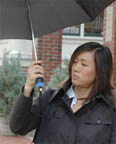
Forecasting Umbrella and Magic Mirror
During CES last week Ambient Devices announced a few new items in their line-up. Most exciting is the Forecasting Umbrella, which has a handle that pulses blue light when there's a good chance of rain. The device is connected to Ambient's proprietary network which allows it to know where it is and then download the local weather report. Next time you head out the door just glance at the umbrella and it will let you know if your should bring it along. Brilliant simplicity.
Ambient also announced a new Magic Mirror that looks like a plain mirror until you approach it—time, weather, traffic, stock or other information appear behind the glass and around the perimeter. Lastly, their series of information displays (weather, traffic stocks, etc) will be updated to use eInk for greater legibility. [blogged by Josh Rubin on Cool Hunting]
"Present day computer technology, including PDA’s and cellphones, utilize only a fraction of our sensory and cognitive capabilities.
Ambient devices elegantly embed digital information into the objects and environments that surround us. These displays are in the form of sound, air pressure, motion, light, smell, and other media that complement the full range of our human sensory modalities. They exist in the periphery of our senses, where they provide continuous information without being distracting." more >>
Posted by jo at 06:03 PM | Comments (0)
The Fashion of Architecture

CONSTRUCTING the Architecture of Fashion
The Fashion of Architecture: CONSTRUCTING the Architecture of Fashion--
Galleries: Judith and Walter Hunt Gallery, Mezzanine Gallery, Kohn Pedersen Fox Gallery, HLW Gallery, South Gallery; January 11–March 11, 2006
Architecture is making its presence felt in fashion as the pliable metals, membrane structures, lightweight glasses and flexible plastics used in building construction are creeping on to the catwalks. At the same time, architects and interior designers are borrowing the techniques of pleating and draping from traditional tailoring to design buildings that are interactive, inflatable, and even portable. Works by practitioners such as Zaha Hadid, Winka Dubbeldam, Shigeru Ban, Kivi Sotamaa, David Adjaye, Block Architecture, 6a Architects, Lars Spuybroek, Stuart Veech and Meejin Yoon are showcased alongside architectonic apparel from fashion mavericks such as Martin Margiela, Hussein Chalayan, Yoshiki Hishinuma, Yeohlee, Pia Myrvold, Yohji Yamamoto, Boudicca, Eley Kishimoto, Kei Kagami, Michiko Koshino, Stéphanie Coudert, Simon Thorogood, Nicola de Main, and Arkadius. The exhibition features a special installation from Paris-based artist Lucy Orta.
Curator: Bradley Quinn, FRSA, a British author and critic based in New York. [posted by Regine on 21f]
Posted by jo at 05:53 PM | Comments (0)
Space, Spatiality and Technologies
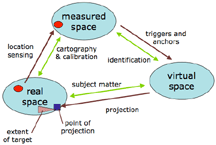
Managing Multiple Spaces
A. Dix, A. Friday, B. Koleva, T. Rodden, H. Muller, C. Randell, A. Steed, Managing Multiple Spaces. In P. Turner, E. Davenport (eds.) Space, Spatiality and Technologies, Kluwer, 2005.
The authors’ aim is analyse the way in which multiple spaces, both virtual and physical, can co-exist. By this we mean that people and objects may have locations in and relationships to both physical space and one or more virtual spaces, and that these different spaces together interact to give an overall system behaviour and user experience.
They use 4 cases (City, CityWide, the Drift Table and Ambient Wood) to see how multiple physical and virtual spaces interact. The choice of the different environment is pretty pertinent since there are mobile applications and an interactive table. They then discriminate 3 types of space: real space– the locations and activities of actual objects and people in physical space
measured space – the representation of that space in the computer and the representation of locations of objects and people from sensor data, etc.
virtual space – electronic spaces created to be portrayed to users, but not necessarily representing explicitly the real world. [...] [blogged by nicolas on pasta and vinegar]
Posted by jo at 03:22 PM | Comments (0)
Prix Ars Electronica 2006

International Competition for Cyberarts
The Prix Ars Electronica - International Competition for Cyberarts is being conducted for the 19th time in 2006. In addition to the classic categories-Interactive Art, Net Vision, Computer Animation / Visual Effects and Digital Musics-Digital Communities and [the next idea] Art and Technology Grant competition that debuted last year will be reprised.
Online Submission Deadline: March 17, 2006; Total Prize Money: 117,500 Euro; 6 Golden Nicas; 12 Awards of Distinction; Up to 12 Honorary Mentions in each category.
INTERACTIVE ART: The "Interactive Art" category is dedicated to interactive works in all forms and formats, from installations to performances. Here, particular consideration is given to the realization of a powerful artistic concept through the especially appropriate use of technologies, the innovativeness of the interaction design, and the work's inherent potential to expand the human radius of action.
COMPUTER ANIMATION/VISUAL EFFECTS
The "Computer Animation / Visual Effects" category has been part of the Prix Ars Electronica since its very inception. It recognizes excellence in independent work in the arts and sciences as well as in high-end commercial productions in the film, advertising and entertainment industries. In this category, artistic originality counts just as much as masterful technical achievement.
DIGITAL MUSICS
Contemporary digital sound productions from the broad spectrum of "electronica" come in for consideration in the "Digital Musics" category, as do works combining sound and media, computer compositions ranging from electro-acoustic to experimental music, or sound installations. This category's programmatic agenda is to expand horizons beyond the confines of individual genres and artistic currents.
NET VISION
The "Net Vision" category singles out for recognition artistic projects in the Internet that display brilliance in how they have been engineered, designed and-especially-conceived, works that are outstanding with respect to innovation, interface design and the originality of their content. The way in which a work of net-based art deals with the online medium is essential in this category.
DIGITAL COMMUNITIES
This category focuses attention on the wide-ranging social impact of the Internet as well as on the latest developments in the fields of social software, mobile communications and wireless networks. "Digital Communities" spotlights bold and inspired innovations impacting human coexistence, bridging the geographical as well as gender-based digital divide, or creating outstanding social software and enhancing accessibility of technological-social infrastructure. This category showcases the political potential of digital and networked systems and is thus designed as a forum for the consideration of a broad spectrum of projects, programs, initiatives and phenomena in which social innovation is taking place, as it were, in real time. A Golden Nica, two Awards of Distinction and up to 12 Honorary Mentions will be awarded in the Digital Communities category in 2006.
[the next idea] Art and Technology Grant
The aim of this grant focusing on the mutually enriching interplay of art and technology is to nurture concepts for the future that young thinkers are coming up with today. This category’s target group includes interested persons throughout the world between the ages of 19 and 27, who have developed a not-yet-realized concept in the fields of media art, media design or media technology. The winner will receive a 7,500-euro grant and an invitation to spend a semester as scientific assistant and artist-in-residence at the Ars Electronica Futurelab.
Iris Mayr
Prix Ars Electronica | Project Manager
Ars Electronica Center Linz
Hauptstraße 2
A-4040 Linz
Code: Prix
Tel. ++43.732.7272-74
Fax ++43.732.7272-676
info[at]prixars.aec.at
Posted by jo at 02:31 PM | Comments (0)
The Upgrade! Lisbon
![]()
January meeting featuring Patricia Gouveia and Nuno Correia
Lisboa 20 Arte Contemporânea welcomes, from this January, The Upgrade! Lisbon, a monthly gathering of new media artists, curators and general public that fosters dialogue and creates opportunities for collaboration within the new media art community. At each meeting one artist/curator present work in progress, past work or a concept and participate in a discussion with those attending the presentation. We would be delighted if you could come - whether you are an artist, a techie or simply someone who is interested in new media art!
The Upgrade! Lisbon is curated by Luis Silva and will have for its first meeting Patrícia Gouveia and Nuno Correia presenting their 2005 project Role Playing Egas
The Upgrade! (http://theupgrade.net) was started by Yael Kanarek in 1999 and is currently hosted by Eyebeam, New York City. Upgrade! affiliates include Vancouver (2003, curated by Kate Armstrong), Montreal (2004, curated by tobias c. van Veen), Boston (2005, curated by Jo-Anne Green), Seoul (2005, curated by Suhjung Hur), Tel Aviv (2005, curated by Mushon Shual), Munich (2005, curated by Tamiko Thiel), Oklahoma City (2005, Adam Brown), Chicago (2005, Open Node), Istanbul (2005, curated by basak senova), Scotland (2005, curated by Cezanne Charles, Robb Mitchell and Michelle Kasprzak) and Sofia (2005, curated by Kyd Campbell).
Calendar of events:
January 17th (19:00) :
Patrícia Gouveia e Nuno Correia
Role Playing Egas
Rua Tenente Ferreira Durão, 18B 1350-315 Lisboa (Campo de Ourique)
February:
André Sier
March:
Susana Mendes Silva
(For more information or project presentation, please email me) or go to The Upgrade! Lisbon
Posted by luis at 01:42 PM | Comments (0)
MobileActive
![]()
A Global Resource for Using Cell Phones in Social Activism
Mobile phones have emerged as a civic and campaign organizing tool across traditional socio-economic and cultural boundaries. Cell phone campaigns have swung elections through innovative get-out-the-vote activities, have been used to ensure impartial elections through monitoring, have resulted in massive collective action to free political prisoners or stop illegal logging, and are being used in public health strategies.
MobileActive convened in Toronto in 2005 to bring together, for the first time ever, activists from around the world to explore the use of mobile phones in civic action campaigns. This wiki and MobileActive site is an aggregation of the learnings from this convergence, stories from participants and their projects, and resources for activists interested in using mobiles in their campaigns. (For write-ups about MobileActive 05 go to our press page).
The goal of MobileActive is to grow the network of mobile activists, to share knowledge and skills, and to provide a peer network, training and resources to those interested in exploring mobile phones in their civic engagagement, mobilization, and civic action campaigns.
We aim to better understand the strengths and limits of the medium, explore available technologies for campaigners, and share lessons learned, campaign examples, and tech tools to increase activists’ ability to organize our constituencies.
If you used mobiles in your campaign, please share your story! If you need or have resources, let us know! And if you want to join this growing network of activists from around the globe send us a note: info[at]mobileactive.org.
Posted by jo at 10:27 AM | Comments (0)
1001 nights cast
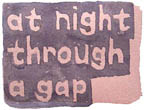
Marina Warner, Performance #206
"I'm honoured and excited to announce that the well-known mythographer and novelist, Marina Warner, has written an enchanting story for tonight's performance #206 of 1001 nights cast. The prompt today is: 'at night through a gap'. Marina has spun a tale within her own tale - a tale heard at night, under a full moon that effects all around her and encourages a traveller to tell of her flight from war in the Middle East.
Marina is based in London, where I first met her in 1995. She has written and lectured extensively on myths and fairytales through titles including Fantastic Metamorphoses, Other Worlds : Ways of Telling the Self (Vintage 2004); From the Beast to the Blonde (Chatto & Windus 1994); Monuments and Maidens (Picador 1987) and in 2003 the introduction to the Folio Society edition of The 1001 Nights..." Barbara Campbell [Related 1, 2]
Posted by jo at 10:04 AM | Comments (0)
PERVASIVE 2006 WORKSHOP
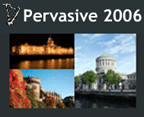
Privacy, Trust and Identity Issues for Ambient Intelligence
Call for Papers--PERVASIVE 2006 WORKSHOP: Privacy, Trust and Identity Issues for Ambient Intelligence--Submissions are invited to this workshop, which will take place in Dublin, Ireland at the 4th International Conference on Pervasive Computing, May 7th--10th 2006. Deadline for submissions - 6th February 2006.
Privacy, trust and identity issues for ambient intelligence: Ambient Intelligence (AmI) has been described as a 'paradigmatic shift in computing and society' and has become one of the key concepts in the FP6 IST programme 2002-2006. However most of the current work on AmI is driven by technological concerns, despite claims that it is fundamentally a human-centred development that will essentially set people free from the desktop, hence it has been argued that the societal and user implications of AmI should be made more explicit.
One of the particular challenges of AmI, which marks it out from other E-Society developments, is that the user will be involved in huge numbers of moment-to-moment exchanges of personal data without explicitly sanctioning each transaction. Agent technologies will be required to manage the flow of information, and a great deal of exciting technical work is ongoing in this field. But personal and social concerns remain unanswered, particularly concerning issues of privacy, trust and identity. The AmI challenge is particularly pressing, since in future there will be no obvious physical markers to tell us when we move from private to public cyberspaces (Beslay and Punie, 2002) and so individuals must be given a clearer vision of how and when to control personal data.
For further details see http://pst.dcs.st-and.ac.uk/pti-ai-workshop/
Organising Committee: * Pamela Briggs (Northumbria) * Linda Little Northumbria) * Steve Marsh (NRC Canada) * Steve Love (Brunel) * Ishbel Duncan (St Andrews) * Tim Storer (St Andrews)
Contact: Professor Pamela Briggs, PACT Lab, Cognition and Communication Research Centre, Northumbria University, Newcastle upon Tyne, NE1 8ST
Posted by jo at 09:45 AM | Comments (0)
January 11, 2006
Biomediale

Contemporary Society and Genomic Culture
In order to find its autonomy, Bio Art (a term described by Jens Hauser, curator of the "L'Art Biotech" exhibition, as an "etymological disgrace") is passing through the necessary evolutionary phases towards a complete definition, conquering a conceptual autonomy independent from the means used. The image that comes to mind is that of a 'chimera', a hybrid creature that is a mix of different species, which expresses a peculiar compositive coherence, both paradoxical and efficient. The facets implied by dirtying one's own hands with the basic elements of organic material (genes, cells, proteins, etc.) are many, as is analyzing the female body as a contemporary technological laboratory (in the performances by the subROSA collective), conceptually challenging the current eugenic development models, or the application of the usual schemes of knowledge hoarding, as is done by Eugene Thacker with his Open Source DNA.
The ferment created by the Critical Art Ensemble and Eduardo Kac can now be recognized by filtering the media flow of relevant announce(ments) by the industry, made here by Ricardo Dominguez, or reconstructed through the reflections on clones and their mediatic reproductions by Birgit Richard. This way, it's possible to feel the pulse of the silent conflict surrounding these subjects. In times when human intervention on organic creatures is as big as what nature does in decades, and building life is a fact, the definition of shared critical positions becomes the social fulcrum the cultural development of these technologies revolves around. (edited and curated by) Dmitry Bulatov, The National Publishing House "Yantarny Skaz" ISBN 5740608537 [via NEURAL]
Posted by jo at 11:29 AM | Comments (0)
Rush Creek Wilderness Trail

First Computationally Derived, Unofficial Public Wilderness Trail
The Rush Creek Wilderness Trail is possibly the world’s first computationally derived, unofficial public wilderness trail. It traverses the backcountry of far northeastern California, extending to near the border with Nevada. It was first "discovered" by a computer algorithm called a "virtual hiker" that pre-explored the landscape by "hiking" through a virtual landscape consisting of data provided by the United States Geological Survey. The virtual hiker found a traversable hiking path between the trailhead and the terminus, both of which were very much arbitrarily chosen by Brett Stalbaum, the author of many virtual hiker algorithms for C5 Corporation. The results of the virtual hiker's exploration produce a tracklog (computer file) that can be uploaded to a GPS device and then followed by a real hiker through the actual landscape. There is no "trail" per se, only a rugged overland backcountry track that can be followed with the assistance of a GPS device. The trail provides beautiful views of the Great Basin desert environment, plentiful wildlife viewing opportunities, and the unique experience of comparing the wayfinding abilities of a virtual hiker to your own wayfinding skills and intuition.
Phase 1 of the trail (From the Rush Creek Wilderness Trailhead to Rush Creek Spring) was opened by Stalbaum December 27th and 28th of 2005. Phase 2 (from Rush Creek Spring to the Nevada Border), will be opened sometime during 2006. Documentation of the project, the trail, and directions can be found here: http://www.paintersflat.net/rush_creek
Posted by jo at 11:10 AM | Comments (0)
LonelyHome
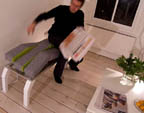
Self-Conscious, Reluctant Furniture
The LonelyHome bench--by Tobi Schneidler--is a hybrid creation, part domestic furniture and part robotic pet: a socially intelligent design object. It can be used as an ordinary piece of living room furniture, but it will also come alive unexpectedly. The LonelyHome is a relative of the RemoteHome, the first apartment that exists in two cities at the same time. Originally conceived as a mediating environment, that connects close friends over distance through tangible design elements, the RemoteHome has also produced some cousins that are rather to be used locally.
Unlike the RemoteHome, the LonelyHome is a domestic, robotic furnishing. It can be (ab-) used as a mundane piece of furniture, but it will also come alive at certain times to confront its owner and challenge his presence. The LonelyHome will define a new class of responsive objects and spaces that claim both the utility of a kitchen blender, as well as the social competence of a robotic pet. But unlike the humanoid fantasies of Japanese robot scientists, the Lonely home is a more hybrid proposal, a socially intelligent design object. [via Interactive Architecture]
Posted by jo at 08:46 AM | Comments (0)
No Animals Were Hurt

Chain of Communication Reveals Story
No Animals Were Hurt is Peter Brinson's short film about Alan Turing. The more views the film receives, the closer it gets to telling the logician's story. The picture plays too quickly while the sound plays at normal speed, but with each visitor the picture slows. After enough visitors, the sound and picture will play at equal speeds, allowing the story to finish.
Each unique visitor unlocks one frame, out of the total 5000. Currently, after 406 visitors, the film is 9% its proper length. If a computer returns to the site, it may view the movie, but does not unlock an additional frame. This film does contain blank (black) frames. The film can only become longer if you tell a friend. [via Regine on we-make-money-not-art]
Posted by jo at 08:35 AM | Comments (0)
What’s Your Social Doing In My Mobile?
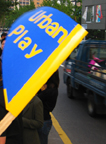
Design Patterns for Mobile Social Software
This Friday I will be visiting UC Irvine's Department of Informatics and giving a talk on Mobile Social Software — some material I've been working on through the Netpublics Research Seminar at the Annenberg Center for Communication.
Abstract: Making “mobile software” into Mobile Social Software suggests that social beings assume an explicit role in the untethered, software-based experience. If we borrow from the idiom of Social Software, we can say that Mobile Social Software are techniques for articulating social practices that create, maintain and manage networks of relationships amongst people and encourage the circulation of culture in untethered, networked-based usage contexts. The design challenge for such techniques is to avoid prioritizing instrumental aspects of mobile terminal devices over the actual social practice that software attempts to facilitate. I suggest herein that this challenge can be addressed by moving to the foreground specific practice idioms as frameworks for design prototypes, avenues for research and development, and contexts for study and theory objects. This design approach is described as a point of view on Mobile Social Software, along with an explication of this perspective through a taxonomy of Mobile Social Software design idioms — Spatial Annotation, Proximity Interaction, and Presence Awareness.
The Informatics Seminar is held on Friday at 3pm at the The UCI Department of Informatics in ICS2 136, followed by a social hour at 4pm. [blogged by Julian Bleecker on Interactive Media Division Weblog]
Posted by jo at 08:23 AM | Comments (0)
Physical Markup Language
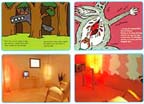
Your Room as Browser
Ambient Intelligence, with its network of cooperating devices, offers the promise of providing us with exciting new experiences in the home...An Ambient Intelligence system can interpret a description in Physical Markup Language (PML)--developed by Philips to describe experiences within an Ambient Intelligence environment. Devices in a network can jointly use their individual capabilities to render that experience at a given location.
In effect, your whole room becomes a 'browser' that brings the experience to life. For example, PML-enabled lights add to the experience by getting brighter or dimmer, or changing colour. A PML-enabled hi-fi provides an appropriate soundscape. Almost any device can be PML-enabled: the possibilities are only limited by the imaginations of their manufacturers. Suppose a room is rendering an experience described as 'warm and sunny': the lights, the TV, the central heating, the electronically controlled blinds and (a little further into the future) even the ceiling, walls and floor coverings could all contribute to creating it. [via nicolas at pasta and vinegar]
Posted by jo at 08:04 AM | Comments (0)
January 10, 2006
NYSoundmap
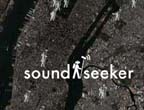
Mapping New York City
Maps are tools for understanding the world from different points of view - political, cultural, personal, and historical. Maps hold the power to shape the truth about the world and mapmakers shape the future. The NYSoundmap is a container - a concept or idea to hold many types of processes and projects. The project reaches across the city's geographic, economic, educational, cultural and racial divides. It is at once a historical record and a subjective representation of the city. It is what each user wishes it to be and it is ever growing, ever changing and totally interactive.
SOUND-SEEKER: What kinds of sounds can you find in New York City? With sound-seeker, you can zoom, pan and search for sounds with interactive satellite photos or detailed maps. Click on hot spots to listen to the recorded sounds of a location pin-pointed by GPS. Sound-seeker was created using GoogleMaps and isn't viewable in all browsers.
CITY IN A SOUNDWALK: Composer Michelle Nagai proposes an augmented experience of the urban soundscape. Begin with the physical practice of the soundwalk. Then add personal narrative, lively opinion and debate, images, historical context, socio-economics, culture, sound recordings and environmental data...
PROTEST, TRANSPORT, CELEBRATE: What did New York City sound like 30 years ago? Artist Andrea Callard lets you hear city sounds she recorded in the 1970's. Listen to chorus of truck horns as hundreds of striking truck drivers came out of the Holland Tunnel and over the Manhattan Bridge into Brooklyn on July 1, 1979 and the sounds of the downtown churches ringing their bells to celebrate the first 200 years of the U.S.A. on July 4, 1976.
GIANT EAR ))): The last Sunday of every month, NYSAE hosts a webcast radio show called Giant Ear))) from 7-9 PM at Free103point9. Shows feature a wide range of recordings including: Transcedental Sounds: Bells, drones, glossolalia and other otherworldliness of the everyday, Get Yer Cans On! A Headphonic Trip Around the World, recordings of the RNC Protests in 2004 and What does freedom sound like to you? interviews with brokers at the NY Stock Exchange.
The NYSoundmap project officially launches January 10, 2006 on Rhizome and Free103point9 as part of Surge, an online exhibition of web-based projects.
Posted by jo at 05:52 PM | Comments (0)
1000 DAYS OF THEORY

Precision + Guided + Seeing
"Let's address this question of "precision" on two fronts: one, as a technologically-enabled drive toward efficiency and accuracy -- a drive to augment human capabilities by developing new human-machine composites, connecting and joining forces with multiple processing agencies, wherever or whatever they might be; and two, as a technologically-assisted drive to reduce mediation and offer a form of direct connection to our real objects of inquiry. We might call these the effective and the affective. Both aim for the goal of instantaneous vision: a real time perceptual agency in which multiple actors, both human and machinic, are networked and able to act in concert. A real time perceptual agency in which time and space intervals can be eliminated, reducing the gaps between detection, analysis, and engagement, or desire and its attainment. A real time perceptual agency that can somehow touch the real.
Yet the drive for the real, as Zizek suggests, always culminates in its opposite: theatrical spectacle. Why? Because the real is only able to be sustained if we fictionalize it.[2] To look for the real, then, is not to look for it directly: it is to look to our fictions, discerning how reality is "transfunctionalized" through them.
[3] Perhaps the real object of the precision-drive is not only arrived at through reduction, but through expansion. To look to the object of the precision-drive is not only to narrow the optic, honing in on the target of attention: it is to look to the cultural fictions in which the object becomes lodged. It is to open the optic; theatricalize it. To accommodate cultural fictions is to acknowledge the constitutive role of conflict. What aspects of the real are transfunctionalized through our conflict imaginaries?" From Precision + Guided + Seeing by Jordan Crandall, CTHEORY: 1000 DAYS OF THEORY, VOL 29, NOS 1-2, Editors: Arthur and Marilouise Kroker
Posted by jo at 05:23 PM | Comments (0)
LMCC's Swing Space Program!

Free space for artists!
Swing Space is a new initiative of Lower Manhattan Cultural Council. Working in partnership with area landlords, LMCC makes vacant space downtown available to artists, curators and arts organizations on a temporary basis at no cost.
The program is designed to address the short-term space needs for a range of projects, and to encourage creative, experimental and collaborative approaches to artistic practice in unconventional spaces. Project stipends ranging from $300 to $3000 are provided to support project costs! Recent Swing Space grantees include THE THING, National Theater of the United States of America, Jessica Irish, and Noah Fischer.
Applications are accepted and reviewed in the following project categories:
- Studio space
- Rehearsal space
- Installation for public presentation
- Curated exhibitions for public presentation
- Temporary office space
LMCC is also accepting applications for the 15 Nassau Program, which provides space for public programs and performances. Recent 15 Nassau grantees include Pablo Helguera/PERFORMA 05, Koosil-Ja Hwang, and Artists Alliance.
Deadline: February 21, 2006, 5:00 PM.
Apply online: http://www.lmcc.net/swingspace
Questions: swingspace[at]lmcc.net
Posted by jo at 01:55 PM | Comments (0)
FM10 Openness:
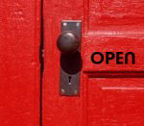
Code, Science and Content; Making Collaborative Creativity Sustainable
First Monday’s tenth anniversary conference, 15-17 May 2006 at the University of Illinois at Chicago: Recent years have seen a strong interest among academics, policy makers, activists, business and other practitioners on open collaboration and access as a driver of creativity. In some areas, such as free software / open source, sustainable business models have emerged that are holding their own against more traditional, proprietary software industries. In the sciences, the notions of open science and open data demonstrate the strong tradition of openness in the academic community that, despite its past successes, is increasingly under threat. And open access journals and other open content provide inspiring examples of collaborative creativity and participatory access, such as Wikipedia, while still in search of models to ensure sustainability.
There are clear links between these areas of openness: open content often looks explicitly towards open source software for business models, and open science provides through its history a glimpse of the potential of openness, how it can work, as well as a warning of the threats it may face. Finally, open collaboration is closely linked to access to knowledge issues, enabling active participation rather than passive consumption especially in developing countries.
Despite these clear links, there has been surprisingly little thoughtful analysis of this convergence, or of the real value of the common aspect of open collaboration. In particular, while open source software ˜ due to its strong impact on business and on bridging the digital divide ˜ has drawn much attention, it may provide false hopes for the sustainability of openness in other areas of content that need careful examination. The conference - FM10 Openness: Code, science and content: Making collaborative creativity sustainable - provides a platform for such analysis and discussion, resulting in concrete proposals for sustainable models for open collaboration in creative domains.
The conference will draw on the experience of First Monday as the foremost online, peerˆreviewed academic journal covering these issues since May 1996. Not only has First Monday published numerous papers by leading scholars on the topics of open collaboration, open access, and open content in its various forms, it is itself an example of open collaboration in practice: for nearly a decade, the journal has been published on a purely voluntary basis, with no subscription fees, advertising, sponsorship or other revenues. The success of First Monday is demonstrated by thousands of readers around the world, downloading hundreds of thousands of papers each month. This conference celebrates First Monday‚s tenth anniversary. The first issue of First Monday appeared on the first Monday of May 1996 at the International World Wide Web Conference in Paris. Altogether, 658 papers have been published in 115 issues, written by 783 different authors from around the world.
The conference is supported by the John D. and Catherine T. MacArthur Foundation (http://www.macfound.org/), the Open Society Institute (http://www.soros.org/), and the University of Illinois at Chicago
Posted by jo at 12:57 PM | Comments (0)
UpStage
![]()
Open Walk-Through
The the first UpStage walk-thru of 2006 will be held this coming Wednesday, 11 January, at the following times: California, USA: 12am; New York; UK: 8am; Western Europe: 9am; Finland: 10am; Australia - NSW: 7pm; NZ: 9pm. Check here or here for your local time.
Audience members, point your browser at http://upstage.org.nz:8081/stages/presentation. If you want to participate as a player, email helen varley jamieson for a log in--helen[at]creative-catalyst.com
http://www.creative-catalyst.com
http://www.avatarbodycollision.org
http://www.writerfind.com/hjamieson.htm
Posted by jo at 12:40 PM | Comments (0)
When Science Meets Art

Seamless Fashion Show 2
Christine Liu and Nick Knouf put on the seamless fashion show last May at MIT (blogged here, the needy dress, fatJab, Nomad Pneumatics, aetherspace, etc.) In a few weeks they're doing a 2nd rendition of seamless (same idea, new stuff, same city, new venue) on February 1, 2006, in conjunction with the Boston Museum of Science in their When Science Meets Art series.
They will showcase new, experimental projects (mostly student designers) in the intersection of fashion, culture, the body, and technology. Picture shows the wonderful Red Hats that Bea Camacho presented at the first seamless show. I also found this video of Bea's Enclose eleven-hour performance. During the performance she crocheted herself into a cocoon with red yarn. The project is about concealment, self-preservation, isolation and duration. [blogged by Regine on we-make-money-not-art]
Posted by jo at 09:31 AM | Comments (0)
Gun Control
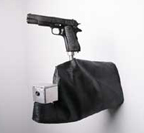
Panoptic Insecurity
Gun Control, by Scott Kildall, explores issues of both security and surveillance. Each of the four units incorporates a police-issue revolver and a video camera. As people move into the installation space, the cameras track the movement and the guns follow.
However, the system does not always function properly. The revolvers point at different targets. They sometimes twirl about playfully. The armatures shake and rattle. Visitors are directly in the line of fire. This piece raises questions about our security-surveillance apparatus by prompting a visceral reaction. (videos)
Can't help but mention an installation I saw recently at the ZKM in Karlsruhe (Germany.) When Swedish artist Jonas Dahlberg moved to a new apartment in 1995 he discovered that from his windows he had an unimpeded view into his neighbour's house on the other side of the street. The wall in there was decorated with an arsenal of weaponry. This threatening image in his existence prompted the artist to furnish his own apartment only as far as the zones that the other man in turn could not see.

His experience inspired Safe zones, no. 7 (The toilets at ZKM). Monitors placed next to the door of the public bathroom make visitors imagine that the toilet space is being monitored by a camera. Once inside, people notice that what was being monitored is in fact a detailed model of a toilet, placed in the same space. (more)
Related: the (in)security camera, Apple's Place and the insecurity guard. [blogged by Regine on we-make-money-not-art]
Posted by jo at 08:52 AM | Comments (0)
The Unseen Video
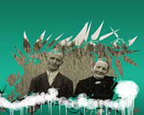
Weather Controlled Video
The Unseen Video is a weather controlled music video for Mike Milosh's You Make Me Feel. The video is affected by the weather and local time of the viewer's localisation. Every little change in their environment ensures that they will never see the same video twice. The look of the video might slightly change within an hour, but will have a whole new character in a few months. More screenshots.
By Daniel Scheibel and Ferdinand Weinrother. Weather-related installations: the Cloudharp, weather report. [blogged by Regine on we-make-money-not-art]
Posted by jo at 08:24 AM | Comments (0)
S O U T H E R N E X P O S U R E

CALL FOR PROPOSALS: SoEx OFFSITE
An opportunity for emerging artists to develop and create new public works in San Francisco that investigate diverse strategies for exploring and mapping public space. Southern Exposure will commission a series of public art projects that investigate diverse strategies for exploring and mapping public space. Artists selected through this open call will be commissioned to produce new work.
SoEx: OFFSITE is informed by the legacy of the Situationists, an international artistic and political movement that emerged in the 1950s and 1960s. The Situationists sought to radically redefine the role of art in society with a particular interest in everyday experiences in public space. They developed key concepts such as the dérive the practice of drifting through urban space - and psychogeography the study of the effects of the geographic environment on the emotions and behavior of individuals. In addition, a goal of these projects is to reconsider the Situationists¹ strategies in light of new technologies such as Global Positioning devices and wireless communication, which have fundamentally transformed our ability to navigate public space.
This series will feature a range of projects that utilize strategies such as simple acts of walking and note taking, to projects that employ high-tech and technological apparatuses as a means to fuse virtual and real experiences or to disseminate geographical and historical information, to performances, actions, or events. These projects may involve the audience¹s participation, enabling the public to engage in acts of urban mapping and reflect on their own experiences in public space.
Southern Exposure seeks proposals for artwork in various media including 1) artwork with a physical presence such as: installation, sculpture, or public intervention; 2) ephemeral and participatory artwork such as: performance, tour, walk, discussion, or lecture; 3) technology-based work such as new media or sound art; or 4) projects that combine the above categories. Projects will be presented between September 2006 and Spring 2007. The duration of the projects can range from a single performance to repeating events or a long-term installation. Selected artists will receive an honorarium and production budget ranging from $500 - $5,000 depending on the scope of the project. Southern Exposure will work with artists to provide support, promote their projects, and will create a publication that documents the program series after the projects have been presented. Southern Exposure will also provide a home base for artists to work, with space for information about the projects to be accessible to the public.
APPLICATION & REVIEW PROCESS:
The proposals will be reviewed by several members of Southern Exposure's Curatorial Committee. We are seeking proposals from artists who demonstrate a potential for creative growth working in the public realm, or artists who would like to extend their practice into the public realm but have yet to work this way.
Please mail or deliver your proposal package to Southern Exposure. Southern Exposure does not accept electronic submissions.
SoEx OFFSITE
Southern Exposure
401 Alabama Street
San Francisco, CA 94110
Application Deadline: Materials must be received at Southern Exposure's office by 5 p.m. on Friday, February 28, 2006 (this is not a postmark date). Hand deliveries will be accepted.
Notification Deadline: Artists will be notified by later no later than March 31, 2006. Please do not call before this date.
INQUIRIES:
You can find all of this information and more at www.soex.org in the SoEx OFFSITE section. If you have questions regarding the application process, please contact us by email: programs@soex.org. Subject heading of the email should read: "SoEx OFFSITE."
About Southern Exposure: Southern Exposure is a 31 year old, non-profit, artist-run organization dedicated to presenting diverse, innovative, contemporary art, arts education, and related programs and events in an accessible environment. Southern Exposure reaches out to diverse audiences and serves as a forum and resource center to provide extraordinary support to the Bay Area's arts and educational communities. Activities range from exhibitions of local, regional, and international visual artists' work, education programs, and lectures, panel discussions, and performances. Southern Exposure is dedicated to giving artists--whether they are exhibiting, curating, teaching, or learning--an opportunity to realize ideas for projects that may not otherwise find support.
SOUTHERN EXPOSURE OFFSITE:
Southern Exposure's 2006-2007 Exhibition and Artists in Education programs will move beyond the gallery walls in order to present new forms of work in public space. Southern Exposure will temporarily relocate in the summer of 2006 so that the building that we have always called home at Project Artaud can undergo a seismic retrofit and upgrade. Southern Exposure is utilizing this unique opportunity to extend our programs into the public realm. Southern Exposure, founded in 1974, has a long history of presenting community-based projects. Through this new program, Southern Exposure has a goal of encouraging artists to work experimentally in public space, enabling artists to develop new works that could not otherwise be realized, and generating a critical dialog about emerging creative practices.
For more information go to www.soex.org or call 415-863-2141.
This program is made possible through the generous support of the National Endowment for the Arts and the Andy Warhol Foundation for the Visual Arts. Submission Application: SOEX OFFSITE
ELIGIBILITY:
Open to local, national and international artists, with a focus on supporting San Francisco Bay Area artists.
WHAT TO SUBMIT:
Please complete the following form and submit it with your application:
NAME:
ADDRESS:
CITY/STATE/ZIP:
PHONE:
EMAIL/WEBSITE:
1. Submit up to TWO forms of visual support material: up to twelve digital images saved as JPEG files. (May not exceed 800 x 600 pixels 72 dpi). Each image file should be labeled or saved with your name and a number that corresponded to an annotated image list (see below). We are not accepting slides. One DVD with up to three works or three excerpts of works. We will view up to five minutes of work. One VHS tape, cued. We will view up to five minutes of work.
2. Annotated image list of your support materials: indicate artist name, title, year, medium, brief description of each work (digital image or video).
3. Artist statement, no more than one page in length.
4. Current resume, including name, address, phone number and email address.
5. Proposal. In 300 words or less, describe the project that you would like to develop, include: the form your project will take (i.e. public sculpture, performance, action, event, etc); the motivations for the work and concepts behind it suggest possible locations, types of locations, or a specific location you intend to use. OPTIONAL: You may include a schematic or visual example of your project.
6. Preliminary budget in narrative form estimating material costs and required production time.
7. A self-addressed stamped envelope (SASE) large enough to return submitted materials and containing the correct amount of postage. MATERIALS WITHOUT A SASE WILL NOT BE RETURNED AND WILL BE DISCARDED AFTER 2 MONTHS IF THE ARTIST HAS NOT CONTACTED SOUTHERN EXPOSURE
Please include 3 copies of items #'s 2- 6. Do not submit binders,
folders or original artwork.
S O U T H E R N E X P O S U R E
Dynamic, cutting edge art, education, and community programs since 1974.
401 Alabama Street @ 17th
San Francisco, CA 94110
t: 415.863.2141
f: 415.863.1841
e: soex[at]soex.org
w: www.soex.org
Posted by jo at 08:23 AM | Comments (0)
January 09, 2006
Turbulence New England Initiative II

Call for Entries
Turbulence.org is pleased to announce its New England Initiative II, a juried, networked art competition. Three projects by New England artists will be commissioned and exhibited on Turbulence and in real space (venue to be announced). Each award will be $3,500. The jury consists of Julian Bleecker, Michele Thursz, and Helen Thorington. This project is made possible with funds from the LEF Foundation.
PROJECT CONCEPT: Net art projects are "art projects for which the Net is both a sufficient and necessary condition of viewing/expressing/participating" (Steve Dietz). They live in the public world of the Internet. Recently, however, wireless telecommunications technologies have enabled computation to migrate out of the desktop PC into the physical world, creating the possibility of “hybrid” networked art, works that intermingle and fuse previously discrete identities, disciplines, and/or fields of activity such as the Internet and urban space. (See the networked_performance blog—specifically the categories Locative Media and Mobile Art and Culture.) Borders are disintegrating and new identities are emerging. We encourage applications by net artists and artists working on networked hybrid projects.
PROJECT TIMELINE:
Proposal Deadline: February 28, 2006
Selected Projects Announcement: March 15, 2006
Project Launch/Exhibition: October 1, 2006
SELECTION CRITERIA: (1) artistic merit of the proposed project; (2) originality; (3) degree of performativity and audience participation; (4) level of programming skill and degree of technological innovation; and (5) extent of collaborative and interdisciplinary activity.
PROPOSAL GUIDELINES:
(a) Your name, email address, and web site URL (if you have one).
(b) A description of the project's core concept and how it will make creative use of digital networks (500 words maximum).
(c) Details of how the project will be realized, including what software/programming will be used. Specs for the Turbulence server are available here. You may request additional software but we cannot guarantee it.
(d) Names of collaborators, their areas of expertise, and their specific roles in the project.
(e) A project budget, including other funding sources for this project, if any.
(f) Your résumé/CV and one for each of your collaborators.
(g) Up to five examples of prior work accessible on the web.
Email submissions (the web site URL) to turbulence[at]turbulence.org with NE 2 in the subject field.
JUROR BIOGRAPHIES:
Julian Bleecker has been involved in technology design for over 15 years, creating mobile, wireless, and networked-based applications across a diversity of project idioms including entertainment, art-technology, brand marketing, university research and development, interactive advertising and museum exhibition. His expertise is technology implementation, innovation and concept development. Bleecker is currently Visiting Assistant Professor at the University of Southern California's Interactive Media Division and Critical Theory departments, and is participating in a research group at the Annenberg Center's Institute for Media Literacy exploring the future of mobile technology applications. He has a Ph.D. from the History of Consciousness Board at the University of California Santa Cruz, a Masters of Engineering from the University of Washington, Seattle, and a BS in Electrical Engineering from Cornell University.
Helen Thorington is co-director of New Radio and Performing Arts, Inc. (aka Ether-Ore), the founder and producer of the national weekly radio series, New American Radio (1987-1998), and the founder and producer of the Turbulence and Somewhere websites. She is a writer, sound composer, and radio producer, whose radio documentary, dramatic work, and sound/music compositions have been aired nationally and internationally for the past twenty-three years. Thorington has created compositions for film and installation that have been premiered at the Berlin Film Festival, the Whitney Biennial, and in the Whitney Museum’s Annual Performance series. She has produced three narrative works for the net, and the distributed performance Adrift which was presented at the 1997 Ars Electronica Festival and at the New Museum in New York City, 2001, among other places. Thorington has also composed for dance and performed with the Bill T. Jones/Arnie Zane Dance Company at Jacob’s Pillow, MA in 2002, and at The Kitchen, New York City in 2003. She won two radio awards in 2003 for her 9_11_Scapes composition; and was recently commissioned by Deep Wireless, a Toronto radio festival, to create Calling to Mind. Thorington has lectured, presented on panels, and served as a juror on many occasions. Her recent articles on networked musical performances include “Breaking Out: The Trip Back” (Contemporary Music Review, Vol 24, No 6. December 2005, 445-458); and “Music, Sound and the Networked_Performance Blog” for the Extensible Toy Piano Symposium at Clark University, Massachusetts, November 5, 2005.
Michele Thursz is an independent curator and consultant for art-makers and distributors. Her current project is Post Media Network; Post Media is a term and action demonstrating the continuous evolution of uses of media and their effect on artists practice, and culture-at-large. In 1999 she co-founded and directed the Moving Image Gallery, NYC. Moving Image Gallery was one of the first galleries to show electronic and computer-based mediums, exhibiting such artist as Golan Levin, Cory Arcangel and Yael Kanerek. Thursz’ recent curatorial projects include “Copy it, Steal it, Share it”, Borusan Gallery, Istanbul, and “Nown”, Wood Street Gallery, Pittsburgh; “public.exe: Public Excution”, Exit Art, NYC, and “Democracy is Fun”, White Box, NYC. She has written essays about contemporary art for catalogues and has lectured on contemporary art and curatorial practice. Thursz’s actions and exhibits have been reviewed and featured in the New York Times, Forbes Best of the Web, ArtByte, Wired News, Art Forum, and many international periodicals and web publications.
Posted by jo at 06:33 PM | Comments (0)
Digi-Presenter Manual

A Presenter's Guide to Networked Performance
"In January 2004, NYSCA’s Presenting Program launched an initiative for New York State Presenters to learn about developments in digital technologies and the performing arts. Over the past two years, a core group of presenters have met in New York City and in Albany to attend performances and events, meet with artists, attend roundtables, visit digi-ready venues, present work, and share project notes...
The "Digi-Presenters" requested a guide to which they could refer when considering, negotiating and/or producing digi-based work. Therefore, the Presenting Program asked Jo-Anne Green, Co-Director of New Radio and Performing Arts, Inc., to create The Digi-Presenter Manual. Ms. Green blogs on networked_performance, a rich resource of emerging technologies in the networked arts..." Bella Shalom, Director, Presenting Program; and Jeanette Vuocolo, Project Organizer, New York State Council on the Arts, a State agency.
Posted by jo at 05:56 PM | Comments (0)
SWITCH issue 21:
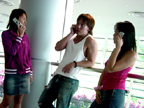
Pacific Rim
Electronic Privacy in Asia: What is the effect of the Fantabulous Kawaii Gizmos, Wireless Privacy Daemons (Waveband: 2.4-GHz) & Orientalism by Adrien David Cheok and Roger Thomas Tan, Mixed Reality Lab, National University of Singapore: "There has been a growing debate amongst artists and scientists about the effect of electronic privacy due to the rapid increase and use of mobile digital media devices, which can potentially transmit and receive personal information. We argue that in Asia the concern of attack on privacy due to these digital devices is generally lacking, and this stems froma deep thread of Orientalism in Asian societies even in the digital age...
...Intimacy as Asia’s fundamental cultural essence has reached such a level that it is not uncommon to bathe naked in a group in a bathhouse in Japan. Would knowing his physical whereabouts or stealing pictures of him sitting at his office desk typing away at the computer then bother the average Asian? On the contrary he would more likely to be puzzled than upset at one’s intentions for carrying out such deeds. In Singapore it has become completely common to purchase a “Singtel” camera to monitor ones children in the house while at work, and cameras are ubiquitous in normal office spaces. Thus from a baby to adult the concept of bothering about privacy is much lessened compared to European cultures.
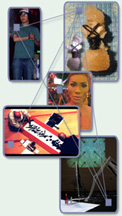
Other articles:
Here Be Dragons!: Bio-art beyond the edge of everything
By Anne Farren and Andrew Hutchison
Department of Design at Curtin University of Technology in Perth, Western Australia
Karaoke Ice: A Night Out
By Nancy Nowacek, Marina Zurkow, Katie Salen and the CADRE City as Interface Group
ISEA 2006 "City as Interface" Residency
Towards New Bodies and New Biologies: Life as Code, Body as Protocol
By Carlos Castellanos
SWITCH Editorial Member
Ladyboys: Human Art
By Skyler Thomas
SWITCH Editorial Member
Playing With Culture: Gaming Across the Pacific Rim
By Christopher Head
SWITCH Editorial Member
SWITCH is the new media art journal of the CADRE Laboratory for New Media of the School of Art and Design at San Jose State University. It has been published on the Web since 1995. We are interested in fostering a critical viewpoint on issues and developments in the multiple crossovers between art and technology. Our main focus in on questioning and analyzing as well as reporting and discussing these new art forms as they develop, in hopes of encouraging dialogue and possible collaboration with others who are working and considering similar issues. SWITCH aims to critically evaluate developments in art and technology in order to contribute to the formation of alternative viewpoints with the intention of expanding the arena in which new art and technology emerge.
Posted by jo at 05:32 PM | Comments (0)
urbanhermes

Redefining Fashion and Identity
Fashion signals are important in displaying one's quality of access of information. electronic fashions, information that may circulate within blog circles or online communities, experience rapid fashion cycles as the information is easily disseminated and regenerated. physical fashions, such as clothing, are unable to update as quickly as information flow due to their physical structure. urbanhermes is an augmented messenger bag that aims to incorporate the fluid, expressive signals of electronic fashion into the constrained, material-based environment of physical fashion. The bag is able to change its dynamic, temporal display within the context of its social environment, providing versatile means for face-to-face signaling. By accelerating the physical fashion cycle, urbanhermes facilitates more meaningful and communicative representions of self-identity. See urbanhermes: social signaling with electronic fashion [pdf] [msword] [via Information Aesthetics]
Posted by jo at 02:05 PM | Comments (0)
Temporary Travel Office
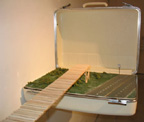
Guanabacoa Trail
The Temporary Travel Office proposes Guanabacoa Trail, an addendum to the observation platform at Round Marsh within the Theodore Roosevelt Area of the Timucuan Ecological and Historic Preserve.
The Temporary Travel Office is proposing an addition to the current Observation Tower within the preserve that offers hikers a panoramic view of Round Marsh. The addition would consist of a 498mi/801km boardwalk that would span from the preserve in Jacksonville, FL to Guanabacoa, Cuba. Signage would explain the significance of the expansion to the site (see text below) and audio tours would be commissioned by anthropologists, artists, amateur historians and human rights advocates to accompany hikers on the long walk.
The Timucuan Ecological and Historic Preserve is located near the intersection of the US Intracoastal Waterway and the mouth of the St. Johns River in Jacksonville Florida. Other than existing on classic Florida wetlands, the preserve also occupies the site of first contact between indiginous peoples and European colonists in what is now North America. Monuments to the French expeditions of Rene Laudonnier (who established Fort Caroline) and Jean Ribault are primary attractions for park visitors.
Roosevelt Area of Jacksonville's Timucuan Ecological and Historic Preserve:
The last known Timucuan, Juan Alonso Cavale, was born in 1709 at Mission Nuestra Señora de la Lecha in what would become the State of Florida. After devastating attacks by British supported Yamasee Indians on the Spanish supply route known as the Camino Real, the Spanish eventually ceded Florida to the British, evacuating their St. Augustine stronghold. They took the estimated 89 surviving missionized Indians with them to Guanabacoa, Cuba where Juan Alonso Cavale would die in 1767.
Guanabacoa, Cuba: Guanabacoa, now a suburb of Havana, Cuba played an important role in the historical narrative of slavery in the "New World." Once the site of forced reservation camps for indigenous peoples, Guanabacoa would become a haven for escaped slaves from the United States. Here, a small stretch of the US 1 highway running through Jacksonville, Florida is reconstructed on the site of a former reservation. The actual stretch of road is now named for Johnnie Mae Chappell, an African-American woman who was gunned down as she walked along the road on March 23, 1964. Several miles away in downtown Jacksonville, protests against the inequities of racial segregation turned violent as whites fought the advances of civil rights. Images of the proposal (as exhibited at Seesaw Space in Jacksonville, FL in December) and a trail map available.
Visit the Temporary Travel Office online.
Posted by jo at 12:15 PM | Comments (0)
John Lansdown Award for Interactive Digital Art 2006

Apply Now
All those working in interactive digital art are invited to submit for this international prize, awarded annually by the Eurographics Association. The first prize has a cash value of 750 Euros and there is 250 Euros for the runner-up. The closing date for submission is 28 April 2006. The submission process and full details of the prize and the submission process are available at the EG 2006 web site.
The criteria for the Award centre on the creative use of the digital medium for interactive art, in any form. The Eurographics 2006 conference also has animation and multimedia programmes; see full details of these categories.
Background
Eurographics presented the John Lansdown Prize for Multimedia for the first time at the Eurographics 2000 conference. This year the prize is renamed the Prize for Interactive Digital Art, to better describe the kind of entry that the judges are looking for.
The prize is dedicated to the memory of Professor John Lansdown, who died in February 1999. In his varied career, John Lansdown was involved in many creative activities, from his first discipline of architecture, through computer graphics to computer-mediated artwork of many forms, culminating in multimedia production. Creativity is an overworked word, but it can be justly applied to John Lansdown's approach to everything he explored, so the criteria for the award centre on the creative use of computers to generate interactive art.
The results of the competition will be announced at Eurographics 2006 in Vienna in September 2006. A certificate will accompany the cheque.
The judges look forward to receiving a stimulating set of submissions and wish all submitters good luck with their research and development work.
Judging Criteria
The submission awarded first prize will demonstrate innovation in the use of interaction with images, sound and animation. The judges will take into account whether the work looks and sounds 'good' and behaves 'well', the strength of the underlying ideas and the degree to which the system 'works' both conceptually and mechanically, in other words the fitness for purpose of the submission. A successful work will show a significant understanding of the needs, motivations, conceptions and actions of the user.
Fundamental characteristics that the judges will expect to find in a successful submission include:
* Innovation * Coherence * Selectivity or appropriateness * Usability * Usefulness * Fertility for development * Degree of finish * Meeting declared aims * Awareness of 'state of the art' * Technical ingenuity
The judges reserve the right to make no award or to award only a second prize if, in their opinion, the standard of work submitted does not reach the high standards of creativity associated with John Lansdown. The judges' decision is final. They may, at their discretion, give private advice or comments to submitters of work on future development, but will not openly discuss their decisions nor respond to direct questioning on the reasons for decisions after the award ceremony.
Posted by jo at 11:23 AM | Comments (0)
The Palace at 4 AM
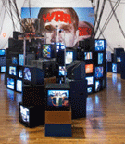
Wartime Voyeurism
New York artist Jon Kessler's recent video installations have focused on contemporary politics, representations of war, and the pleasures and problems of surveillance. His most immersive work to date, The Palace at 4 AM, is a room-sized anthill of flashing monitors, spider webs of cable, and an arsenal of rotating video cameras installed at P.S.1. Contemporary Art Center. The cameras are trained on free-standing images taken from footage of the war and political events. Like Hollywood miniatures, each briefly creates a false reality before the camera jerks away to focus on a different scene. Kessler also perforates the images, allowing flashes of the real gallery to penetrate his virtual war. Through the holes, people watching the monitors catch glimpses of other visitors between the dizzying presentations of politicians and explosions. This produces the giddy paranoia of watching and being watched, but the surveillance doesn't end in Kessler's closed-circuit. Until the show closes on February 6th, two of the cameras are streaming live to the internet. Tune in during P.S.1 gallery hours to watch bewildered visitors explore the installation--while they revel in being watched. - Bill Hanley, Net Art News, Rhizome.
Posted by jo at 10:46 AM | Comments (0)
Subtle Technologies
Call for Proposals: Responsive Architectures
Subtle Technologies would like to distribute the following information to the Turbulence community. Subtle Technologies is a four-day multidisciplinary event exploring complex and subtle relationships between art and science. This year's theme is Responsive Architectures. We are now accepting proposals. It would be much appreciated if you could distribute the following information to those whom would be of interest. The full thread is located here. [Previously blogged here]
Posted by jo at 10:31 AM | Comments (0)
Time for John Cage
![]()
As Slow as Possible/ASLSP
The world’s longest performance of a piece of music is being played in Germany, and it will go on playing for another 639 years. John Cage's composition ASLSP, or to give it its full title As Slow As Possible, is part of what organisers have described as ‘a revolution in slowness.’ But can this really be taken seriously or is it simply a publicity stunt? Arts In Action reports.
Throughout his life, the experimental American composer, John Cage, was celebrated for his various efforts to subvert audiences’ conventional concepts of what music is, and should be. Famously quoted as saying, ‘if my work is accepted I must move on to the point where it isn’t’, Cage continually pushed back artistic boundaries and led audiences to the edge of reason.
Much of his theory of art was based on random events. Whether he used conventional percussion instruments or tinkered with audio frequencies, performances of Cage’s work always sparked conversation. In 1952 he hallenged every musical assumption with his most notorious piece entitled 4'33". Here players sat silently for the allotted time, allowing the ambient noise to fill the void. This quite literally was the sound of silence. more [via netbehaviour]
Posted by jo at 09:45 AM | Comments (0)
Mapping New York Communities:

An Introduction to GIS
Mapping New York Communities: An Introduction to GIS and Community Demographic Analysis Workshop - One Day Workshop: This fast paced, hands-on workshop teaches the fundamentals of how to use a Geographic Information System (GIS) in a way that is particularly relevant to social service providers, planners and researchers. Participants learn to make thematic maps of their community, geocode addresses and perform spatial queries and analysis. Participants also learn to extract and map Census variables such as race, poverty, language, education, health and many other demographic variables. Exercises are designed for beginners. Intermediate Excel skills required. Each students is assigned a computer on which to work for the day.
When: March 2nd and 3rd, 2006 (8:30 am - 4:30 pm) Note: This is a one day workshop. Please choose which date is most convenient for you. Where: NYC Seminar and Conference Center 71 West 23rd Street, Suite 515 New York, NY 10010 - Limited seating, please register early Fee: $399. To register online or telephone us 877.241.6576.
Workshop Materials
Materials include a comprehensive workbook (75 pages), which includes the presentation, exercises and reference worksheets, ArcGIS (ArcView 9.1) software 60-day trial CD set, a subscription to the Planners' ToolBox subscription service which provides access to new 2004 Tiger/Line geography files (already converted to shapefiles) such as streets, zip codes, school districts, voting districts, census tracts and many other useful geographies. The subscription also includes the Analyzing Your Community Workshop: Using the Census to Better Analyze Changing Places and People online web workshop.
Workshop Agenda
Lesson 1
Learn the basic functions of ArcGIS 9.1
Adding data and geography layers
Working with Layouts
Lesson 2
Introduction to Census Bureau's American Factfinder
Downloading Census and American Community Survey data to map
Downloading free geography files including tracts, zip codes, blocks and several others
Preparing Census tract data in Excel to import into ArcGIS
Lesson 3
Creating thematic (color shaded) maps to display data
Joining data with geography files
Working with legends and interval breaks
Lesson 4
Address mapping (geocoding)
Downloading free business addresses
Lesson 5
Performing location queries
Performing attribute queries
Creating target area shapefiles
Lesson 6
Elements of good maps including colors, fonts and map must haves
Critique of several maps
New Urban Research, Inc. is a social research company located in Portland, Oregon. More information. Contact: New Urban Research, Inc. 3323 NE 33rd Ave Portland, Oregon 97212 -- 877.241.6576 -- info[at]urban-research.info
Posted by jo at 09:29 AM | Comments (0)
January 08, 2006
Clink
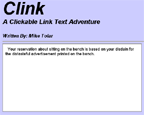
Hybrid Browser-Based Adventure Released
(Liberal, Kansas) - An entirely original browser-based adventure titled Clink is now available. As implied by the name, Clink utilizes a unique "clickable link" platform that merges an intriguing blend of interactive fiction with hypertext story elements to create a new adventure experience unlike any other on the market today.
The story line of Clink, which begins with you standing on your own front porch, is gradually revealed as players "literally" move around by clicking on words within the story. While there is a definite beginning, middle, and dramatic ending to the game, every person who plays Clink will have a unique experience because there is no pre-determined sequence of navigation. The story is constructed in a way to allow a smooth continuity of content, regardless of the order it is encountered.
Contrary to the fact that virtually all existing adventure games are written in a handful of specialized programs, Clink is an example of clever ingenuity over complex technology. Clink utilizes no special software, no Java, no Perl, no Active-X, no Flash objects, no applets, no scripts, and no cookies. In fact, Clink web pages are only about 2kb each and will run flawlessly on almost any web browser.
Mike Tolar, author and designer of the game notes, "Clink represents an exciting new genre of interactive browser-based content. Players will experience an intriguing mixture of humor, clever plot twists, and intuitive elements of logic and problem solving, all in a unique interactive web page environment. Anyone looking for something enjoyable to read, with an interactive twist, will quickly become a fan of Clink."
Direct questions or comments to: mike[at]clinkadventure.com
Posted by jo at 09:55 AM | Comments (0)
January 06, 2006
Perform Space

Performance, Performative, Performitivity
The research project Perform Space 2002/03 explored performative spatial structural phenomena of artistic works. The main result is a model which is intended for further use as a tool in art production and research. Built upon a basic notion and approach of phenomenological philosophy known as lived space, the model and its terminology were created through collecting and interpreting descriptions of artistic works of two art in public space projects. These descriptions were then used as the foundation for discovering underlying commonalities that mark the essential core of the processes and effects of contemporary artistic works. The aim is to use the model to develop a more highly differentiated sensibility for the presence and meaning of artistic works in the concrete lives and experiences of human beings.
Performance is generally defined as an enactment or occurrence over time which is experienced and measured against some standard [system/pattern] and according to specific criteria [presentation/framing].
Performance Art was initially proclaimed as its own medium in the 1960s and 1970s. Generally it is used to specify art works conceived and enacted by an artist using his or her own body, but is also used to describe works involving the participation of the viewer.
Performative refers to the operative and systematical aspect of something as an occurrence: something is not performative in itself, but rather becomes performative by being enacted and experienced within a specified framework. For example, in language, performative utterances are speech acts which complete the action they proclaim, as in "I promise to be there," or "I now pronounce you husband and wife." The action is fulfilled through being said ö and experienced ö by particular persons in a particular social context. Thereby, to speak of a performative artistic work means to claim that the process of being realized and experienced make something art, rather than, e.g., its object qualities.
Performativity refers to the necessary performative aspect of a condition, an event or object. For example, the performativity of gender means that gender is not given, but rather results through acts based on cultural norms of femininity and masculinity. Broadly considered, the performativity of art refers to the way art is created and maintained as a special field through acts based on cultural norms. For example, since Modernism a common notion is that art be new, as in the avant-garde which disrupted previous cultural practices and beliefs about art.
Posted by jo at 05:38 PM | Comments (0)
Microtel
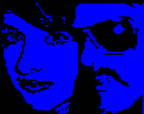
Send Your Teletext Now
Microtel is one of the projects curated by ambientTV.net as part of VBI [voluptuous blinking eye] - a submission for the exhibition Satellite of Love. This exhibition is presented by the 35th International Film Festival Rotterdam in association with Witte de With Center for Contemporary Art and the TENT Centre for Visual Arts. The exhibition runs from 26 January to 05 February 2006.
Until 04 February 2006, you will be able to create teletext and email it to Microtel for inclusion on its website, a DVD to be distributed by SCEEN magazine and most importantly broadcast on Netherlands TV station NOS. Check technical information for software downloads and FAQ's to contribute today! From 26 January to 05 February 2006, you will be able to visit the VBI Lounge and learn how to create teletext content. Check workshops for the schedule and see what other activities will be taking place in the VBI Lounge.
About Teletext: Teletext is a system which encodes extra information in analogue TV signals, where televisions with the right chip can decode and display special text and graphic pages. It uses the VBI part of the television broadcast signal. VBI stands for the Vertical Blanking Interval - the portion of the broadcast TV signal occupied by teletext and other data streams. The number of viewers to a page of teletext does not slow down the teletext system - unlike people visiting a webpage on the internet. Teletext originated in the UK in the 1970's. Today teletext services still offer a range of text-based information, usually including national, international and sporting news, weather and TV schedules.
Dragan Espenscheid from Bodenstandig 2000 created a piece called Teletext Babez featuring a collection of racy teletext advertisements for lonely hearts phone lines. jodi.org used teletext for Teletext.
Posted by jo at 03:09 PM | Comments (0)
Barcode Textiles

Ringtone Garments
Industrial designer Christopher Glaister and fashion designer Michelle Shakallis's barcode textiles (click on View Projects) are decorated by a pattern that translates a piece of music (When the Saints Go Marching In) into a barcode. The pattern can be turned back into real music or a ring tone by scanning it with a modified camera phone. The tune can then be used as the ringtone for that mobile phone.
Been looking for a link to that project for months, found it via a post on pixelsumo.
Other projects by Chr. Glaister: Communicating concrete and Olson, the independent camera. [blogged by Regine on we-make-money-not-art]
Posted by jo at 03:03 PM | Comments (0)
Shahram Entekhabi
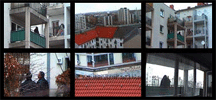
How to Perform Prayers
Fresh Azan (Quicktime), part of the installation "How to Perform Prayers," Videostills 3:04 min, colour/sound DVD/VHS – 2002/2003 (left)
The installation How to Perform Prayers--by Shahram Entekhabi--is composed of three videos, which show staged productions of existing religious rituals of the Islamic faith that differ by virtue of manipulations on the actual performing of these religious rites. The rituals presented here address the practicing of daily prayers, which Muslims are obliged to perform several times a day. Not only are these rituals compulsory for the entire Muslim world, they have remained unchanged for centuries. Through the use of disturbances, the work How to Perform Prayers pivots on the attempt to upset the collected rules of the religious canon and, in doing so, to also give weight, on a social level, to the idea of a rigidly-structured set of regulations being subject to change. All of the figures presented in the videos are women. In view of the Muslim theme this offers a new image since, in all hierarchically-structured world religions, women are discriminated against and dominated by a male-oriented image of the world – which, in itself, often encourages the Western world’s main criticism of the Islamic faith.
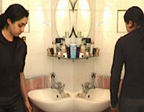
The video Wudu is based on a documentation of the cleansing ritual preceding prayer, enacted by a young woman in a household bathroom. The recorded material is doubled and assembled side by side in a way that divides the video image in two halves, thus showing two women. While on the image’s right side, the sequence of the cleansing ritual (three times the cleansing of the right then left hand, the elbows, the arms, the ears, the nostrils, the feet etc.) is faithfully captured, parallel to this, on the image’s left side, the entire sequence transpires in the reverse.
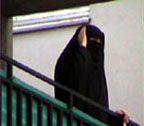
Azan is the Muslim call to prayer, cried several times a day by the muezzin of the minaret, beckoning believers to prayer in the mosque. The Azan is also used by devout Muslims when celebrating birth, in which case the call is whispered – as a rule, through a mullah – three times into the right and left ear. From that moment on, the newborn child belongs to the religious community. In the work Fresh Azan, a woman shrouded in a tschador appears on the balcony of a multistory apartment building, and sings a German-language version of the Azan. While her cries echo over the rooftops of the surrounding houses, catching the attention of passers-by, her call to prayer is accompanied by a male voice that whispers the Azan in Arabic.
Salath is actually the principal prayer of the Muslim world. It praises not only the glory of Allah, but also the absolute faith of believers and their allegiance to religious rules. Heard in the video is the voice of an old man of Iranian origin, the father of the one praying, reciting the prayer to his daughter. In the picture frame, one sees the young woman wearing the tschador kneeling on the prayer rug. She makes a great effort to repeat the Arabic words so foreign to her, and tries to assume the correct position with her body. Occasionally she interrupts the prayer and asks her father, in German now, to speak slower – or to repeat the words she finds hardest to remember. The woman’s actions oscillate between her allegiance to religious rules through sheer imitation and her rebelling against preordained rules of conduct, and the somewhat respectful tone used with her father belies her stifled laughter over the absurdity of the situation.

The video installation is supplemented by a Flash-generated animation entitled The Right Way To Pray, which, with explanations, leads through various instructional chapters on the underlying, prayer logic of the Islamic faith. Using the most advanced technologies, and a modern design, the viewer (at first an Internet user) is offered a comic-book-style and deliberately humorous, learning film. In combination with the videos, Sharahm Entekhabi once again interrupts, with this “ready made,” the rigid way of seeing, the so-called “western-oriented” gaze, directed Islamic culture. These works offer an unaccustomed and alternating glimpse at both the practice of daily prayers and the Muslim reality, but without falling prey to obsessive explanations. The artist playfully creates “counter images” which deliberately avoid exploring the exotic element in cultural differences; instead, these differences are questioned and presented here as unstable constructions.
Antje Weitzel, Berlin based curator
Posted by jo at 09:43 AM | Comments (0)
January 05, 2006
Feedtank Experiments
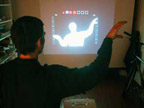
TransPose + VideoTank
TransPose (left) is an audiovisual performance instrument whose interface encourages dramatic movement. It was conceived to address the absence of physical human expression found in most electronic music based performances.
In TransPose, the performer's silhouette is projected in front of them along with noteboxes, which produce a sound when touched. The performer can change between instruments and record loops that can be turned on or off to create layered compositions.
Computer vision technology captures the performer’s physical actions captured and translates them to audio in real time. The performer sits in front of a camera, and his or her silhouette is projected in front of them in relation to a number of predefined trigger areas called “noteboxes.” Using his/her silhouette to overlap the noteboxes, the performer triggers various tones.
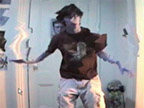
In rhythm mode, six different drum sounds are mapped to noteboxes which the performer can strike to play a beat. In the melody mode, two instruments are mapped to two elongated noteboxes on either side of the performer. The hand’s vertical positioning inside these noteboxes determines the tone’s pitch. Its horizontal positioning determines the tone’s volume. The performer can change between instruments and record loops that can be turned on or off to create layered compositions. [blogged by Regine on we-make-money-not-art]
VideoTank (above) places the participant in a reactive environment that emulates the sound and movement of liquid. The more movement that occurs, the more the VideoTank environment is agitated.
Posted by jo at 03:59 PM | Comments (0)
Abe & MO Sing the Blogs

Blogs as Time-Based Performances
Blogs, like the Blues, have been credited with channeling "the voice of the people," but do blogs adhere to any one set of characteristics that defines them as a genre? And how might blogs be understood as public spaces, in light of the time-based performances that take place there?
Selecting the postings that comprise the greatest "hits" of some of their favorite blogs, Abe Linkoln & Marisa Olson sing the blogs in order to address these questions. While Linkoln's posts speak to musical genres at large, Olson's posts seek to find harmony with specific models. Both question the status of the author's voice...
The whole "album" is presented as a form of reblog, in an effort to self-reflexively dive into the meme culture that is its subject. The artists' blog gets situated as the site of a happening, and their intention is to come back and continue depositing performative ephemera.
Linkoln & Olson frequently work in the blog format. Previous examples of their collaborative work include Universal Acid and Blog Art, and separate projects My Boyfriend Came Back from the War (Abe Linkoln's 2004 Blog Mix), Screenfull.net (Linkoln & Jimpunk), and Marisa's American Idol Audition Training Blog.
Posted by jo at 01:00 PM | Comments (0)
January 04, 2006
PING GENIUS LOCI
![]()
Pixels Sense the Presence of People
PING GENIUS LOCI is a programmable space installation, a new member in the induction house series, developed by aether architecture with Bengt Sjölén. Based largely on the research thread developed during the previous installations, version 4 tries to achieve the programmable matter aspect of the induction house series on a much larger scale, with more direct interaction scenarios.
We have developed self sustainable analogue pixels that work outdoors in the sunshine, using solar power and radio communication, and can sense the presence of people. We are now producing 400 of these sensor pixels to create a large interactive field, that functions both as a sensor field and a large outdoor screen. At the same time interaction scenarios, games and functions are being developed, to open up architecture to its use. [via [blogged by Regine on we-make-money-not-art]
Posted by jo at 02:11 PM | Comments (0)
Nicolas Bourriaud
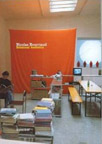
Relational Aesthetics Glossary
Academism: 1. An attitude that involves clinging to the defunct signs and forms of one's day and rendering these aesthetic; 2. synonum: pompous (pompier) -And why wouldn`t he do something pompous, if it pays off` (Samuel Beckett)
Aesthetics: An idea that sets humankind apart from other animal species. In the end of the day, burying the dead, laughter, and suicide are just the corollaries of a deep-seated hunch, that life is an aesthetic, ritualised, shaped form.
Art: 1. General term describing a set of objects presented as part of a narrative known as art history.This narrative draws up the critical genealogy and discusses the issues raised by these objects, by way of three sub-sets: painting,sculpture, architecture.
2. Nowadays, the word 'art' seems to be no more than a semantic leftover of this narrative, whose more accurate definition would read as follows: Art is an activity consisting in producing relationships with the world with the help of signs, forms, actions and objects.
Art (The end of): 'The end of art' only exists in an idealistic view of history. We can nevertheless, and not without irony, borrow Hegel`s formula whereby 'art, for us, is a thing of the past' and turn it into a figure of style: let us remain open to what is happening in the present, which invariably exceeds, a priori, our capacities of understanding.
Artist: When Benjamin Buchloh referred to the conceptual and minimal generation of the 1960`s, he defined the artist as a 'scholar-philosopher-craftsman' who hands society 'the objective results of his labour' . For Buchloh, this figure was heir to that of the artist as 'mediumic and transcendental subject' represented by Yves Klein, Lucio Fontana and Joseph Beuys. Recent developments in art merely modify Buchloh's hunch. Today's artist appears as an operator of signs, modelling production structures so as to provide significant doubles. An entrepeneur/politician/director. The most common denominator shared by all artists is that they show something. The act of showing suffices to define the artist, be it a representation or a designation.
Behaviour: 1. Beside those two established genres, the history of things and the history of forms, we still need to come up with a history of artistic behaviours. It would be naive to think that the history of art represents a whole capable of perennially replacing these three sub-groups. An artist's microbiography would point up the things he has achieved within his oeuvre.
2. Artist, producer of time. All totalitarian ideologies show a distinctive wish to control the time in which they exist. They replace the versatility of time invented by the individual by the fantasy of a central place where it might be possible to acquire the overall meaning of society. Totalitarianism systematically tries to set up a form of temporal motionlessness, and rendering the time in which it exits uniform and collective, a fantasy of eternity aimed first and foremost at standardising and monitoring patterns of behaviours. Foucault thus rightly stressed the fact that the art of living classed with 'all forms of fascism, be they already there or lurking '
Co-existence criterion: All works of art produce a model of sociability, which transposes reality or might be conveyed in it. So there is a question we are entitled to ask in front of any aesthetic production: 'Does this work permit me to enter into dialogue [ Could I exist, and how, in the space it defines?] A form is more or less democratic. May I simply remind you, for the record, that the forms produced by the art of totalitarian regimes are peremptory and closed in on themselves (particularly through their stress on symmetry). Otherwise put, they do not give the viewer a chance to complement them.
(see: Relational (aesthetics).
Context: In situ art is a form of artistic activity that encompasses the space in which it is on view. This consideration by the artist of the exhibition venue consisted, yesterday, in exploring its spatial and architectural configuration. A second possibility, prevalent in the art of the 1990s consists in an institutional structure, the socio-economic features encompassing it, and the people involved. This latter method calls for a great deal of subtlety : although such contextual studies have the merit of reminding us that the artistic doing does not drop out of the sky into a place unblemished by any ideology, it is nevertheless important to fit this investigation into a prospect that goes beyond the primary stage of sociology, It is not enough to extract, mechanically, the social characteristics of the place where you exhibit (the art centre, the city, the region, the country...) to ''reveal'' whatever it may be. For some artists who complicated thinking represents an architecture of meanings, no more nor less (Dan Asher, Daniel Buren, Jef Geys, Mark Dion) how many conceptual hacks are there who laboriously 'associate', for their show in Montelimar, nougat production and unemployment figures? The mistake lies in thinking that the sense of an aesthetic fact lies solely in the context.
2. Art after criticism: Once art 'overtook' philosophy (joseph Kosuth), it nowadays goes beyond critical philosophy, where conceptual art has helped to spread the viewpoint. Doubt can be cast over the stance of the 'critical' artist, when this position consists in judging the world as if he were excluded from it by divine grace, and played no part in it. This idealistic attitude can be contrasted with Lacanian intuition that the unconscious is its own analyst. And Marx's idea that explains that real criticism is the criticism of reality that exists through criticism itself. For there is no mental place where the artist might exclude himself from the world he represents.
Critical materialism: The world is made up of random encounters (Lucretius, Hobbes, Marx, Althusser). Art, too, is made of chaotic, chance meetings of signs and forms. Nowadays, it even creates spaces within which the encounter can occur. Present-day art does not present the outcome of a labour, it is the labour itself, or the labour-to-be.
Factitiousness: Art is not the world of suspended will (Schopenhauer), or of the disappearance of contingency (Sartre), but a space emptied of the factitious. It in no way clashes with authenticity (an absurd value where art is concerned) but replaces coherences, even phoney ones, with the illusory world of 'truth'. It is the bad lie that betrays the hack, who at best touching sincerity inevitably ends up as a forked tongue.
Form: Structural unity imitating a world. Artistic practice involves creating a form capable of "lasting", bringing heterogeneous units together on a coherent level, in order to create a relationship to the world.
Gesture: Movement of the body revealing a psychological state or designed to express an idea. Gesturality means the set of requisite operations introduced by the production of artworks, from their manufacture to the production of peripheral signs (actions, event, anecdotes)
Image: Making a work involves the invention of a process of presentation. In this kind of process, the image is an act.
Inhabiting: Having imagined architecture and art of the future, the artist is now proposing solutions for inhabiting them. The contemporary form of modernity is ecological,haunted by the occupancy of forms and the use of images.
Modern: The ideals of modernity have not vanished,they have been adapted. So "the total work of art" comes about today in its spectacular version, emptied of its teleological content. Our civilization makes up for the hyperspecialization of social functions by the progressive unity of leisure activities. It is thus possible to predict,without too much risk attaching thereto, that the aesthetic experience of the average late 20th century individual might roughly resemble what early 20th century avant-gardes imagined. Between the interactive video disk, the CD-Rom, ever more multi-media-oriented games consoles, and the extreme sophistication of mass recreational venues, discotheques and theme parks, we are heading towards the condensation of leisure in unifying forms. Towards a compact art. Once a CD-Rom and Cd-I drives are available. which have enough autonomy, books, exhibitions and films will be in competition with a form of expression that is at once more comprehensive and more thought-restricting, circulating writing, imagery and sound in new forms.
Operational realism: Presentation of the functional sphere in an aesthetic arrangement.The work proposes a functional model and not a maquette. In other words, the concept of dimension does not come into it, just as in the digital image whose proportions may vary dependng on the size of the screen, which unlike the frame, does not enclose works within a predetermined format, but rather renders virtuality material in x dimensions.
Ready-made: Artistic figure contemporary with the invention of film. The artist takes his camera-subjectivity into the real, defining himself as a cameraman: the museum plays the part of the film, he records. For the first time, with Duchamp, art no longer consists in translating the real with the help of signs, but in presenting this same real as it is (Duchamp, the Lumière brothers...
Relational Aesthetics: Aesthetic theory consisting in judging artworks on the basis of the inter-human relations which they represent, produce or prompt.(see co-existence criterion)
Relational (art): A set of artistic practices which take as their theoretical and practical point of departure the whole of human relations and their social context, rather than an independent and private space.
Semionaut: The contemporary artist is a semionaut, he invents trajectories between signs.
Society of extras: The society of the spectacle has been defined by Guy Debord as the historical moment when merchandise achieved 'the total occupation of social life ' , capital having reached 'such a degree of accumulation' that it was turned into imagery. Today , we are in the further stage of spectacular development: the individual has shifted from a passive and purely repetitive status to the minimum activity dictated to him by market forces. So television consumption is shrinking in favour of video games, thus the spectacular hierarchy encourages 'empty monads', i.e. programmeless models and politicians, thus everyone sees themselves summoned to be famous for fifteen minutes, using a TV game, street poll or new item as go-between. This is the reign of the 'Infamous Man' , whom Michel Foucault defined as the anonymous and 'ordinary' individual suddenly put in the glare of the media spotlights. Here we are summoned to turn into extras of the spectacle, having been regarded as its consumers. This switch can be historically explained: since the surrender of the Soviet bloc, there are no obstacles on capitalism's path to empire.It has a total hold of the social arena, so it can permit itself to stir individuals to frolic about in the free and open spaces that it has staked out. So, after the consumer society, we can see the dawning of the society of extras where the individual develops as a part-time stand-in for freedom, signer and sealer of the public place.
Style: The movement of a work, its trajectory 'The style of a thought is its movement' (Gilles Deleuze and Félix Guattari).
Trailer: Having been an event per se (classical painting), then the graphic recording of an event (the work of Jackson Pollock with photographic documents describing a performance or an action), today's work of art often assumes the role of a trailer for a forthcoming event, or an event that is put off forever.
From "Relational Aesthetics" by NB, published by "les Presses du Reel", Dijon, France. 2002 english version, 1998 french version. [blogged by robbin murphy at thing] See also From Relational Aesthetics by Nicolas Bourriaud (1998).
Posted by jo at 01:11 PM | Comments (0)
Objects That Blog
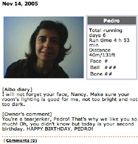
The Future of Content?
"The first few days of February I'll be at Lift, a content on the near future of technology, people and communication. Nicolas Nova and others have organized this conference, together with a workshop on Blogjects — a not particularly clever neologism I came up with for objects that blog. This topic ties into the idea of proximity-based interaction and usage scenarios for mobile contexts, the main theme of the NetMagnet research project I'm working on through the Netpublics seminar. An informed speculation I have is that the future of content creation and dissemination won't just come from people. It will also come from the social world of objects — things that have histories and experiences. A different kind of witness upon the world, and a witness to events that are of interest to the other blogging species — people.
Micro local content is one area in which this may be of practical concern. Just this afternoon I had a nice long meeting with Elizabeth Osder at Yahoo Media in Santa Monica. We discussed many things, including how to reward local communities for disseminating news about local sports events. I mean..really local sports events — the little league team scores, for instance. Now, this fits into a larger conversation about the news content ecology, but just taking this particular problem in hand in the context of the Blogject: why don't scoreboards blog? Sure, it's not a question deserving any measure of brilliance for the asking, but it suggests a (super simple) example of the Blogject.
Why are blogging objects interesting? The idea bubbled up as I was reading Bruce Sterling's "Shaping Things". The [w:Spime] — the "thing" in the world that knows itself and is able to tell things around it about itself. RFID is the Paleostine era for Spimes. Blogjects are Spimes that are fluent and legible, so that anyone can read them. Blogjects are meant for humans to read, in human code, not encrypted Arphid data. Blogjects are the prototype framework to experiment, DIY style, with what Spimes can become.
The current, upgraded brain of the Aibo blogs, for instance.
The motivation here is not just to create objects that blog, as we now understand blogging. But to use the framework of the complete blog social formation as one in which objects participate — first-class — in the entire multipath culture circulation network. That means syndication, layering meaning on content, trackback, etc.
There are several Blogject prototype projects on the front burner. One is a Sakura riff called flavonoid, turned around into a U.S. idiolect, focusing on the present day craze with Pedometers. Another is a way to turn device logs into material that's legible to humans. I've already gone on and on about FlightAware, but there are other idioms — for instance, Motion Based, a community-based mobile social software framework that slurps up device track logs and translates them into fitness goals and regimens." [blogged by Julian Bleecker on netPublics]
Posted by jo at 12:40 PM | Comments (0)
iNSTANT eGO

Intimate, Instantaneous, Nomadic Architecture
iNSTANT eGO is a concept dwelling that allows the emergence of intimate electronic space in the middle of the urban public space. Plugged to clothing, iNSTANT eGO is an inflatable cluster of intelligent tissue folded over, waiting to be unfolded.
The flexible space starts out like a hood in a raincoat and it can expand to swallow the user as a whole. Once s/he is inside, the user sees the confined space becoming infinite through the boundless realm of virtual reality projected onto the inner skin of the structure. The user can then travel into this infinite space by using electronic sensors that manipulate the projected images.
Created in 2000 by Hyoungjin Cho, Rémi Feghali, Adrien Raoul. Related: wearable architecture. [blogged by Regine on we-make-money-not-art]
Posted by jo at 10:58 AM | Comments (0)
January 03, 2006
PARK(ing)

Transform a Parking Spot into a PARK(ing) Space
PARK(ing) is an investigation into reprogramming a typical unit of private vehicular space by leasing a metered parking spot for public recreational activity. We identified a site in an area of downtown San Francisco that is underserved by public outdoor space and is in an ideal, sunny location between the hours of noon and 2 p.m. There we installed a small, temporary public park that provided nature, seating, and shade.
Our goal was to transform a parking spot into a PARK(ing) space, thereby temporarily expanding the public realm and improving the quality of urban human habitat, at least until the meter ran out. By our calculations, we provided an additional 24,000 square-foot-minutes of public open space that Wednesday afternoon. Build your own PARK(ing)! View our handy construction manual. [via Guerrilla Innovation]
Posted by jo at 07:13 PM | Comments (0)
Death and the Powers
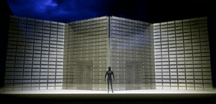
Hyperinstruments, Sonitronics, and Musical Propulsion
"...In the fall of next year the incredible-sounding opera Death and the Powers will go on, with music by Tod Machover (of the MIT Media Lab; The Brain Opera, Resurrection), libretto by Robert Pinsky (Mindwheel, The Figured Wheel, Jersey Rain, The Favorite Poem Project), robotics engineering by Cynthia Breazael (MIT Media Lab), and production design by Alex McDowell (Minority Report, Fight Club, The Crow)...(blogged by Nick on Grand Text Auto)
"...The music of Death and the Powers will represent a bold step forward towards a new kind of opera. Innovative vocal techniques will be designed especially for this work, especially for Simon who will virtuosically control extensions and manipulations of his own voice the way DJ’s spin turntables. Miranda (soprano), Evvy (mezzo soprano), and Nicholas (tenor) will sing in traditional fashion on stage, sometimes amplified, sometimes not. Simon (bass-baritone, with an unusually extended range and exceptional acting ability) will always be on stage, and will communicate directly as well as through The System. His "interludes" allow the audience to glimpse Simon’s changing inner state, and provide dramatic musical propulsion and musical continuity for the whole opera.
The vocal music will range from the lyrical, expressive singing of members of the Powers family, to the robotic bird that vocalizes during key moments of the opera, to the “voice” of Simon Powers – careening between speech and song, memory and immediacy, breath and bravura – that is at once expiring and transcendent.
The instrumentation for the opera calls for a small ensemble (ca.10 players: 5 strings, 3 winds, 1 percussion, 1 keyboard) located in the pit. Players will perform on specially designed, next-generation Hyperinstruments which will represent significant advances over our current ones, in gestural sophistication, beauty of sound, and simplicity of use. Unlike current electronic instruments, these new Hyperinstruments will allow each performer to control his/her precise sound mix and balance, with overall balance of instruments and voices being modulated by the conductor. Another innovative musical feature of the opera will be the first-ever use of sonic animatronics ("sonitronics"), or physical, sculptural elements in the pit and on stage which will be “performed” directly from the instrumental Hyperinstruments – the result will be a symphonic, kinetic jungle of percussive, wind, and vocal-like sonorities." From the Overview.
Posted by jo at 06:57 PM | Comments (0)
Controlling Music with DIY Interactive Gloves
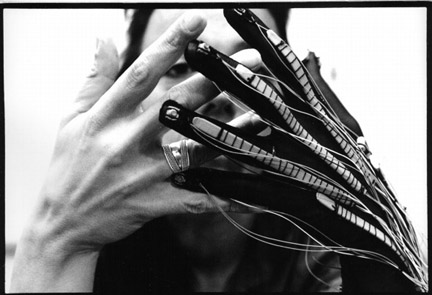
"Interactive artists and musicians have long experimented with sensor-packed gloves for controlling music, sound, and video. There's Laetitia Sonami, who controls Max/MSP with her Lady's Glove, and many other projects like the Hypersense Complex flex sensor glove-cum-gestural software as seen here this summer. Laetitia's glove is elegantly sculptural, as seen below, and with years of practice performing with it, she's built a whole performance practice around the glove as an instrument..." Continue reading Controlling Music with DIY Interactive Gloves by Peter Kirn, Create Digital Music.
Posted by jo at 02:17 PM | Comments (0)
Gameplay
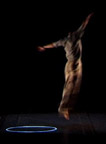
a ritual passage
Gameplay is an encounter between dance and programmed art: a ritual passage. Gameplay transposes the language and technology of video games to a choreographic environment where the dancer is confronted with challenges paralleling the notion of the physical test present in many rites of passage. Dance and the language of video games thus retrace common ground in a completely contemporary encounter.
The minimal visual language of Antoine Schmitt, author of the interactive levels, resonates with the tension of the choreographic writing of Jean-Marc Matos and Anne Holst in a staging where dance and the dancer find their raison d'être.
Antoine Schmitt has been exploring programming as an artistic material for more than 10 years, in a body of work that has been awarded internationally (including Unesco Video Danse 2003). The K. Danse company, composed of Jean-Marc Matos and Anne Holst, pioneers in the joint writing of choreography and technology (video and digital) for more than 15 years. Benjamin-Aliot Pagès trained in theatre, then in dance at the Rosella Hightower ESDC School and at the CDC, Toulouse, he has worked with many theatre directors and choreographers and also choreographs his own pieces.
Posted by jo at 02:07 PM | Comments (0)
January 02, 2006
Locative Networking

Non-Authoritarian Experiences
"...Arguably, locative media can offer an opportunity for the public, participatory and site-specific art of the last century to reinvent itself in the twenty-first and complete its project of critical revision. Mobile, location-sensitive devices, semantic mapping and biometrics are all locative and wearable tools that are being deployed in non-authoritarian ways on the street and in the body. Even the critics would agree that locative media art at its best enhances locative literacy and augments the ambiance of the physical places. It carries the ability to intervene on local level whether by creating an on-site experience about the place, transporting us to another site or choosing to abstract us from the location.
Using audio systems and GPS receivers both 1831 Riot!, an interactive play about Bristol Riots of 1831, and My Lodging and Some Others, a bus tour operated by international artists group e-Xplo around spooky, nocturnal Berlin, are pursuing similar artistic ends. Perhaps, locative networking will be the next quiet leap in driving wireless technology forward to reawaken our sense of geography, to annotate public space and challenge the ownership of the imperceptible electromagnetic zone around us." From Locative Networking by Iliyana Nedkova. [via pasta and vinegar]
Posted by jo at 04:46 PM | Comments (0)
Transforming Digital Architecture from Virtual to Neuro:

An Interview with Brian Massumi
"The introduction of digital techniques into architecture, and the preoccupation with the virtual that came with it, brought up some very old questions with a new intensity. The change came at a time when the idea of "virtual reality" was very current in popular culture and had a major presence in the mass media. "Virtual reality" was used as a synonym for "artificial reality." There was something of an apocalyptic tone to many commentaries, to the effect that the new generation of digital technology was creating a technological cocoon around human beings that would separate them from any direct access to the world, and would denature human relations.
...Digital techniques in architecture added a new twist that changed the terms in which this question could be asked. This is because the software put into use by innovative architects such as Greg Lynn was evolutionary rather than representational. Rather than using traditional CAD software, where basic geometrical forms are reproduced and then modified or rearranged, architects employed special effects software...So you begin by programming forces rather than forms...[B]ecause of the complexity of the system, you can't predict exactly what the outcome will be." -- Brian Massumi, Transforming Digital Architecture from Virtual to Neuro: An Interview with Brian Massumi by Thomas Markussen & Thomas Birch, Intelligent Agent, Vol 5 #2.
Posted by jo at 04:25 PM | Comments (0)
ICA £10,000 Commission

Live Re-Enactment Sought
The ICA wishes to commission a live re-enactment by an artist or artist's group from either visual, live practice or media arts background. Over the past 8 years the ICA has commissioned a number of seminal re-enactment performances from historic pop moments, e.g. Iain Forsyth and Jane Pollard's "Rock n' Roll Suicide" (25th Anniversary of the Farewell Ziggy Stardust Shows) to Rod Dickinson's "Jonestown" re-enactment (Jim Jones Sermons on the road to Gyana).
Submissions on a one page proposal outlining your career to date, proposal for the re-enactment and any specific practical considerations. This is a commission of £10,000.
Deadline for proposal submission - Friday 24th February 2006. Please send them to: Vivienne Gaskin, Director of Performing Arts and Digital Media ICA, The Mall, London, SW1Y 5AH.
Posted by jo at 03:36 PM | Comments (0)
Dot.City
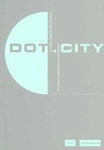
Relational Urbanism and New Media
This publication of the Fourth International Bauhaus Kolleg, a year long thematic graduate session run by the Bauhaus Dessau Foundation, offers strategies for employing digital media to integrate the unpredictable and the unplanned into urban existence. Dot.City asks and seeks to answer many questions: Can the use of information and communication technology counteract the continuous processes of devaluation, the loss of urban identity and the lack of multifunctional networks? Can the activation and implementation of new social techniques of knowledge production compensate for missing economical impulses and functions? How do such processes generate new species of urban values? Is it possible to re-program local social resources using intelligent network technologies? What do urban action areas designed for this purpose look like? And how can urban information spheres and physical urban spaces penetrate each other? Dot.City is edited by Torsten Blume and Gregor Langenbrinck. [via neural]
Posted by jo at 03:28 PM | Comments (0)
NetPD
![]()
Pure Data networked jam sessions
PD (acronym of Pure Data) has recently emerged amongst the many software devoted to real time sampling and audio/video streaming, mostly thanks to its flexibility during live performances. It's a real time coding environment suitable for video, audio and graphic editing. Roman Haefeli has developed an environment made for facilitating electronic musicians' jam sessions on a network basing on PD. It's a client-server system, so it works on any network (internet included), and its name, NetPD, derives from this feature. But this is not intended as a platform for creating sounds, but as an environment where every client (i.e. every computer connected to a NetPD server) can share its music patches. The most interesting part is that the same patches can be played through NetPD, and this implemented feature triggers the jam sessions, welcoming all the different contributions. A further peculiarity is that you can't share sound files (even if they are embedded in a patch). On one hand this makes samples sharing impossible, but on the other hand it handles the real innovative significance of the generative music. [Vito Campanelli, neural]
Posted by jo at 03:18 PM | Comments (0)
